
Welcome to our blog.

Welcome to our blog.
Want to get away for an unforgettable winter adventure trip that the whole family will enjoy? Head to Eastern Idaho. Located on the west side of the Teton Mountain range and just across the border of West Yellowstone is a spectacular area of Eastern Idaho dotted with endless forests, rivers, mountains, and wildlife. If you want to experience the magic of winter in a beautiful landscape, without the steep prices or the crowds of popular ski towns in the Rockies, Eastern Idaho is your place.
In a lot of ways, winter in Eastern Idaho is one of the best kept secrets in the U.S. Most people venture to the Wyoming side of the Tetons to ski at Jackson Hole or visit Grand Teton National Park and Yellowstone, however they are missing an unspoiled, less crowded, and equally as beautiful area that lies in Eastern Idaho. That’s why it makes for the best family winter trip in Eastern Idaho.
This post is sponsored by Visit Idaho, however all content and opinions are our own.
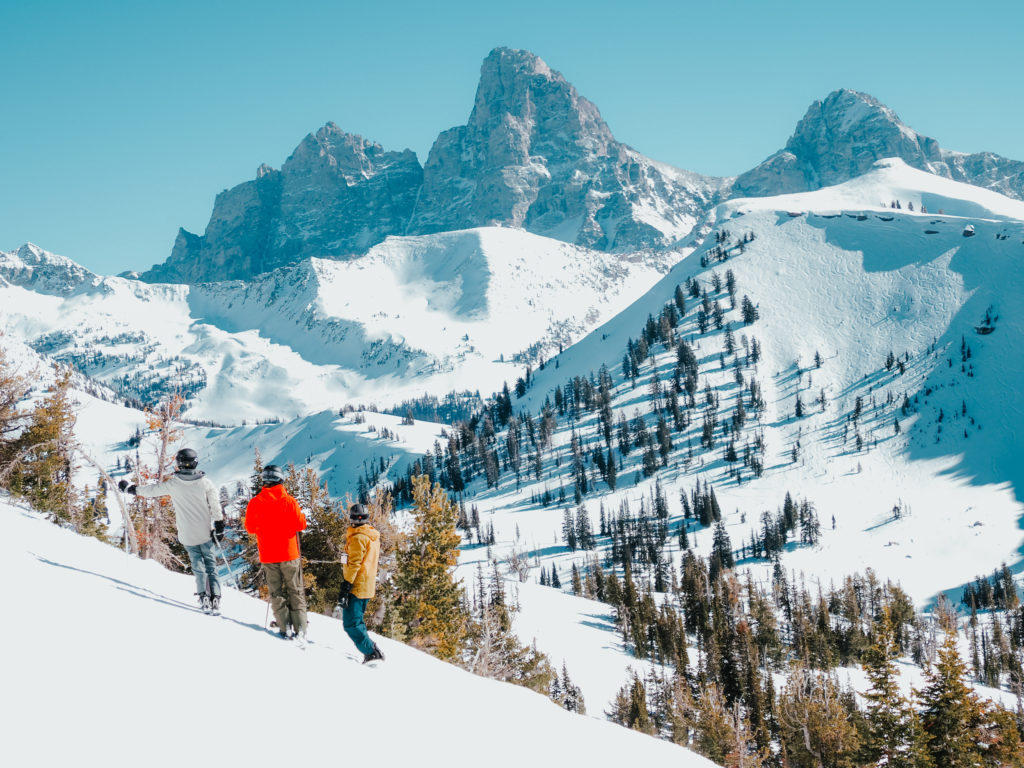
If you’re flying to Eastern Idaho, it is a bit of a challenge getting there. With no international airport close by, you have two main options–either fly to Idaho Falls (which might cost you a little more) or fly to Salt Lake City, Utah which is the nearest major airport. With this option, you will then need to rent a car and drive about 3 hours north to Eastern Idaho.
Either way, you will need a car to get around Eastern Idaho. Booking.com is a great website to find affordable rental cars, as well as lodging. I recommend booking a 4X4 in the winter since Eastern Idaho is known for receiving big snow storms often and the roads can be dicey without a four wheel drive.
Making Driggs your “home base” in Eastern Idaho is a good idea if you want easy access to skiing, as well as other winter activities in the vicinity. Driggs is a charming, small town only 30 minutes from Grand Targhee Ski Resort and less than 2 hours from West Yellowstone. With views of the back side of the Teton mountain range, plus a variety of lodging options and restaurants, Driggs is the perfect place to stay for the best family winter trip in Eastern Idaho.
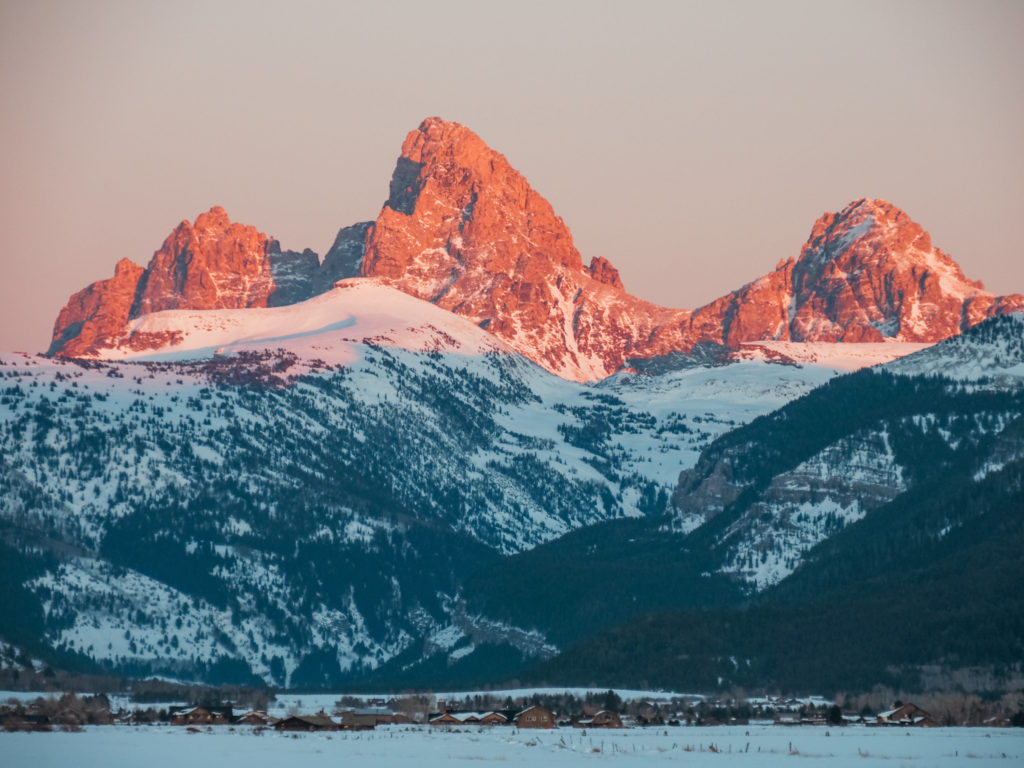
You might choose to stay in Island Park, which is about an hour from Driggs, if you want to be in a more rural area surrounded by forests, rivers, and wildlife. It’s a bit farther from skiing (about 1.5 hours), but you have access to many other outdoor activities here too, such as snowmobiling, ice fishing, nordic skiing and snowshoeing. Plus, you’re closer to West Yellowstone. So depending on what you prefer to do, Island Park is a great option too.
If you have at least 4 nights in Eastern Idaho, you could also split your time between Driggs and Island Park to get the best of both worlds. Both areas offer cabin rentals, so if you want to cozy up by a fire in a log cabin, renting via VRBO or Airbnb is the way to go. However there are also many lodges and hotels to fit your budget in both of these areas too.
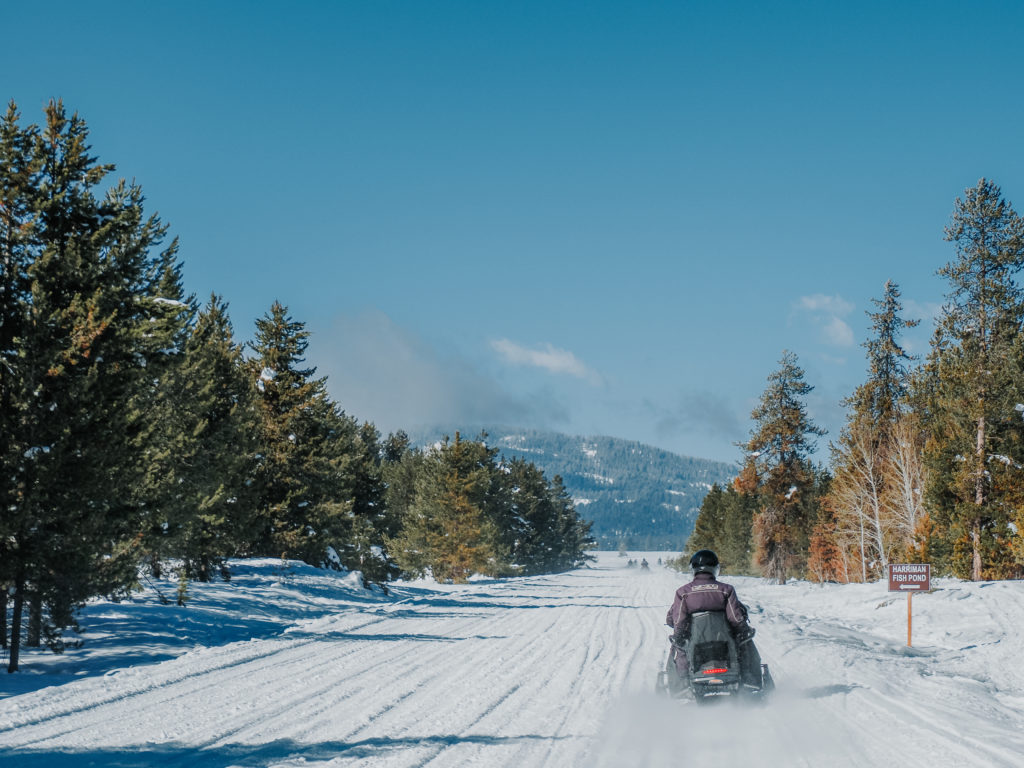
If you have at least a few days in Eastern Idaho, here is a guide for the best family winter trip in Eastern Idaho. This itinerary can be adjusted to your budget and interests, so there are also additional activities listed below. Or if you plan to stay longer than 4 days, you can use some of those suggestions. I recommend at least 3-4 days though because trust me, you won’t want to leave!
You can’t come to Idaho in the winter and not go downhill skiing. Idaho might not be as well known for skiing as the neighboring states in the Rocky Mountains, but it doesn’t mean that Idaho doesn’t offer world-class skiing. If you want to experience skiing deep powder and some of the most beautiful views of the Teton mountain range, without paying an arm and a leg (compared to nearby Jackson Hole or even Sun Valley), Grand Targhee is a must for the best family winter trip in Eastern Idaho.
Grand Targhee Ski Resort is technically located in Alta, Wyoming just over the border from Idaho, however Targhee is considered more of an Idaho destination due to lodging. Most people stay in Driggs, Idaho which has more options for different budgets (versus staying at the ski resort which is more expensive). Grand Targhee Ski Resort is a great ski resort for families with kids of all ages and also for beginner skiers.
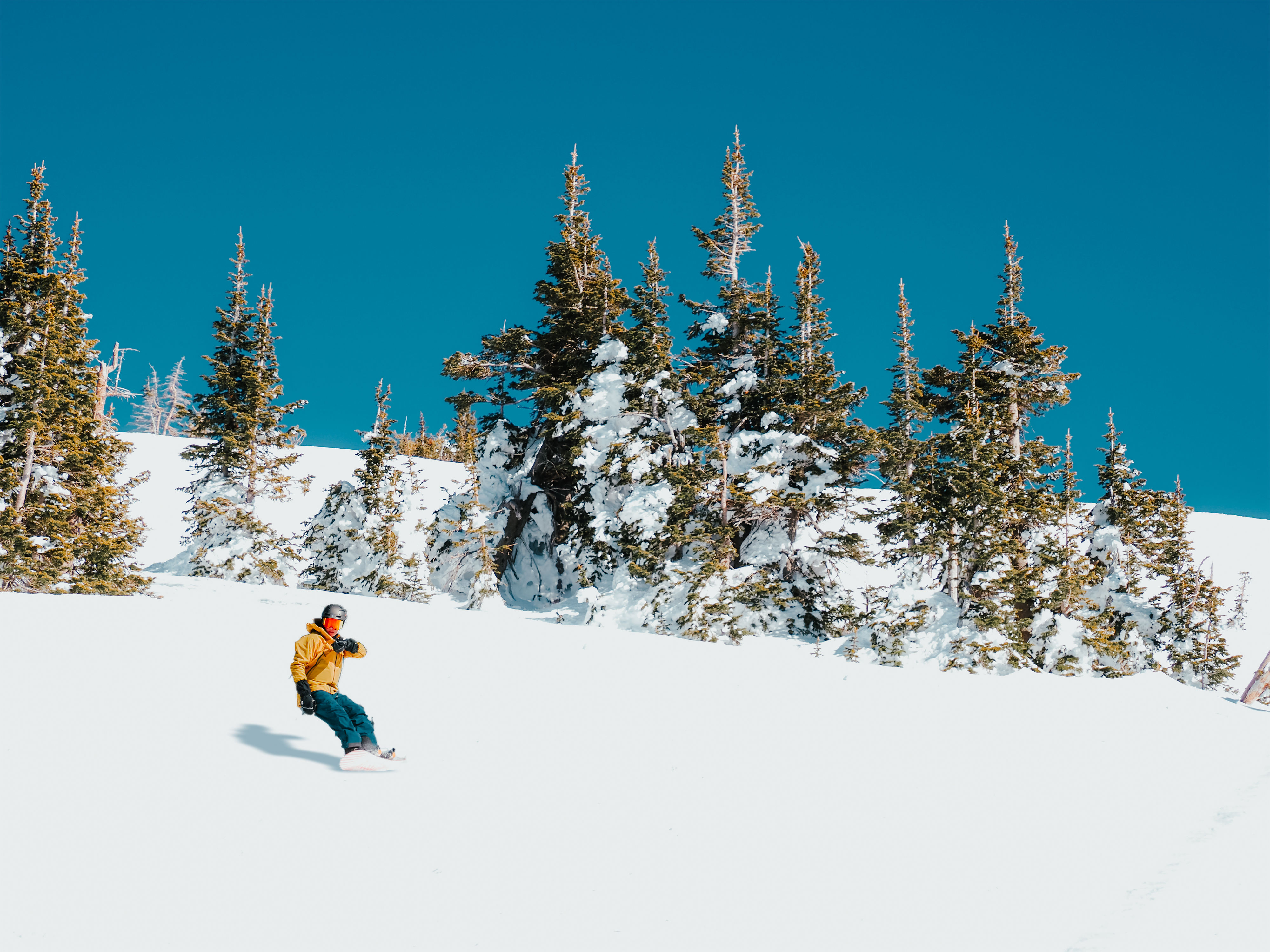
Targhee offers ski lessons for all abilities and ages, as well as rentals on equipment if you don’t own your own ski gear. In addition, Grand Targhee boasts terrain parks, awesome off-piste skiing (known for fluffy, light powder!), and breathtaking views of the Teton mountains. It truly is a sight to behold!
Grand Targhee also offers cat skiing, which is an experience of a lifetime–complete with 600 acres of untracked powder only accessible by “snowcat” machines. Imagine having the mountain to yourself for the day! You and nine other skiers and boarders will experience up to 18,000 vertical feet in just one day while you cruise through open bowls, endless glades, and steep tree pitches. *Please note that cat skiing at Grand Targhee is only for intermediate to advanced skiers and riders with off-piste experience.
If you aren’t into downhill skiing, Targhee also offers other activities such as snowshoeing, nordic skiing, and fat biking. Tours and equipment rentals are available at the shops in the village, but make sure to reserve ahead as there is limited supply. Come explore Targhee’s extensive nordic trail system and experience the magic of winter in a different way!
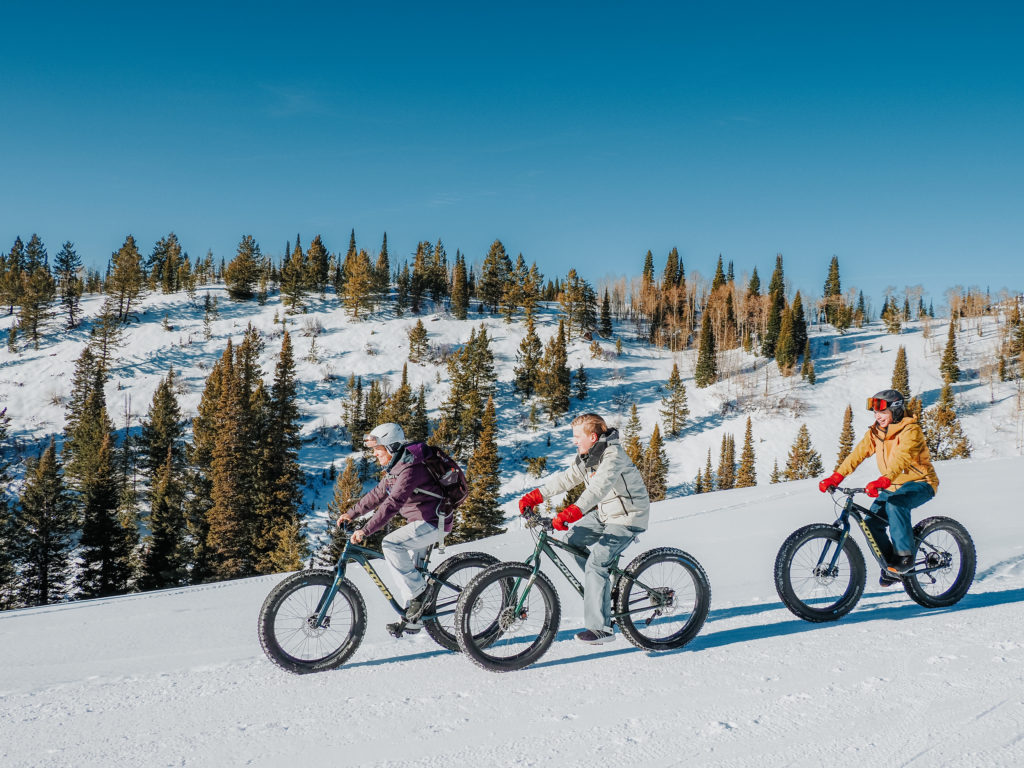
Snowmobiling is a very popular recreational activity in Idaho in the winter and Eastern Idaho has some of the best trails for off-roading adventures in the state! If you’ve never tried it before, you’re in for a treat! You can rent snow machines, however I recommend going on a guided tour with Teton Valley Adventures located in Driggs, Idaho. They offer several different options for full or half day tours, to include the Mesa Falls Snowmobile Tour. This is an all day adventure and perfect for families with older kids. It will surely be one of your favorite memories on the best family winter trip in Eastern Idaho!
This particular tour will take you approximately 50-60 miles through Island Park and to the breathtaking Mesa Falls. This waterfall is located in Targhee National Forest and only 15 miles from West Yellowstone, comprising of Upper and Lower Mesa Falls. Upper Mesa stands at 114 feet tall, while Lower Mesa is about 65 feet tall.
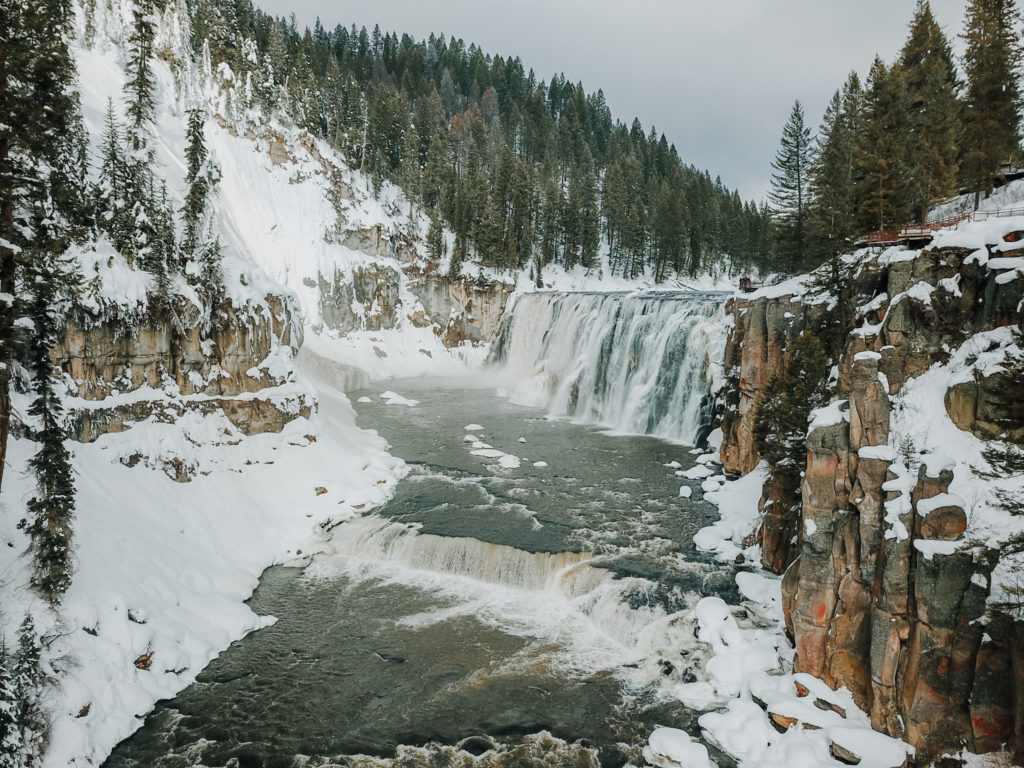
While these waterfalls are stunning all year long, they are particularly magical in the winter. No crowds and a frozen winter wonderland surrounding these falls, make this place a highlight along the snowmobile tour with Teton Valley Adventures.
Throughout the Mesa Falls snowmobile tour, you will also make stops at different landmarks in Island Park to include Big Springs, Warm Springs, and lunch along the river at Pond’s Inn. Enjoy a cup of hot cocoa and some delicious comfort food before heading back out on the trails. Some other important things to note about all tours with Teton Valley Adventures: you will be provided gear to include outerwear such as a jumpsuit, boots, helmet and gloves. The guide will also provide instructions on how to safely and properly operate and drive the snowmobiles.
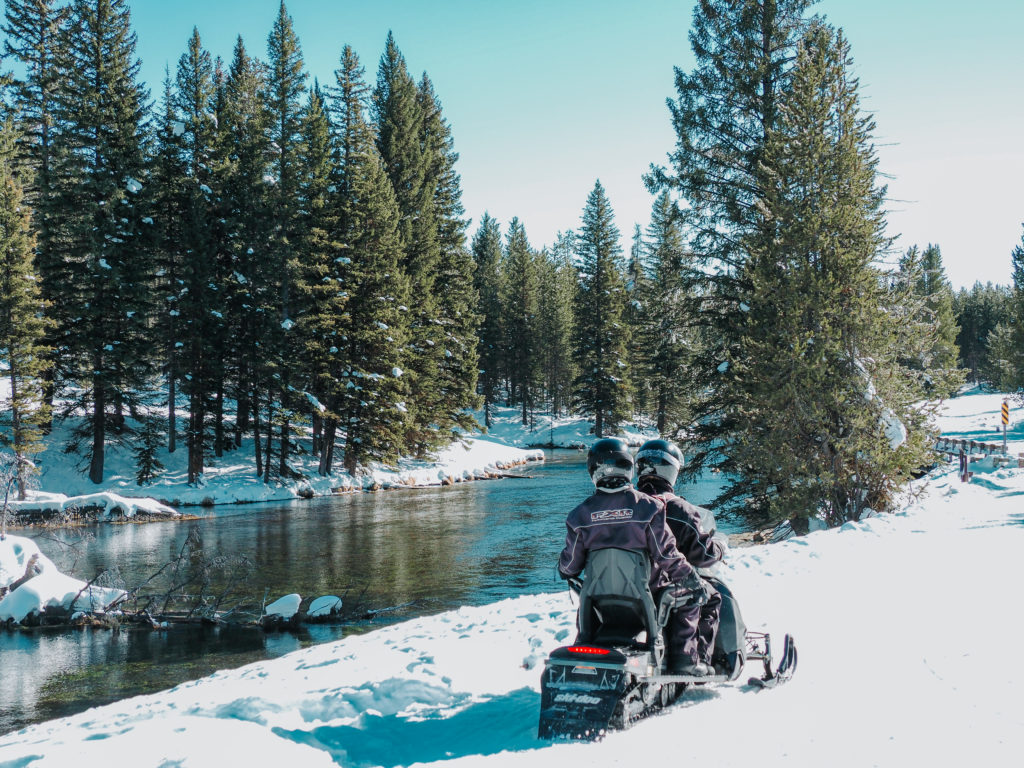
On the third day, it’s time to head to Harriman State Park, located just 15 minutes from the heart of Island Park, Idaho. Harriman State Park lies within a 16,000-acre wildlife refuge in the Greater Yellowstone Ecosystem and is known for its beautiful scenery. It should be on your list for the best family winter trip in Eastern Idaho. And if you love spotting wildlife, Harriman is one of the best places in Eastern Idaho to see moose, elk and Trumpeter swans. All of these species are common sightings here, even in winter.
There are over 20 miles of trails in Harriman State Park used for multiple purposes in all seasons, but in the Winter, you can come here and snowshoe, cross-country ski or fat bike. There are several trails that you can choose from with varying degrees of mileage and difficulty at HarrimanState Park. If you’re looking for any easy, short hike that you can do in two hours or less, check out the John Muir Trail, which is accessed right from the main parking lot near the park office.
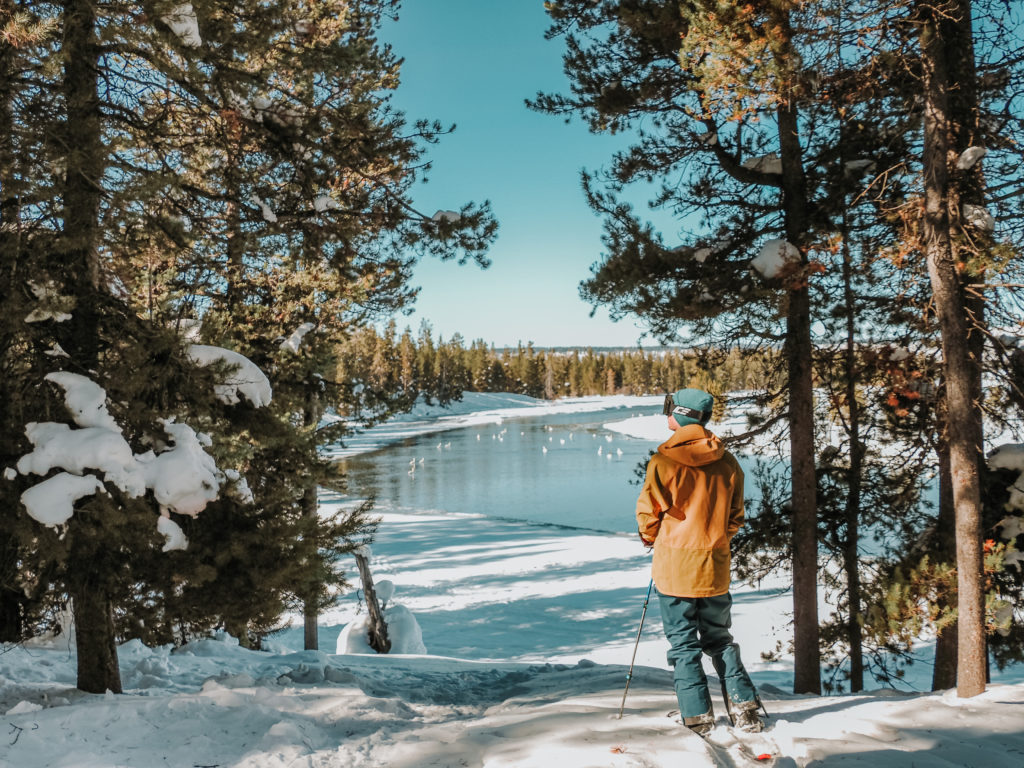
Other great shorter trails include: Ranch Loop, River Trail, and the Thurman Creek Inner Loop. These trails are less than 3 miles round trip, making it perfect for families. If you want a slightly longer trail, Harriman Ridge Trail Loop and Golden Lake Loop are good options and also offer stunning vistas. Check out All Trails for all the details, trail conditions, and to see photos.
A $7 vehicle entrance fee and a $5 per person fee is required when you arrive at Harriman State Park (the per person fee covers the grooming and upkeep of the trail system) at the ranger station. If you have an Idaho State Parks Passport, your entrance fee is waived. As a bonus, the fee or passport also covers a day trip to the nearby Upper Mesa Falls and Henry’s Lake! Lastly, snowshoe rentals are available in Henry’s Fork Anglers in Island Park, which is the closest rental shop to Harriman State Park.
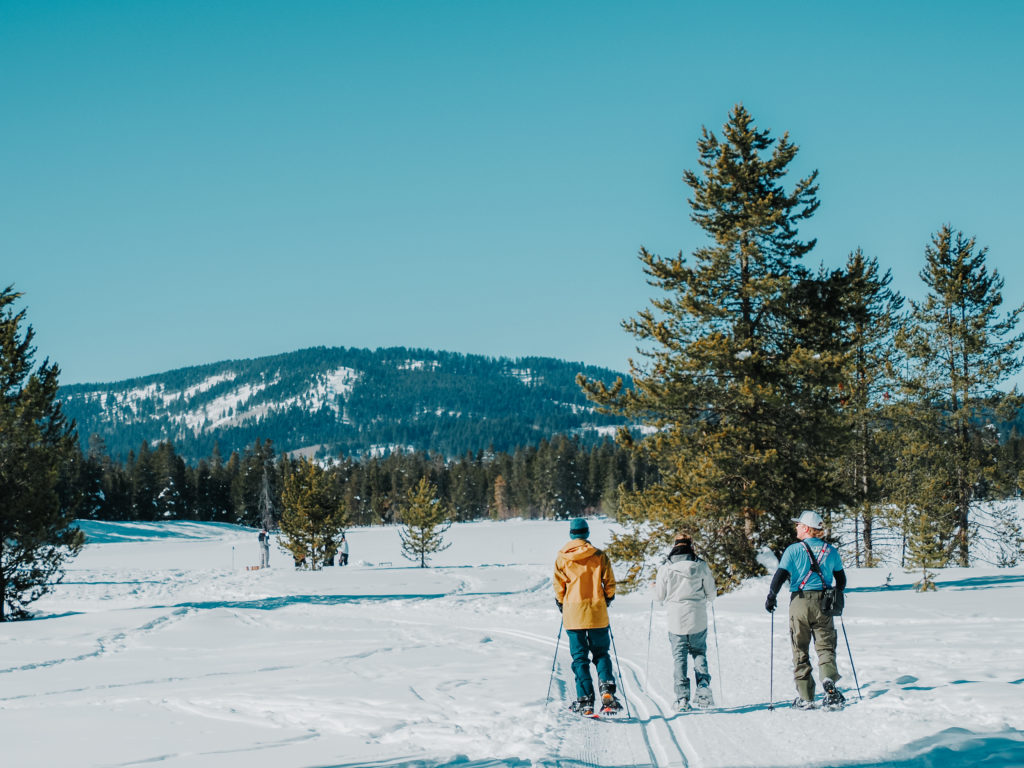
If you haven’t had your fill of skiing yet and want to try another ski resort in the area that has more of a “local vibe”, don’t miss Kelly Canyon Ski Resort, located only 30 minutes from Rexburg, in Ririe, Idaho. Known for their impeccable grooming system, uncrowded trails and lifts, and homestyle cooked food, Kelly Canyon is full of hidden gems. It is also one of the best ski resorts in Idaho to learn how to ski or snowboard, and even boasts a terrain park.
What makes this ski resort even better is it’s more affordable than most ski resorts. For less than $70/day for adults and $45 for kids, you can ski all day here and get your money’s worth. Kelly Canyon also offers ski lessons complete with a “magic carpet”, and even has night skiing!
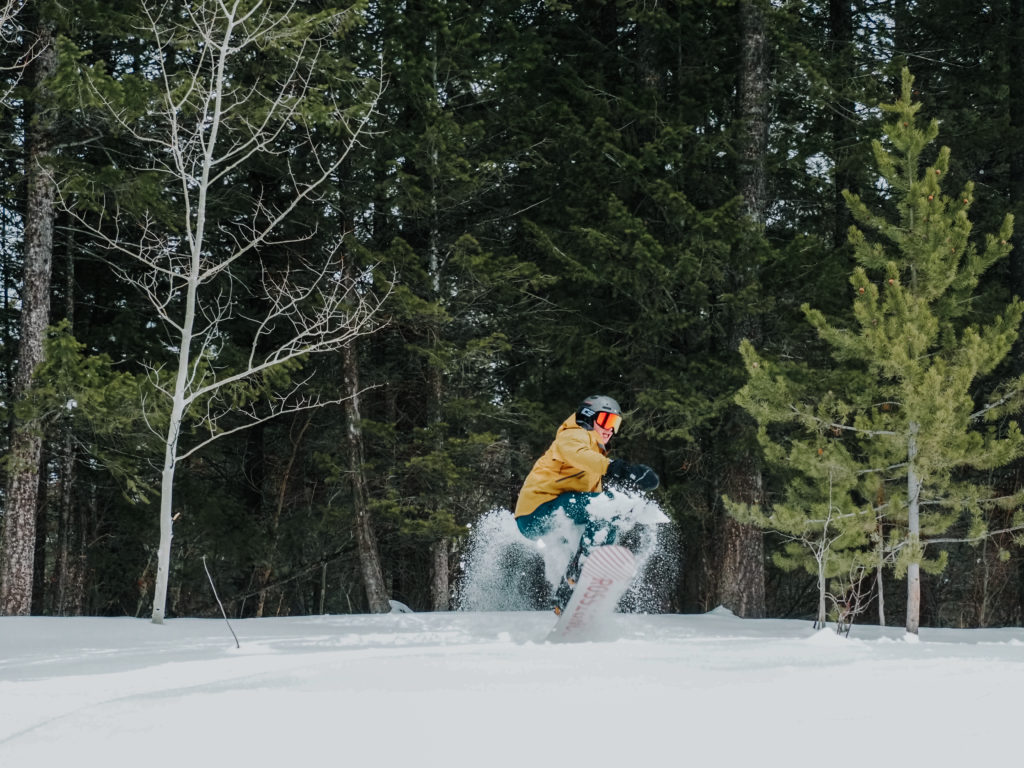
If you have more time in Eastern Idaho or want to opt for different activities listed on this guide, below are a few more winter activities that you can add onto your itinerary for best family winter trip in Eastern Idaho.
Dog sledding is hands-down one of the best winter activities for families. This is an easy, fun activity that all ages can enjoy and a great way to experience winter in Eastern Idaho. Silver Sage Mushing located in Ashton, Idaho offers dog sledding tours through the Teton Valley. The company offers 3 different tour packages for short, medium, and long trips, so you can choose the one that suits you best. This is one experience you will never forget!
If you want to experience Yellowstone without big crowds, winter is the time to go. Some activities that you can do here in the winter include: snowmobiling, riding on a snow coach, nordic skiing or snowshoeing on one of many trails in the park, visiting the Grizzly and Wolf Discovery Center, sledding, soaking in the hot springs at Boiling River, or just driving through the park stopping at different landmarks (such as Mammoth Springs, Old Faithful, Grand Prismatic, etc).
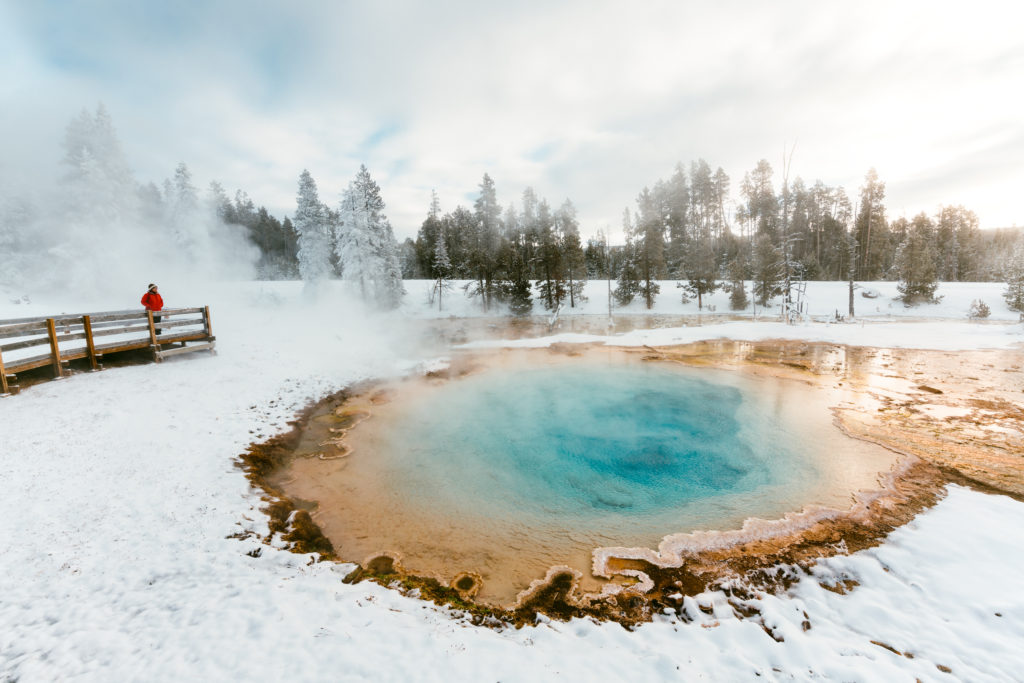
You will likely see plenty of wildlife such as bison, elk, moose, and if you are lucky, bears or wolves. Yellowstone Safari Company offers guided tours where you are guaranteed to see a plethora of wildlife, plus learn more about the history of Yellowstone and the ecosystem here.
If you’re in Eastern Idaho in the winter, you are close to some of the best fishing lakes and streams in the entire country. Henry’s Lake, located 15 miles from West Yellowstone, is probably the best ice-fishing spot in all of Idaho brimming with big cutthroats, rainbow-cutthroat hybrids and trophy brook trout.
Anglers can fish with minimal equipment and can access the lake easily by foot or snow machine from various public access points around the lake. It’s also a great experience for the whole family to get out and try their luck at some trophy-sized trout. At Henry’s Fork Anglers, you can hire an experienced fishing guide to take you.
Eastern Idaho is known for some of the best mountain and fat biking trails. It is a great winter activity that the whole family can enjoy! Grand Targhee Ski Resort, Harriman State Park, Horseshoe Canyon, Packsaddle Road, Teton Canyon, and Darby Canyon all have trails that people take their fat bikes on. You can rent bikes at Targhee, Kelly Canyon, BYU-Idaho Outdoor Resource Center and Fitzgerald’s Bicycles in Victor, Idaho.
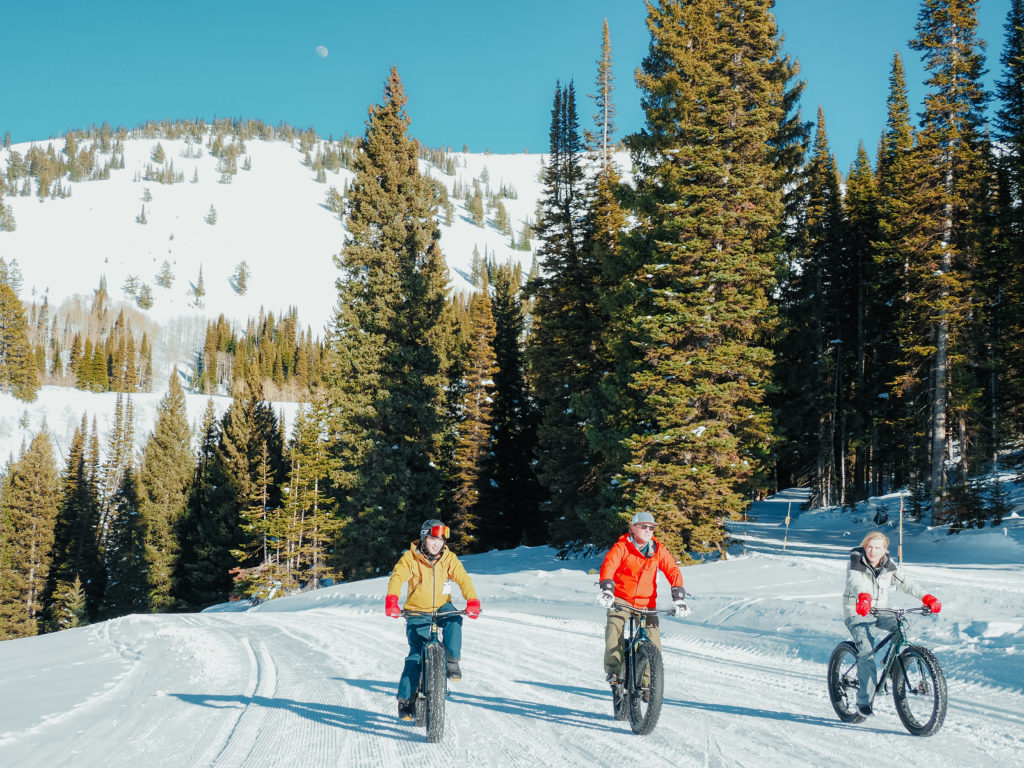
If you’re planning a trip and want more suggestions for the best family winter trip in Eastern Idaho, make sure to check out Visit Idaho for more fun ideas, hidden gems, and itineraries for your winter vacation.
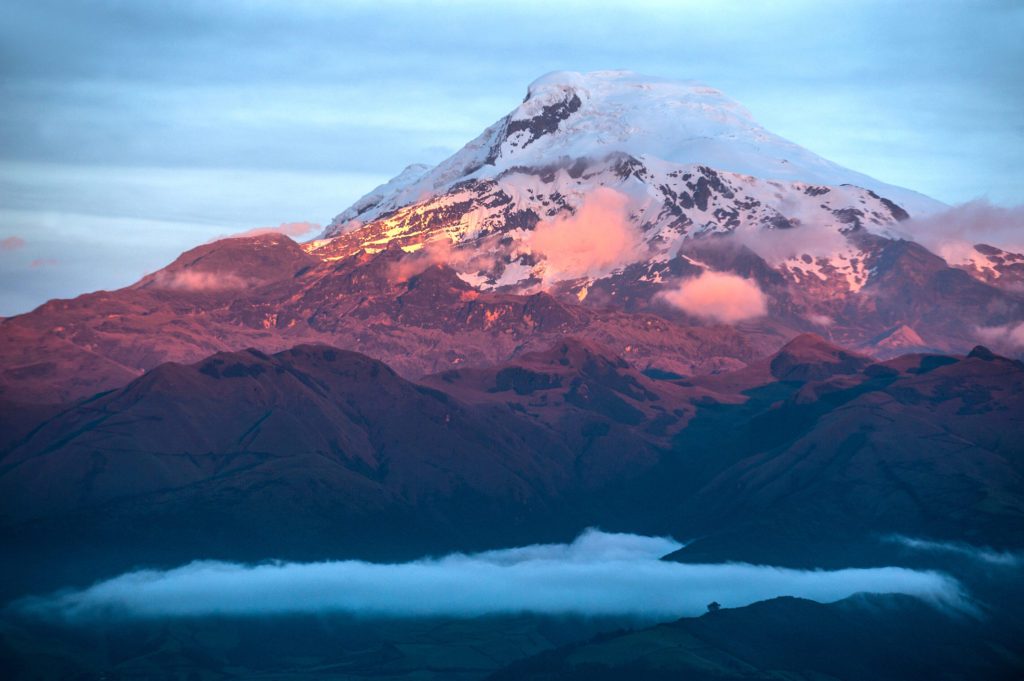
For such a small country, Ecuador packs a powerful punch. At only 110,000 square miles, Ecuador is one the smallest countries in South America, however what it lacks in size it makes up for in incredible diversity. There are few places on the planet that are as diverse in landscape as Ecuador. Here you can drive from the tropical regions of the coast, to the high altitude mountains of the Andes, to the jungle of the Amazon in ONE day if you wanted to. In addition, you can visit the famous Galapagos Islands which feels like an entirely different universe.
We loved Ecuador so much we put together the best 2 week Ecuador itinerary that covers a little of everything–the Andes, the jungle, and of course, the amazing Galapagos.
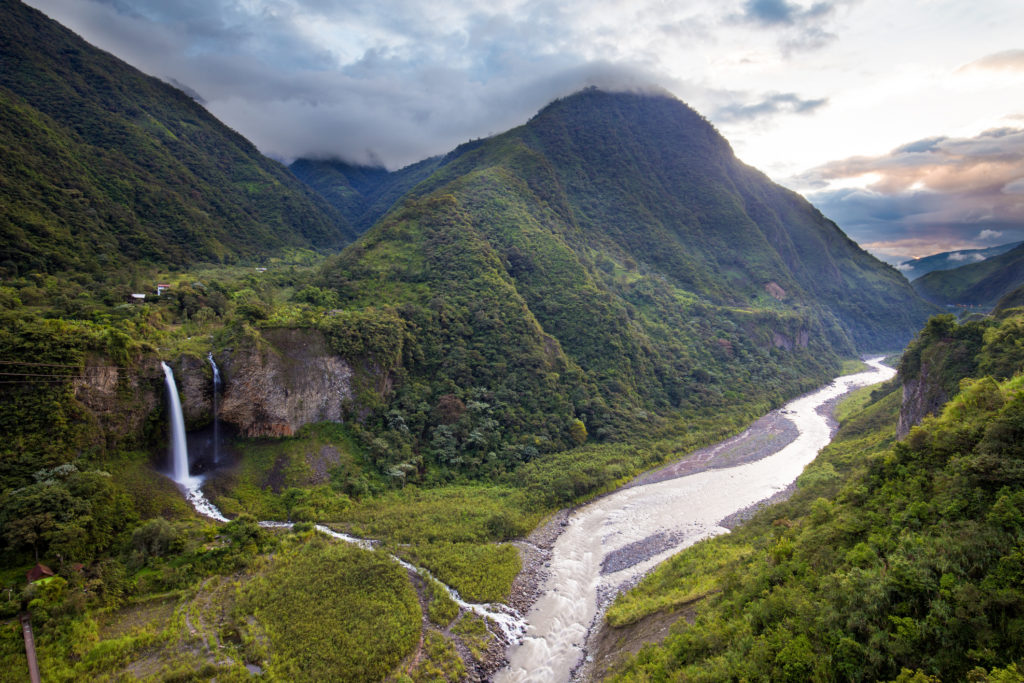
You might think because Ecuador is a small country, what can you possibly do for 14 days? Let me tell you, it was VERY challenging to narrow down where to go in 2 weeks (we spent 4.5 months here)! However, if you’re like us and want to experience the most adventurous destinations and witness epic scenery, we’ve put together the best 2 week Ecuador itinerary that combines both.
This 2 week itinerary will start in Quito, where you will spend 2 days visiting some of the highlights of this beautiful city nestled in the Andes, before heading south to take in the views of the breathtaking Cotopaxi volcano and the Quilotoa crater. After a few days in the Andes, you will make your way to Banos, the adventure capitol of Ecuador. Here you will witness waterfalls galore and participate in adventure sports like whitewater rafting and canyoneering. From there, you will head to the final destination in Ecuador: the Galapagos Islands, where you will sail in a boat to different islands and witness wildlife and nature like you’ve never seen before.
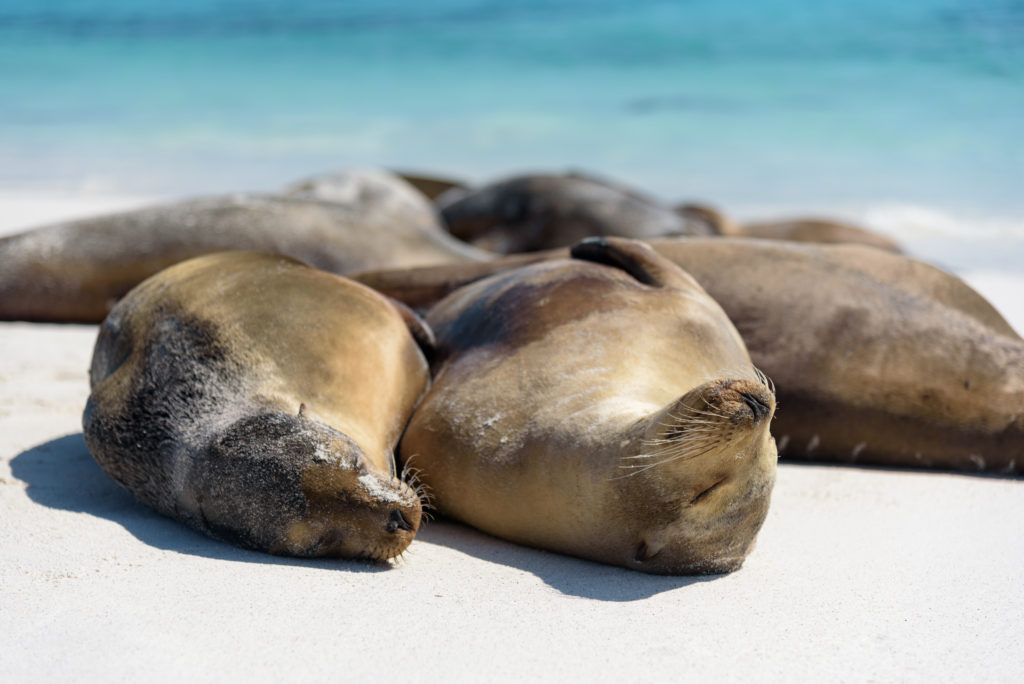
Quito is one of two major international airports in Ecuador, and a great access point to many destinations in the country such as the Amazon basin. You should also know that Quito sits in the foothills of the Andes at 10,000 feet (2,800 meters), so if you’re not used to high altitude, come prepared. The best thing to do to prevent altitude sickness is to drink a lot of water, get plenty of sleep, don’t do anything too strenuous the first couple of days, and to bring some altitude sickness medication with you just in case.
Constructed on the foundations of an ancient Incan city, Quito is known for its well-preserved colonial center, rich with 16th- and 17th-century churches and other structures blending European, Moorish and indigenous styles together. It is a beautiful city to spend a week here, however if you only have a couple of days in Quito, you want to spend it wisely.
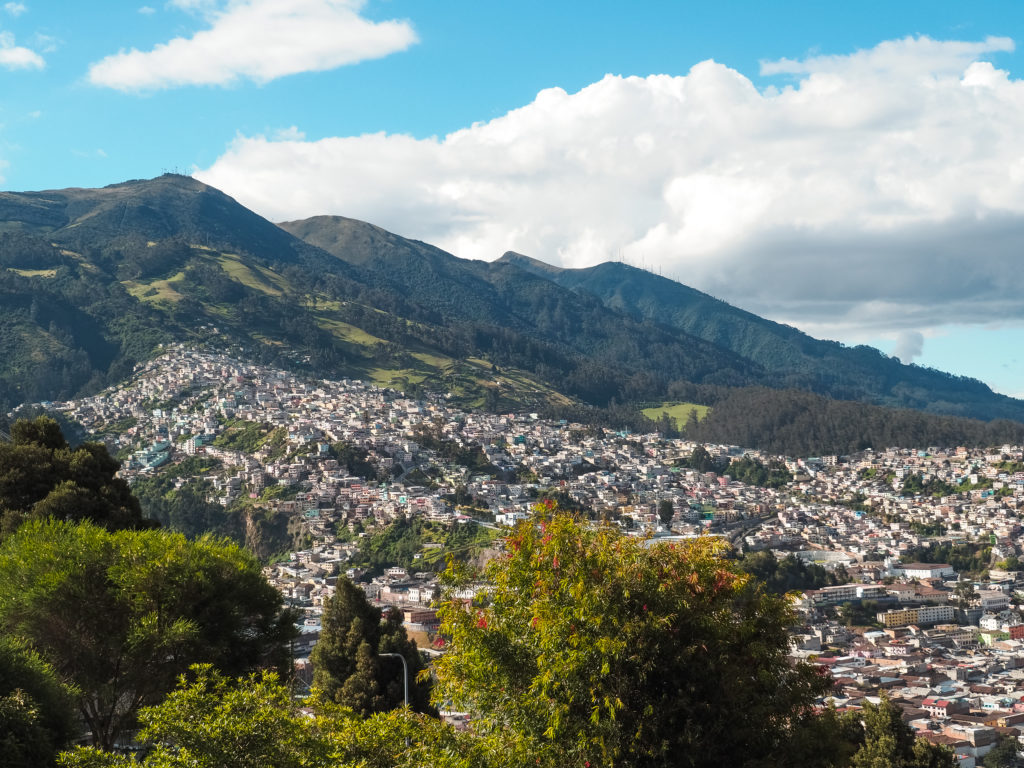
If you plan on staying somewhere in the Old Town, La Mariscal, or La Floresta area (which we would recommend), you should be able to explore Quito on your own, mostly on foot or by Uber. We loved staying right in the historic area at Chakana Boutique Hotel–super charming! Here is a great list of hotels for families in Quito.
There are quite a few noteworthy places that you should definitely try to squeeze in if you only have 48 hours in Quito. Declared a World Heritage Site by UNESCO for its well-preserved historical center, beautiful colonial architecture, and many incredible churches, Old Town is a place where you could easily spend a few hours.
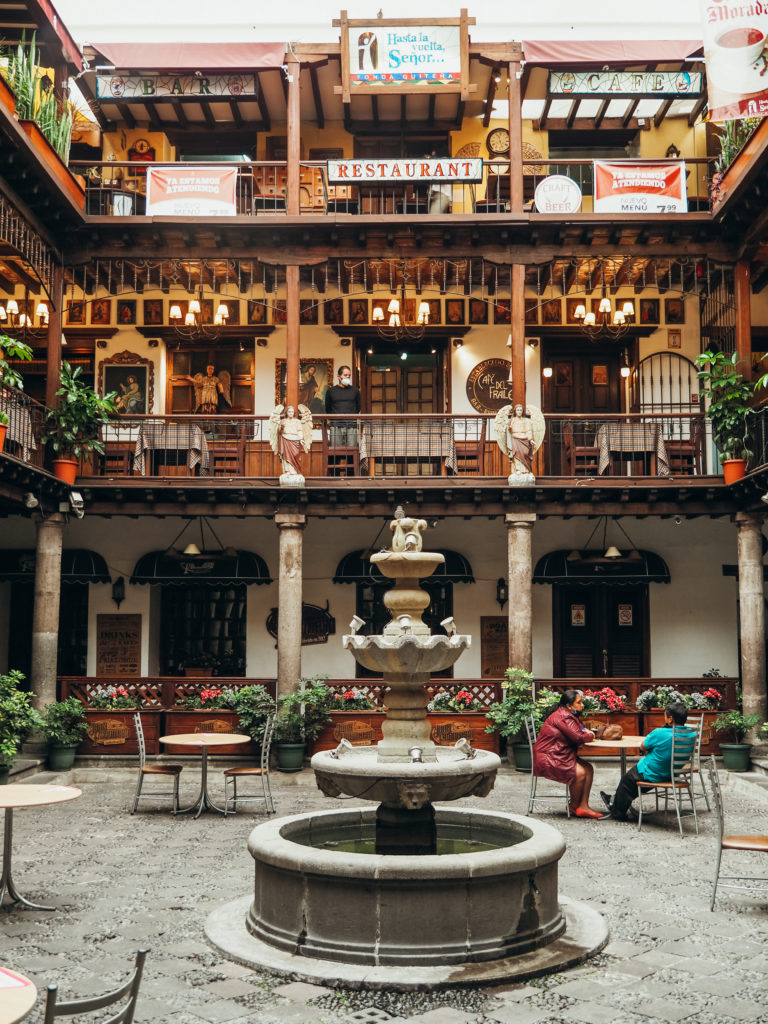
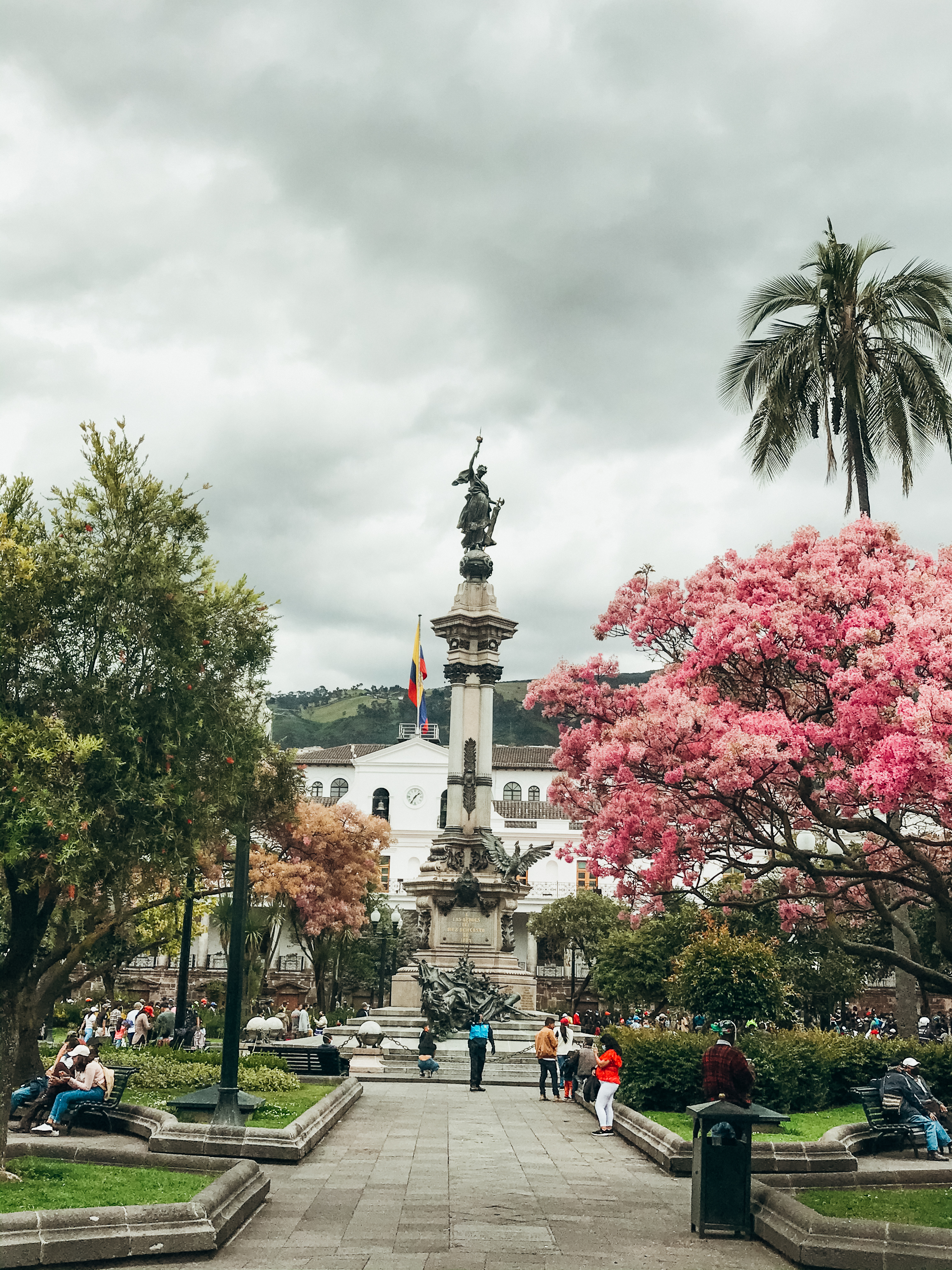
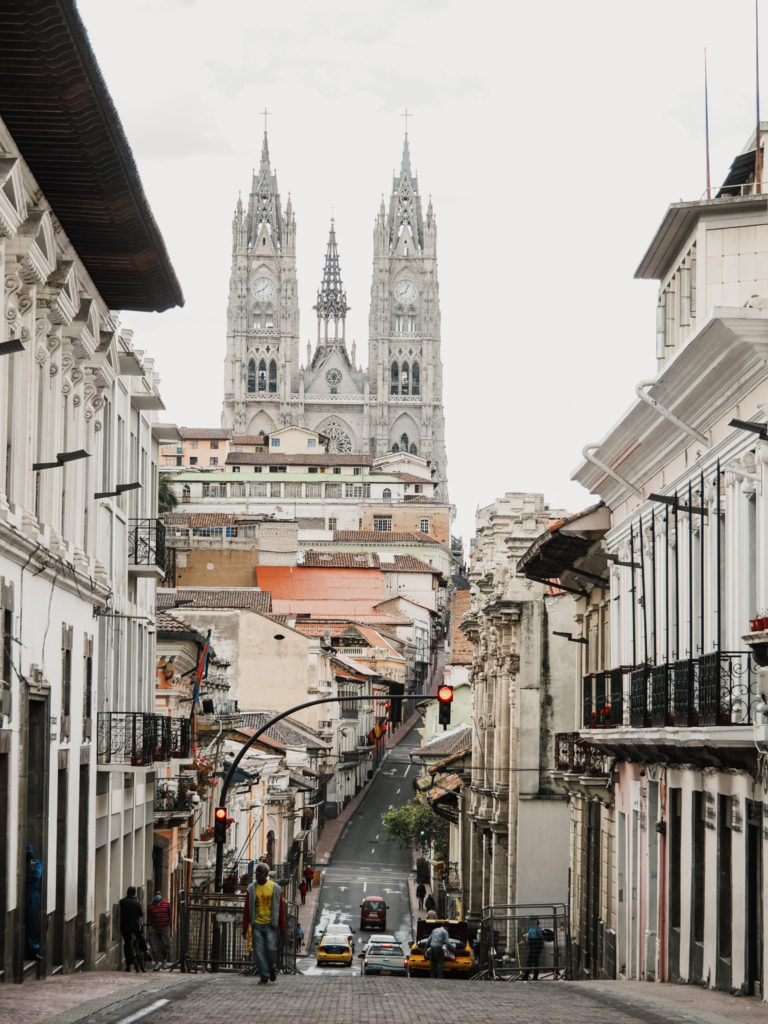
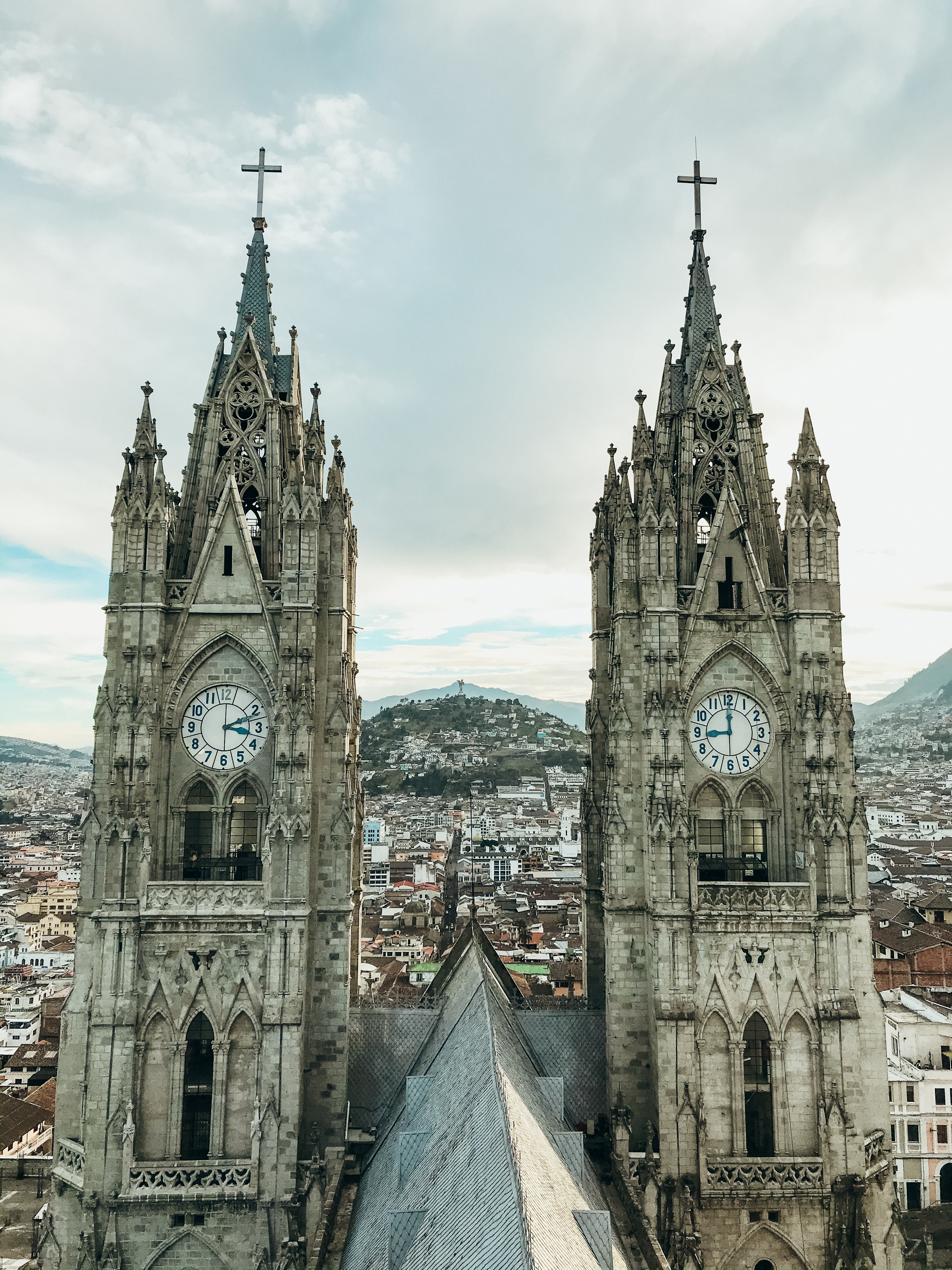
Start at Plaza Grande, also known as Independence Square and wander through all the cobblestone streets lined with cute shops and cafes. Don’t miss the gold church, La Compania de Jesus, and one of Quito’s most notable squares, Plaza San Francisco, where also stands the Roman Catholic San Francisco Church. So many beautiful churches and buildings!
If you’re going to visit any churches, Basilica del Voto Nacional should be at the top of your list. It is the largest neo-Gothic basilica in all of the Americas, and can be seen from any vantage point in downtown Quito. Don’t miss climbing to the top of the tower as the views are out of this world! If you have a fear of heights, the stairs are a little steep, however it’s worth it!
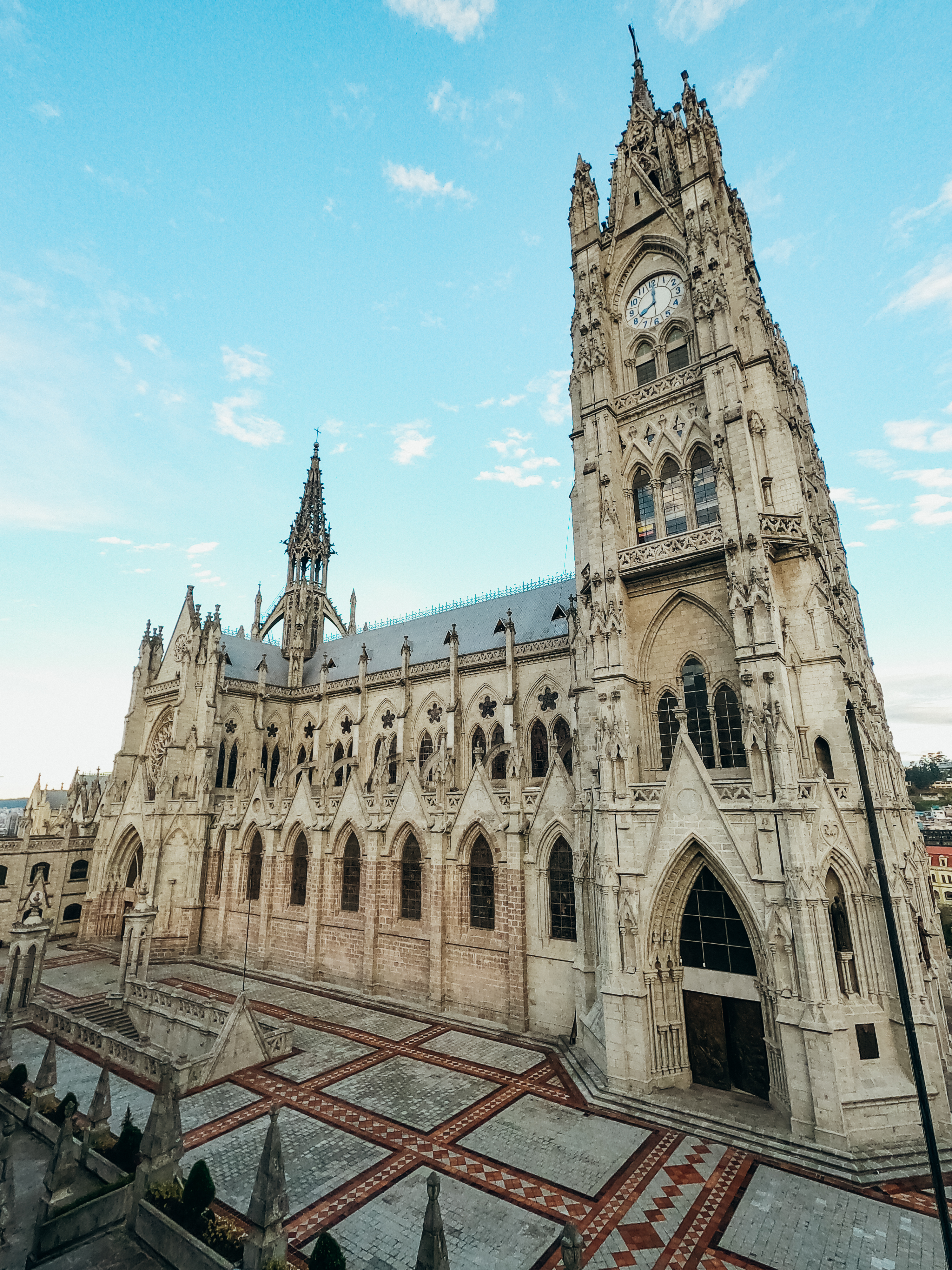
Another must-do in Quito is ride the TeleferiQo, which is a cable car that takes you up the east side of the Pichincha Volcano. Here you will get views of the entire city and other volcanoes in the nearby surroundings. If you want, you can also take a hike to Rucu Pichincha or just enjoy the views and ride the swing. This would be a great place to go for sunset!
Some other places worth visiting over 2 days in Quito is Mitad del Mundo, which is a museum and monument that sits on the equator. It’s about a 45 minute drive north of Quito, and you will want to spend a couple of hours here. At the center of the Mitad del Mundo stands the centerpiece of the park: a 30m-high, stone trapezoidal monument topped by a brass globe containing a viewing platform and a museum, which provides a good introduction to the indigenous peoples of Ecuador in the 4 different regions of the country.
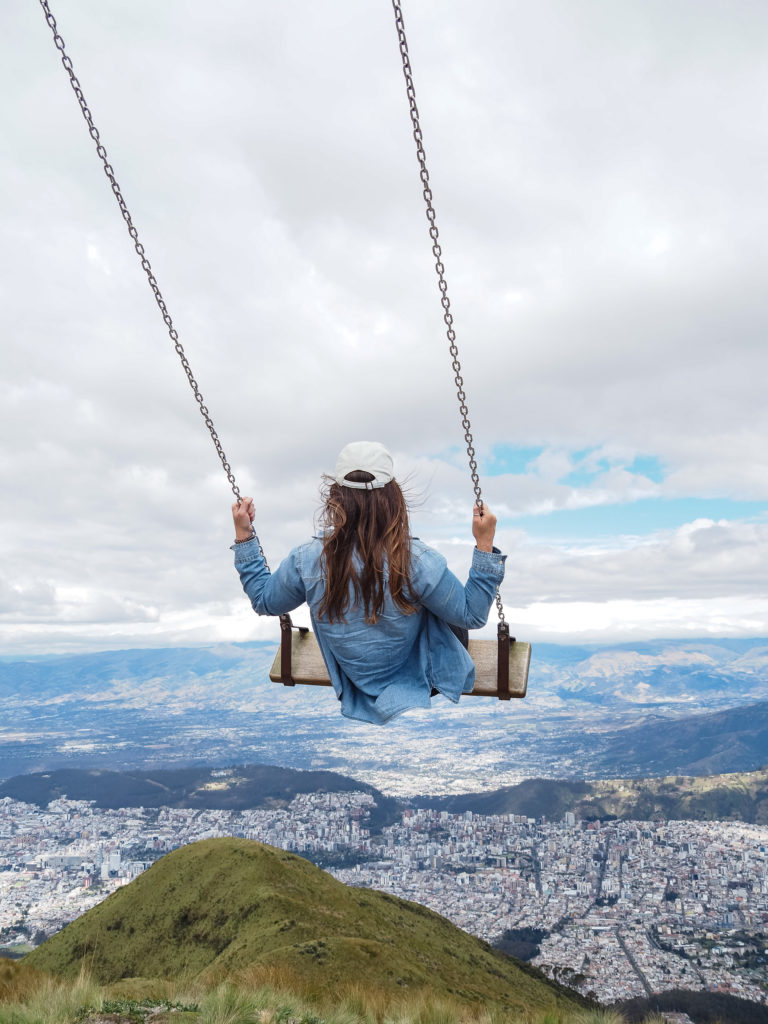
Not too far from Quito is Cotopaxi National Park which boasts one of the most famous and active volcanoes in all of South America. Cotopaxi is an active stratovolcano in the Andes Mountains, located about 50 km south of Quito. It is the second highest summit in Ecuador, reaching a height of 19,300 feet (5,897 m). Technically you could take a day trip from Quito to Cotopaxi, but we recommend spending 2 nights closer to the park.
We would also suggest renting a car in Quito for the next several days since it will make getting around easier and faster than relying on public transportation. Plus, you will need a car to get to Banos, which is where you will spend days 5-7 before flying to the Galapagos.
We stayed at Hosteria Papagayo in Machachi and absolutely loved it! It’s a sustainable hotel and farm tucked in the foothills overlooking the surrounding mountains (to include Cotopaxi!). We especially loved all the animals which are very kid-friendly. They had horses, llamas, dogs, goats, rabbits. In addition to activities they offer at the hosteria such as horseback riding, mountain biking, tree climbing, and yoga. They can also arrange tours to places like Cotopaxi and Quilotoa.
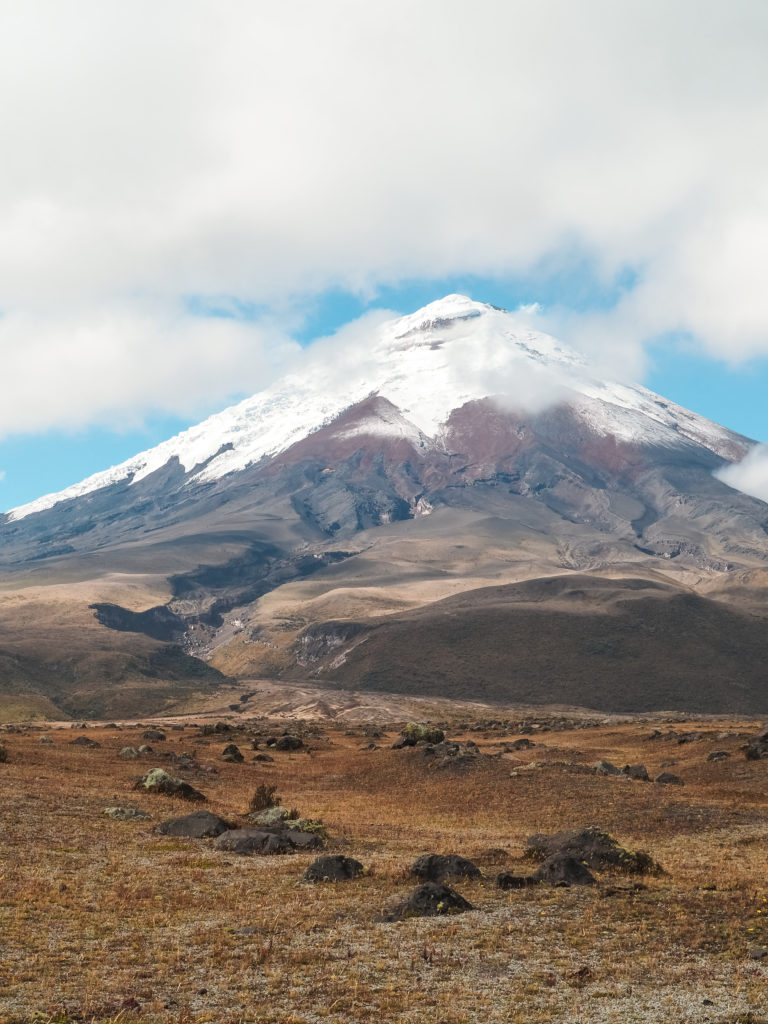
Here are some more lodging options in Machachi to suit your budget and needs, or if you want to be close to Cotopaxi National Park AND Quilotoa crater, there are plenty of hotels in Latacunga. As far as how to spend your day in Cotopaxi National Park, it really depends on what kind of activities you prefer. You can choose from horseback riding (this is what we did), mountain biking, sightseeing, and of course, hiking. Several tour operators in the area operate these activities, just arrange this with your hotel.
About hiking to the summit of Cotopaxi: it is not advisable to do this if you only have a day in the park because you have to acclimatize first which can take a few days. It is also a very strenuous hike and it requires a guide (plus kids need to be over 16). Andean Summit Adventure are well-experienced guides that take people to the summit of Cotopaxi. Alternatively, you can hike to the refuge which sits below the glacier, or as mentioned, do a mountain biking tour.
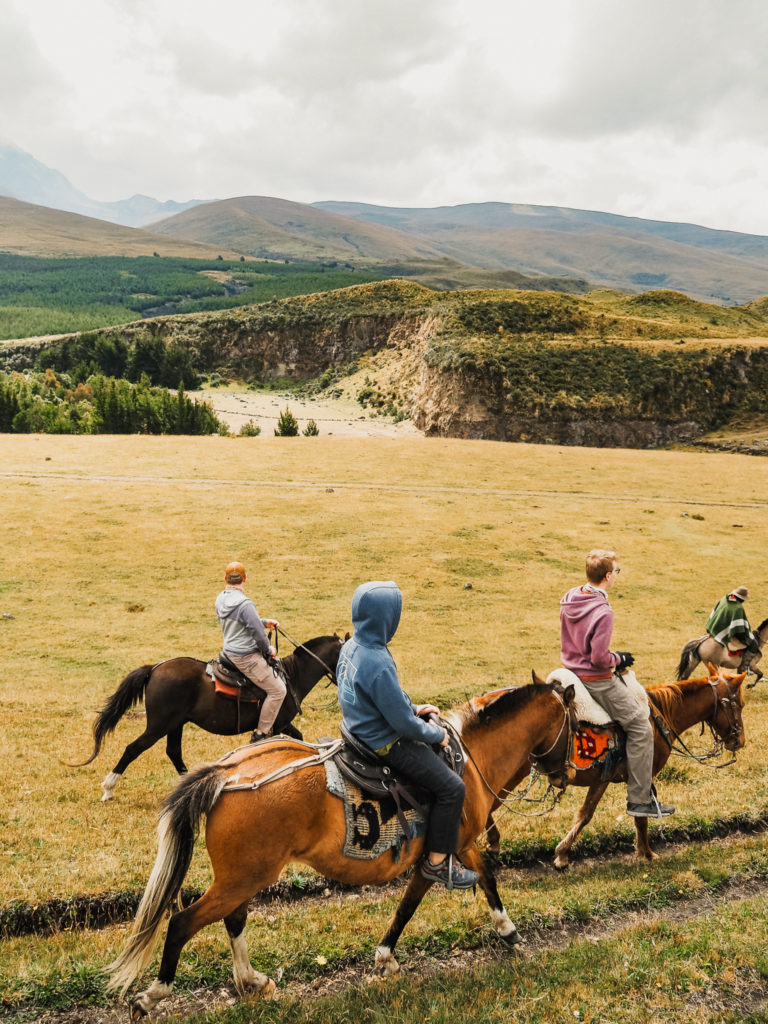
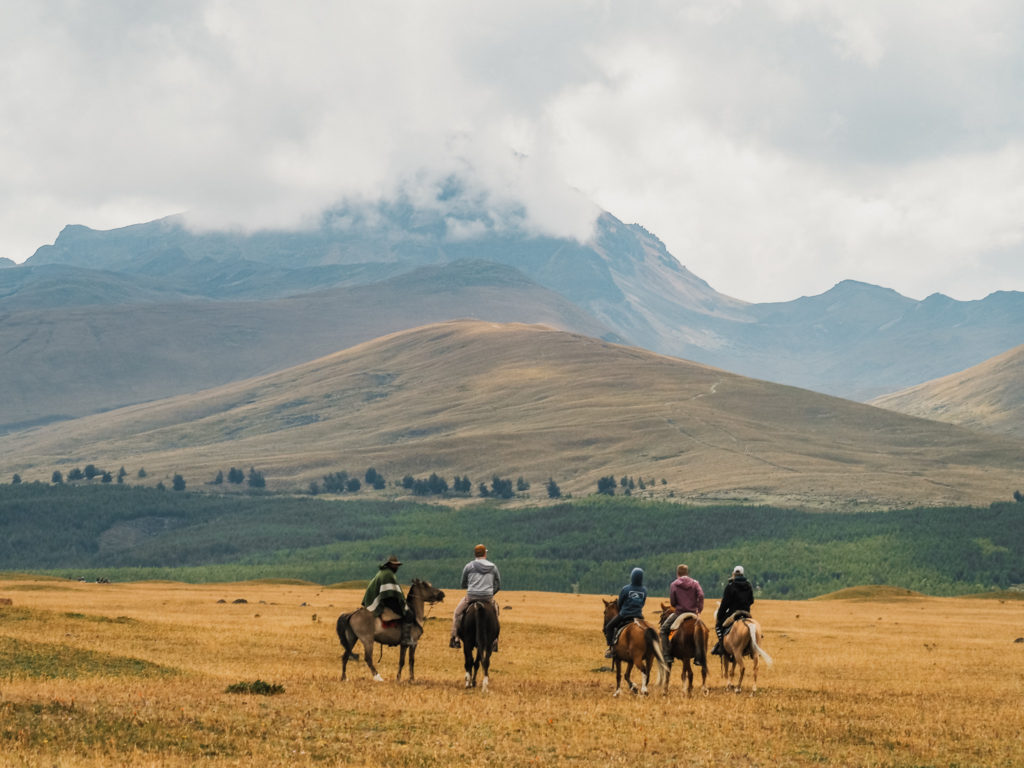
Laguna Quilotoa is not to be missed while you’re in Ecuador. It’s one of the most popular destinations in all of Ecuador with multi-day trek options (such as the famous Quilotoa Loop) or a day hike option, which takes you around the rim of the crater. We opted for the day hike and it was definitely an experience we will never forget. Be prepared though because like many hikes in the Ecuadorian Andes, this hike is high altitude! Even though the rim trail is rated moderate, it is more difficult due to the altitude.
The area around Quilotoa is home to many indigenous peoples, who make their living farming on the land much as they have for thousands of years. You’ll see their homes and farmland dotting the hillsides and even meet them on the trails nearby, usually wearing traditional Andean clothing and often herding sheep with a llama or two. We met a sweet family along our hike and gave them some candy!
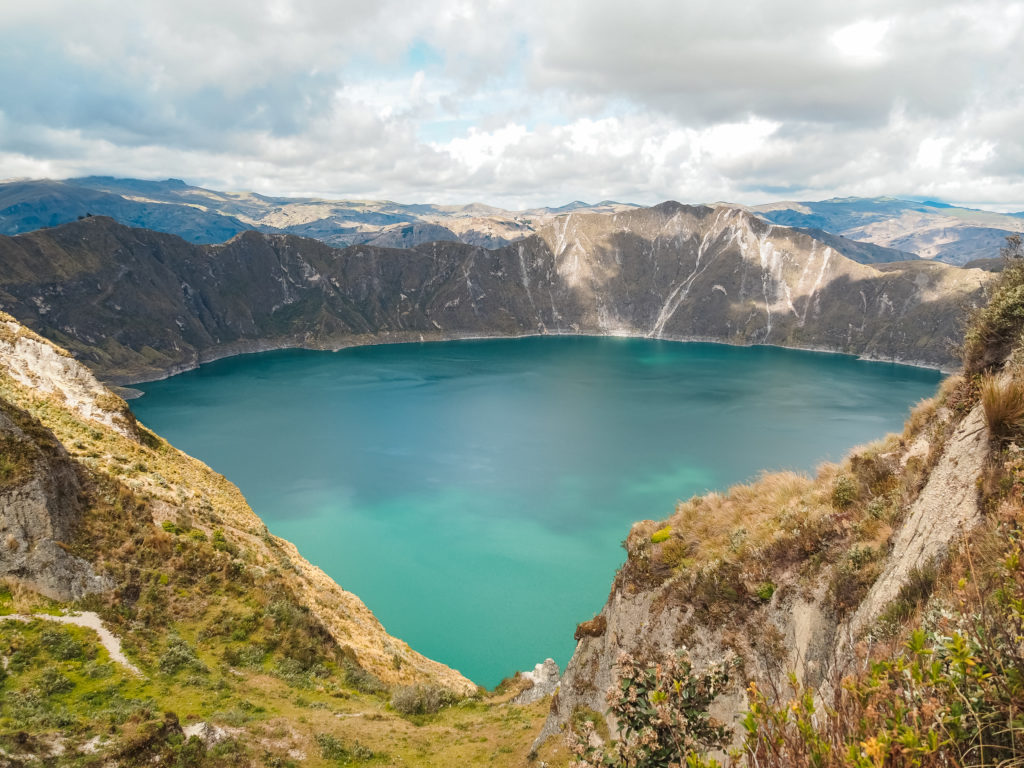
The hike itself along the crater rim is up and down and in some places, may require some scrambling as the trail has much erosion. It is a long day hike, around 6-7 miles (10-11 km) so come prepared with plenty of water, protective clothing (and layers since it can sometimes be cold and windy!), and snacks/food. Also note that because you will be hiking in high altitude, you should bring and reapply sunblock frequently. The sun is strong here.
Once you arrive to the crater via your vehicle, there is a lookout/mirador that looks out over the crater. You can take the trail to the right or the left, however we were told by some locals to go left and hike the rim clockwise because it is slightly easier. The entire hike you will be rewarded with breathtaking views along the whole trail–it truly is like nowhere else we’ve hiked before!
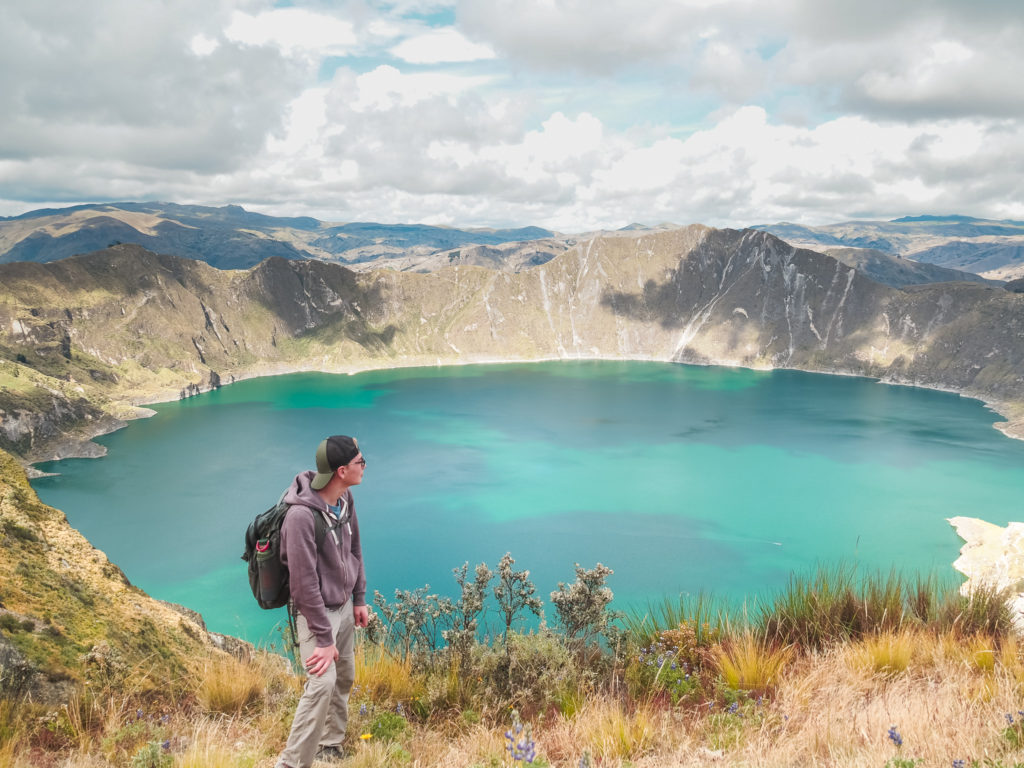
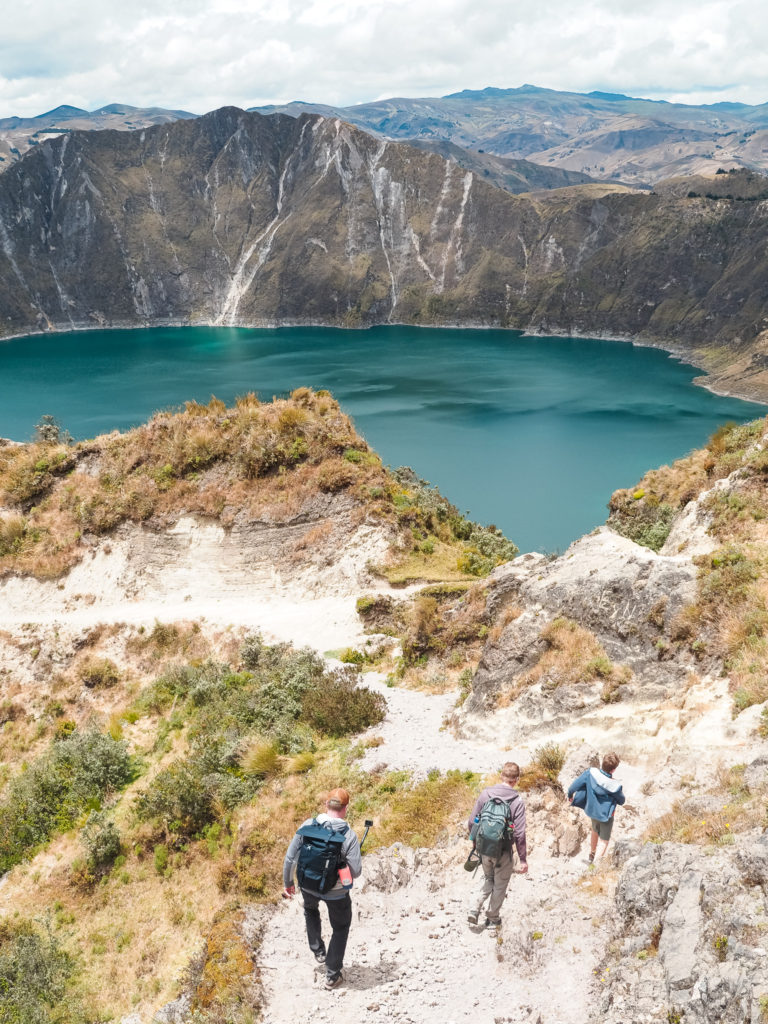
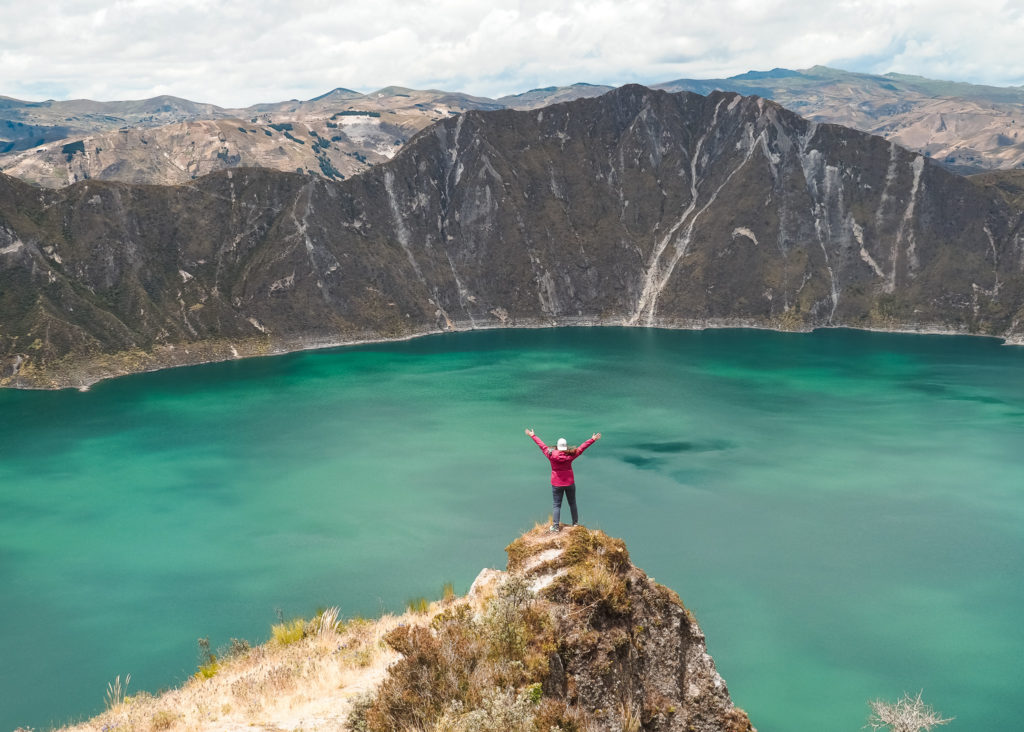
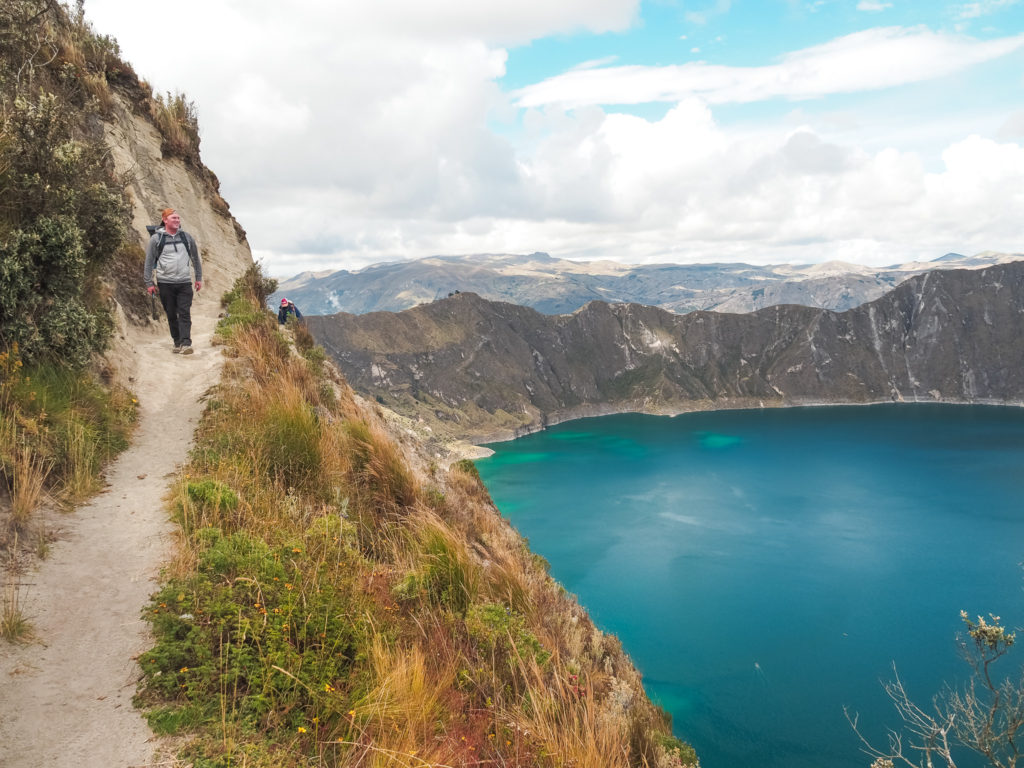
The city of Banos de Santos Agua is only a few hours from Quito, so if you’re staying in Machachi or Latacunga, it’s even closer. By bus that may take a bit longer with stops, but if you have a car (which is what we recommend for this trip), it’s only around two hours from either of those places. Known for its lush, green scenery, Banos is also considered the “adventure capital” of Ecuador, full of rapid rivers, waterfalls, mountains and volcanoes, hot springs and of course, adventure sports.
We spent a little over two weeks in Banos during our 4.5 month trip to Ecuador. Out of all the cities we stayed in, Banos was our favorite for the breathtaking beauty and the close proximity to so many outdoor activities. If you’re following this itinerary, you will only have 3 days here, which means you will need to maximize your time in Banos. That’s why we provide a list to our MUST-DOS in Banos, and depending on your interests and level of adrenaline, you can pick and choose what activities suit your interests best.
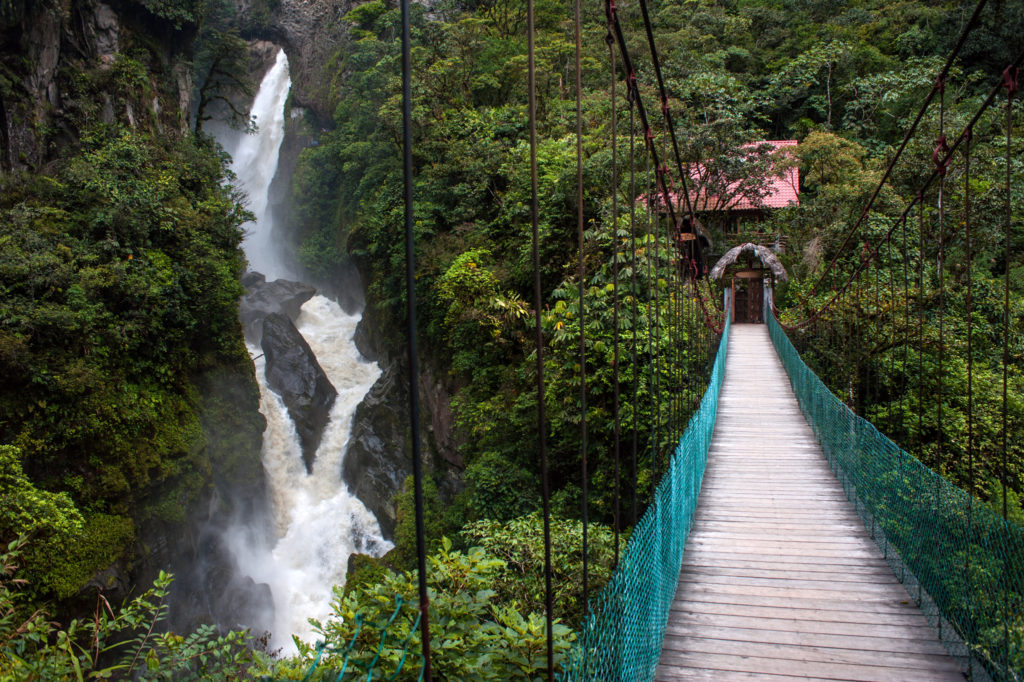
There are lots of accommodation options in Banos–from hostels, low to mid-range budget hotels, luxury resorts, boutique hotels and of course, Airbnb‘s. We chose to stay in an Airbnb since we stayed in Banos for over 2 weeks, but there are a few hotels I would highly recommend here. A little bit of a splurge, but worth it if you want incredible views is Luna Volcan Spa. They also offer day passes to their spa and pool if you just want to just spend a few hours here. Also beautiful is Casa Giralda and Samari Spa Resort. On the lower to mid-range end is Sangay Spa & Hotel, Iti Moon, and Posada J.
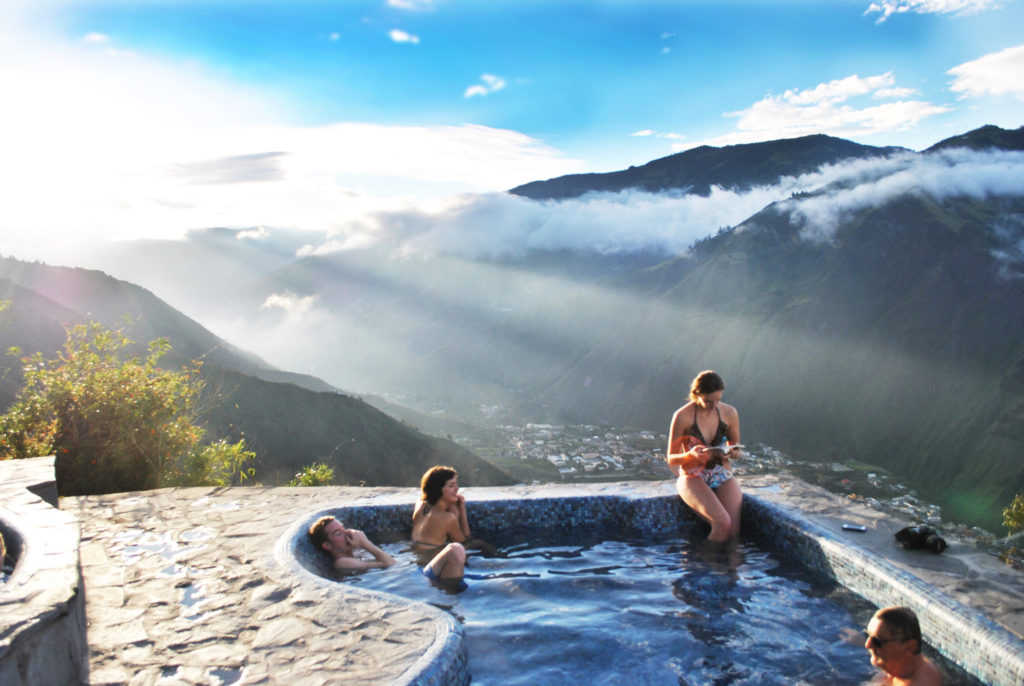
As mentioned above, there are plenty of adventure activities within Banos. Here you can go whitewater rafting, rock climbing, canyoneering, hiking and biking. Banos is surrounded by mountains and volcanoes, so hitting the trail if you’re into hiking is definitely a good idea. Probably the most famous hike in the area is to the summit of Tungurahua Volcano, which is best to go with an organized tour and experienced mountain guide. This is a difficult hike, but if you’re going for “epic”, this is the one to do.
Here is our list for our top picks of outdoor activities and adventures in and around Banos.
You can’t come to Banos without visiting this famous “Instagrammable” tree swing. Set high up on a mountain top about a 30 min bus or taxi ride from town is Casa del Arbol. Side note: Try to visit when the weather is ideal, otherwise the views will be less than impressive since it can often be rainy and overcast here. We actually went to Casa Del Arbol twice–the first time it rained and we couldn’t even see the valley or surrounding mountains; the second time we had great conditions.
You really only need a couple hours max for this activity depending on how busy it is.
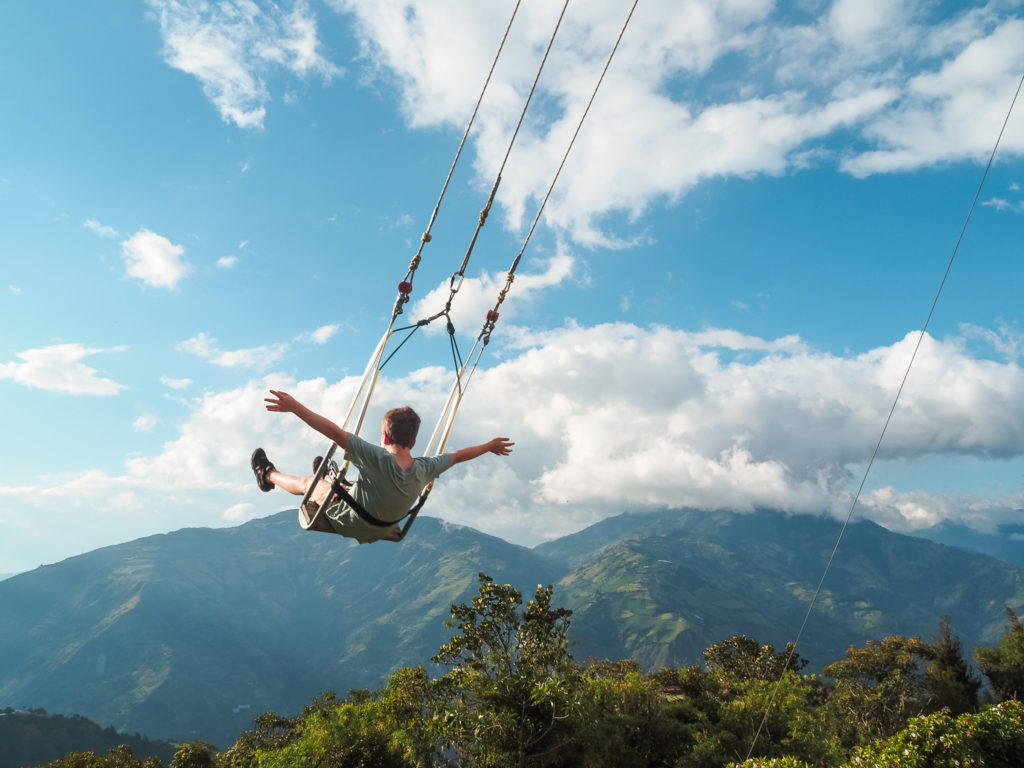
Fortunately, the admission fee to the swing at the “end of the world” is only $1 and to be honest, the park itself isn’t all that impressive. There are some mini zip lines, a cafe and then the swings, of course. Depending on when you go, you might have a line of people waiting to swing and take photos, so be prepared to wait. We got lucky and only waited a few minutes and then enjoyed the swings to ourselves for awhile. I would suggest going first thing in the morning if you can.
You will want to get photos from different angles of this swing because each view offers something unique. From one side, you see the Tungurahua Volcano looming above, from another you can see the mountains and valley below. Casa del Arbol might be a popular, touristy spot but it’s that way for a good reason!
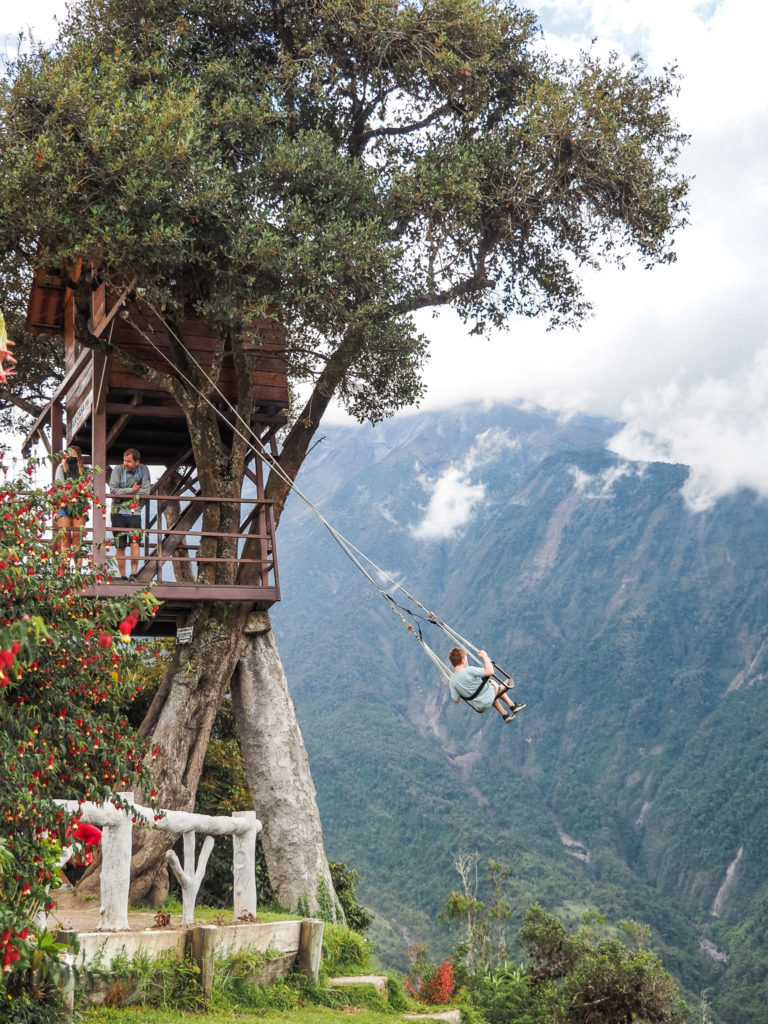
There are not many better places in Ecuador where you can see several waterfalls along the road’s short stretch than Ruta de las Cascadas in Banos. Rent a bike in town for the day and follow the road from Baños to Puyo. We rented bikes from Geo Tours for $7 each. They also gave us a map and outlined the main points of interests (with Pailon del Diablo being the final destination).
It is worth mentioning that the route is mostly flat and downhill, making this is a fairly easy ride! And if you don’t want to bike back to Banos (uphill), there are trucks at Pailon del Diablo that will take you back to town (cost around $5 each person).
Many people choose to bike all the way to Puyo, but the first 12 miles or so (around 20 km) are rewarding enough – we saw at least seven waterfalls and stopped along the route several times to take photos and enjoy the views. For most of the route, you are sharing the road with cars, however there are a few sections where the path splits off for bikes only. There are also a couple of tunnels you will bike through.
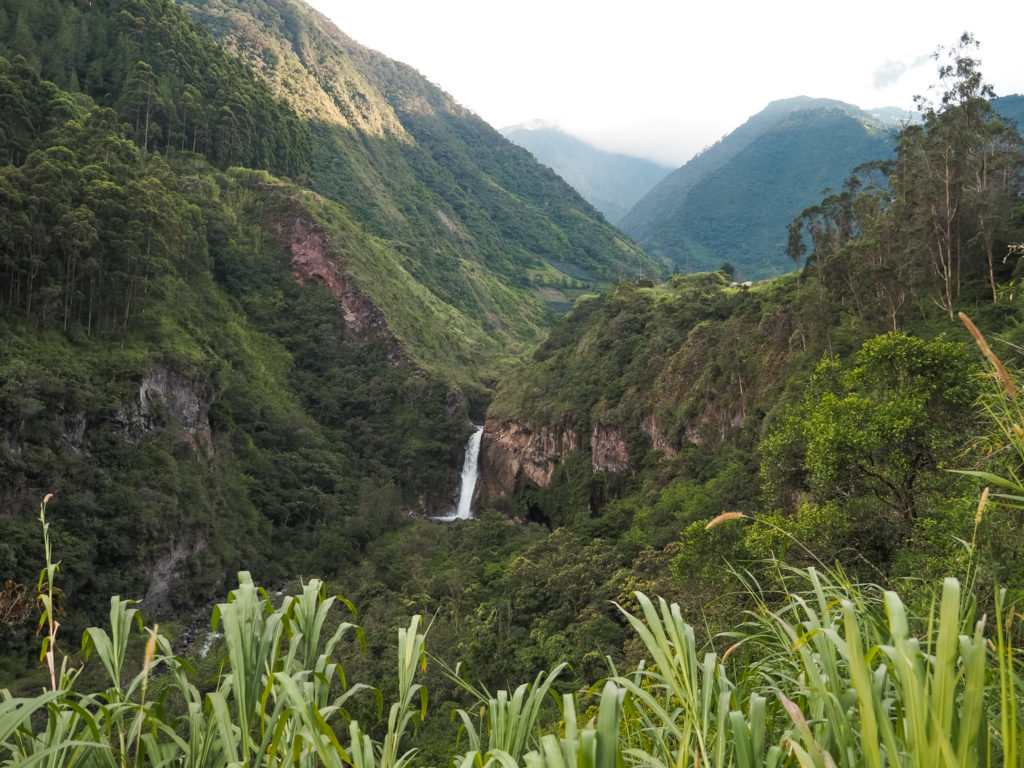
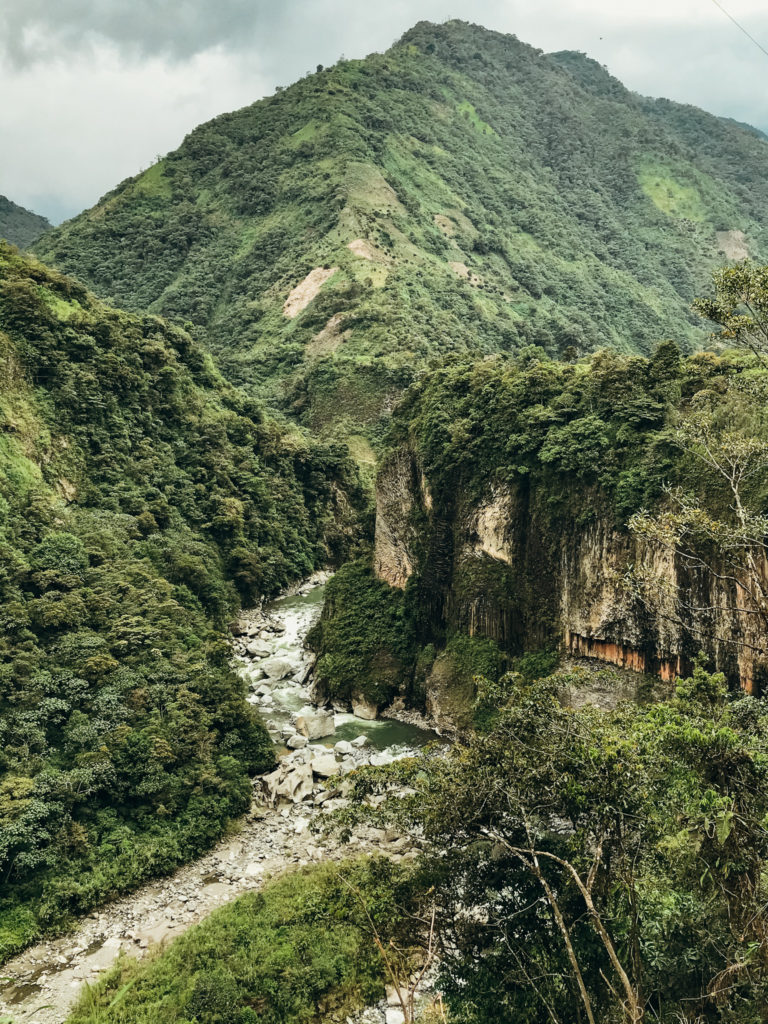
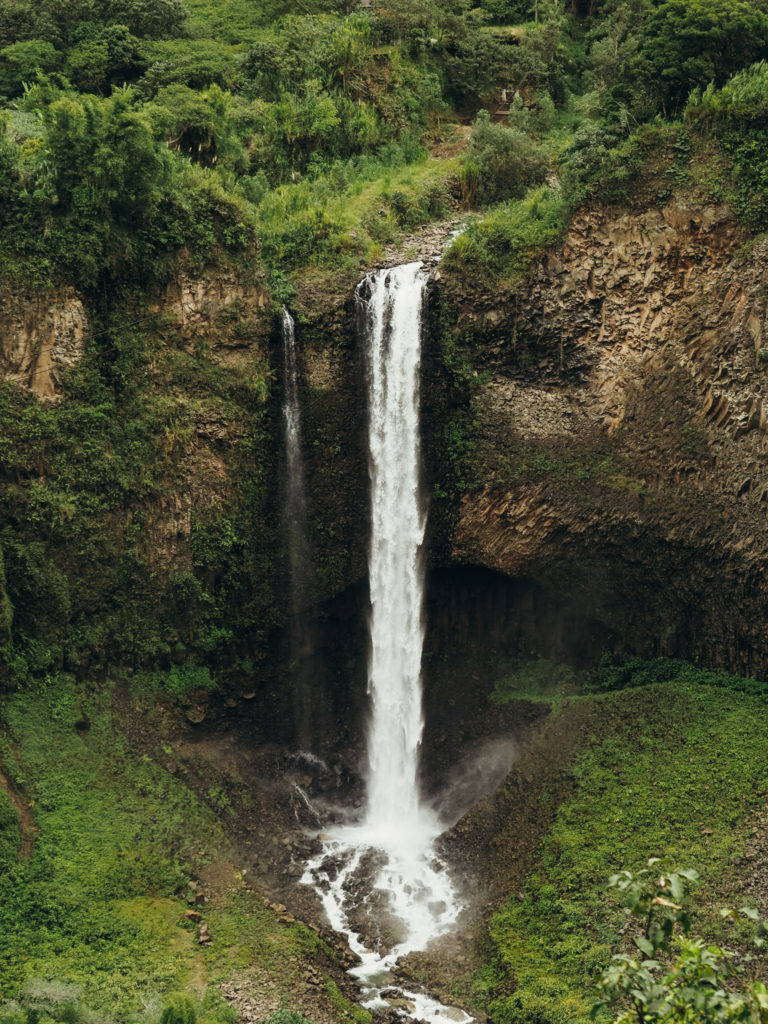
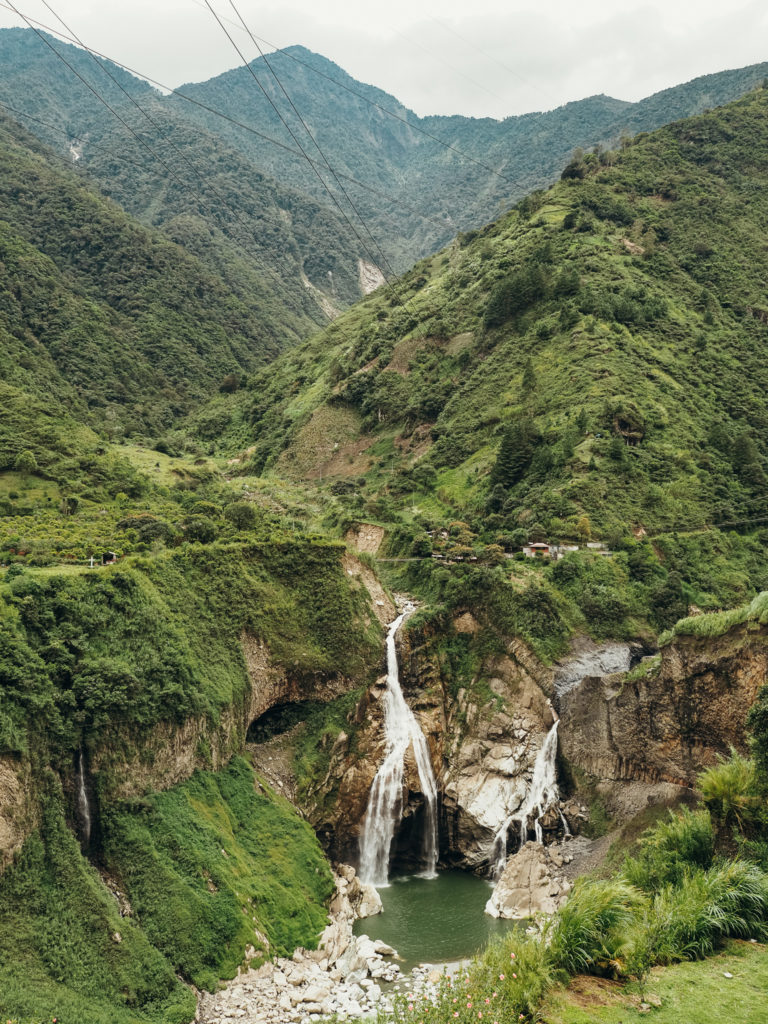
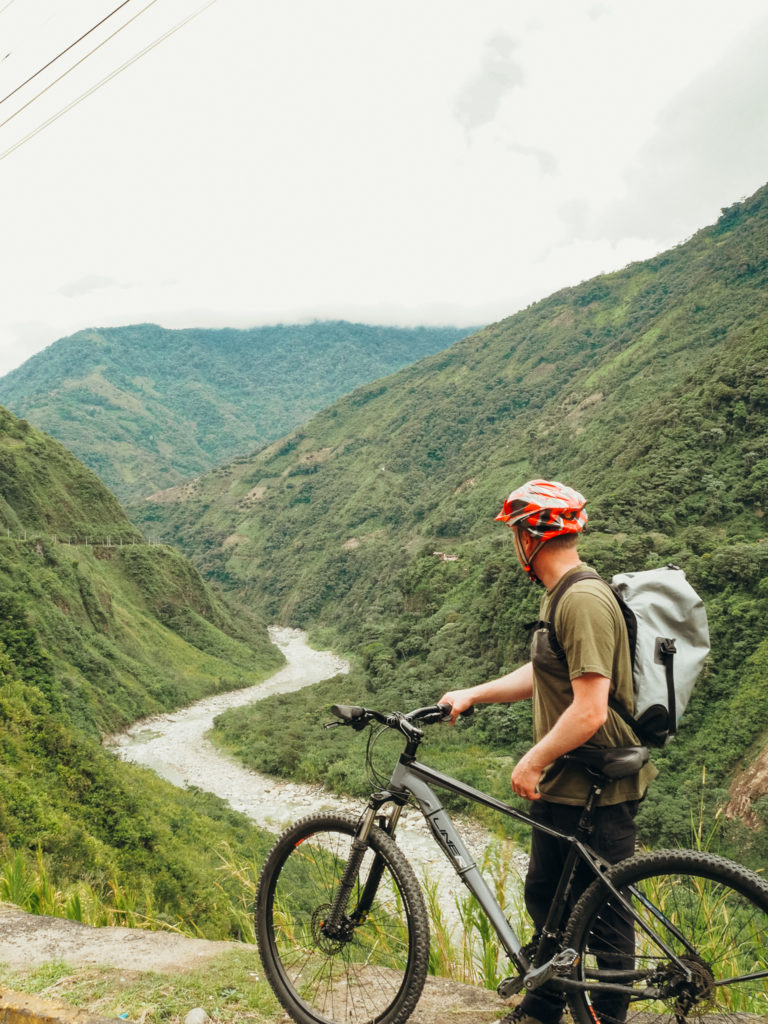
At some of the waterfalls along the way, there are cable cars and zip-line stations across the gorge; you can combine this activity with the biking trip. We stopped at Manta de la Novia to ride the cable car across the gorge–what a thrill! Save the best waterfall for last though–the famous Pailon del Diablo is one of the most breathtaking waterfalls in Ecuador and all of South America.
When you visit Pailon del Diablo, there are actually two entrances. We suggest going to both because you will get two different viewpoints and experiences. From the upper falls, you will witness the power of the waterfall (seen from the photo below), but from the lower entrance, you will see views of the falls from the hanging bridge which are out-of-this-world. From here you can walk across the bridge and up the short trail and stairs, and even walk behind the waterfall! Be prepared to get wet though!
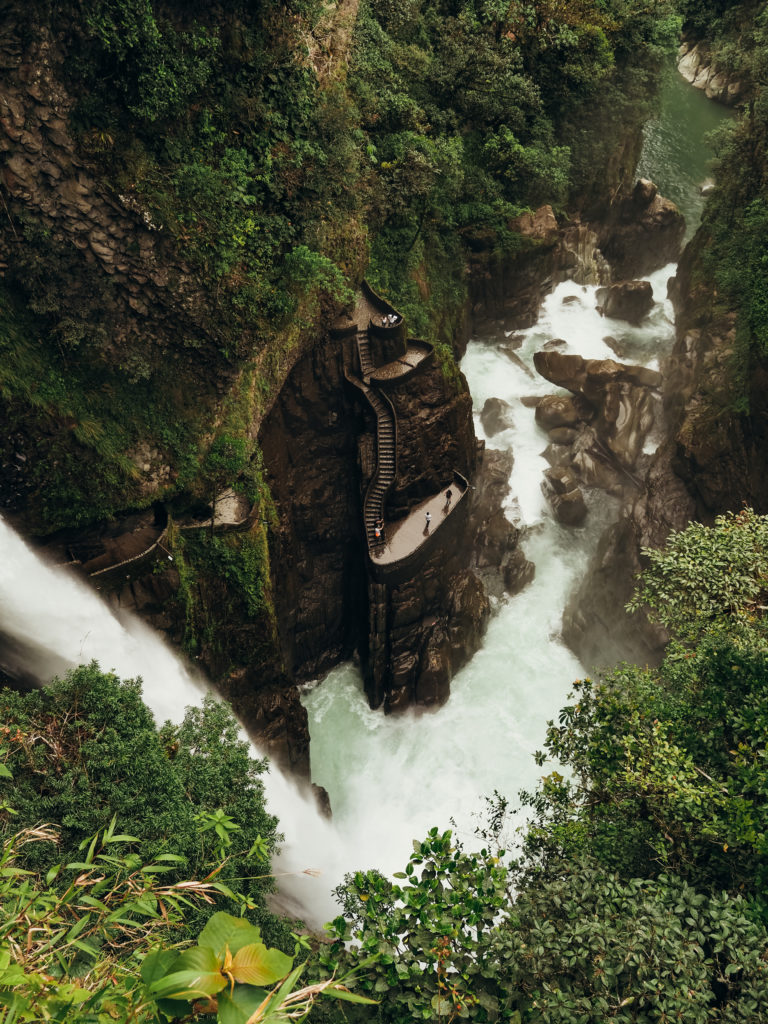
If you’re into adventure sports like we are, you can’t come to Banos without going canyoneering or whitewater rafting. Both of these activities are popular in the area because Banos is the perfect destination with all the waterfalls and rivers! We spent a day canyoneering with Geo Tours and had an absolute blast jumping off, sliding, and rappelling down several waterfalls. We also waded through rivers, shimmied our way through narrow canyons!
If you have young kids, likely this will not be activity that you will be able to do with small children. Most tour companies have an age requirement of 10 or 12 and up. This is for safety reasons. Whitewater rafting is another activity that you could do just as a half day excursion. In fact, if you really wanted to, you could combine the canyoneering and the rafting in one day! Geo Tours has plenty of options for whitewater rafting too and can arrange those tours for you. Costs range from $30-70 per person.
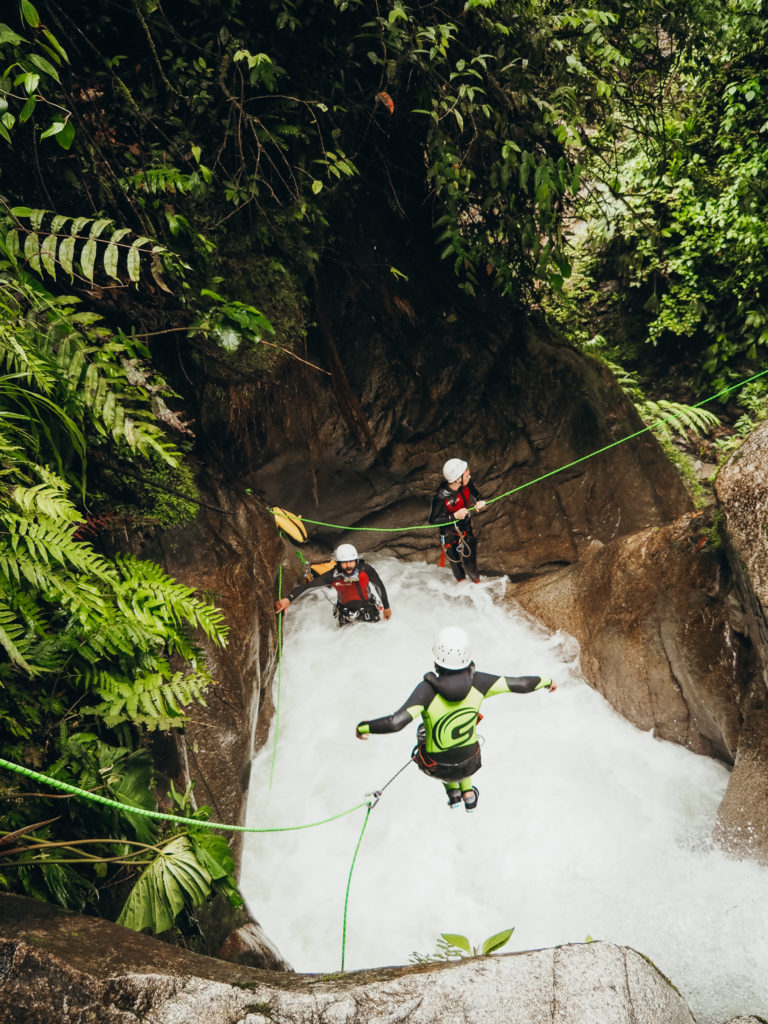
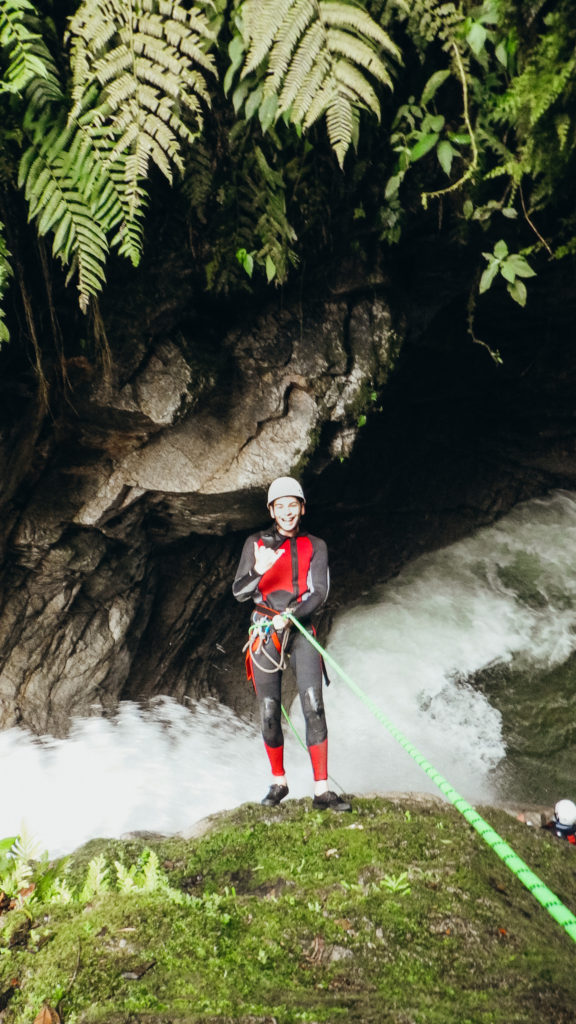
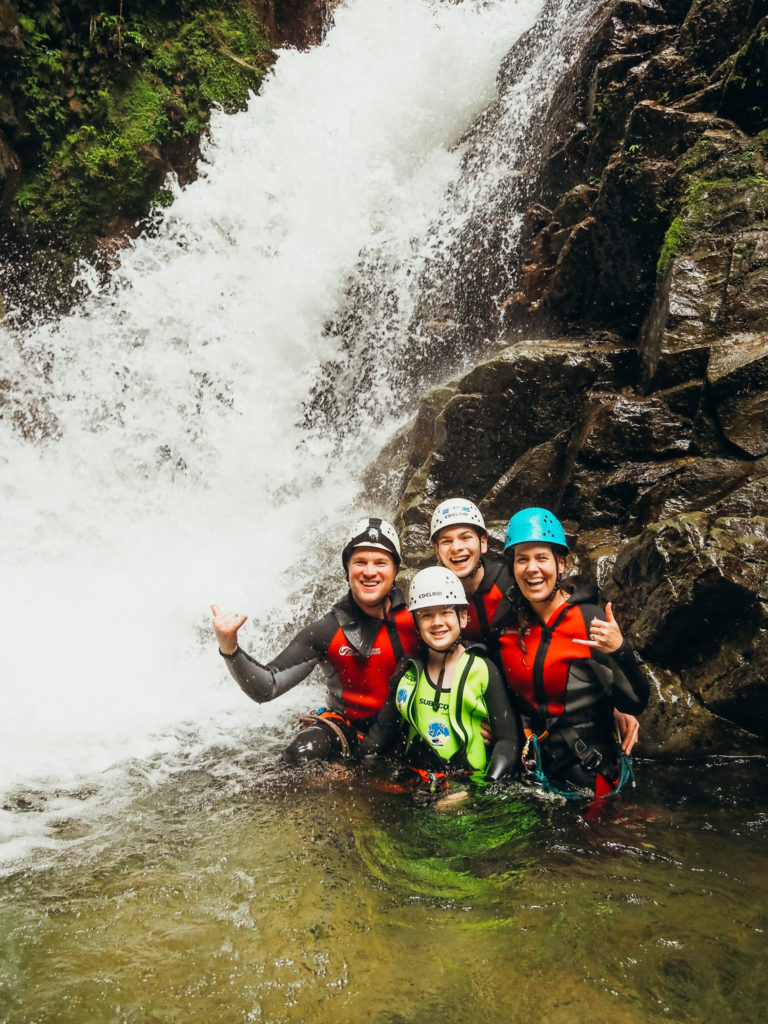
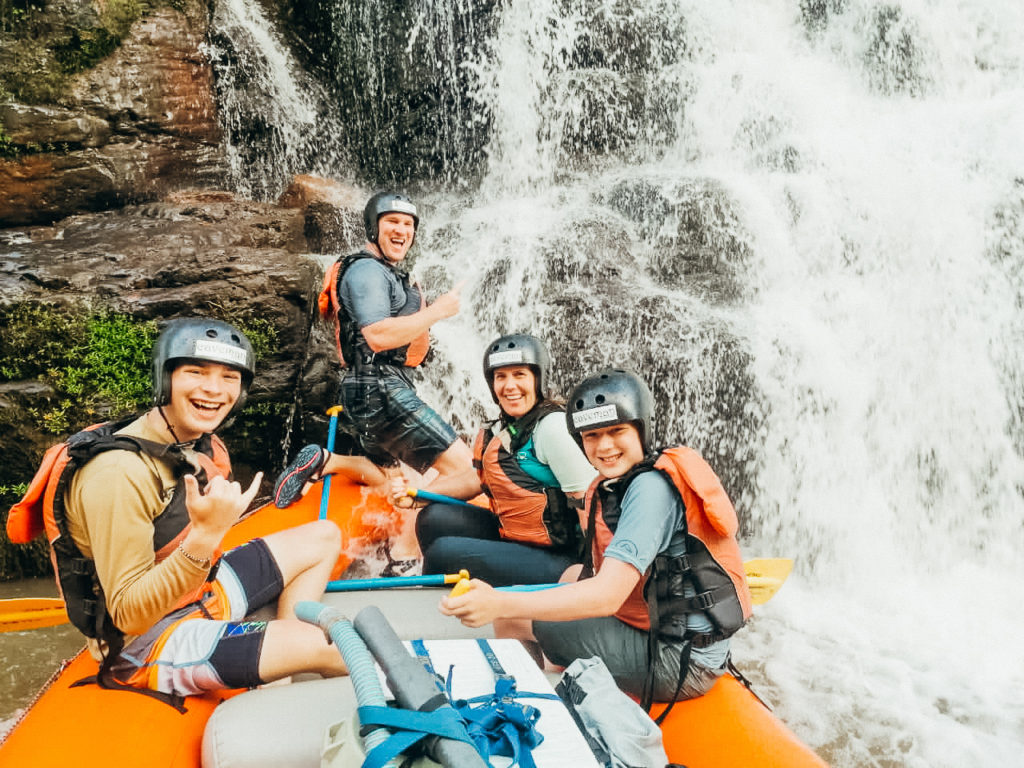
If you choose to do the waterfall bike route one day, another day you go to Casa del Arbol, and then the last day you go canyoneering and whitewater rafting, then that would likely cover most of your time in Banos for your 3 days. You might have a little extra time on the day you go to Casa del Arbol, or if you choose not to do BOTH whitewater rafting and canyoneering activities, you would have some some free time that day too.
If you find that you are looking for a few extra things to do in Banos, we have a few other suggestions. One is to relax and soak in some hot springs. In fact, the “baths” is what gave Banos de Agua Santa its name (Bath of Holy Water), so you can expect that there would be some famous hot springs here. The hot springs themselves are heated by the massive and active Tungurahua volcano!
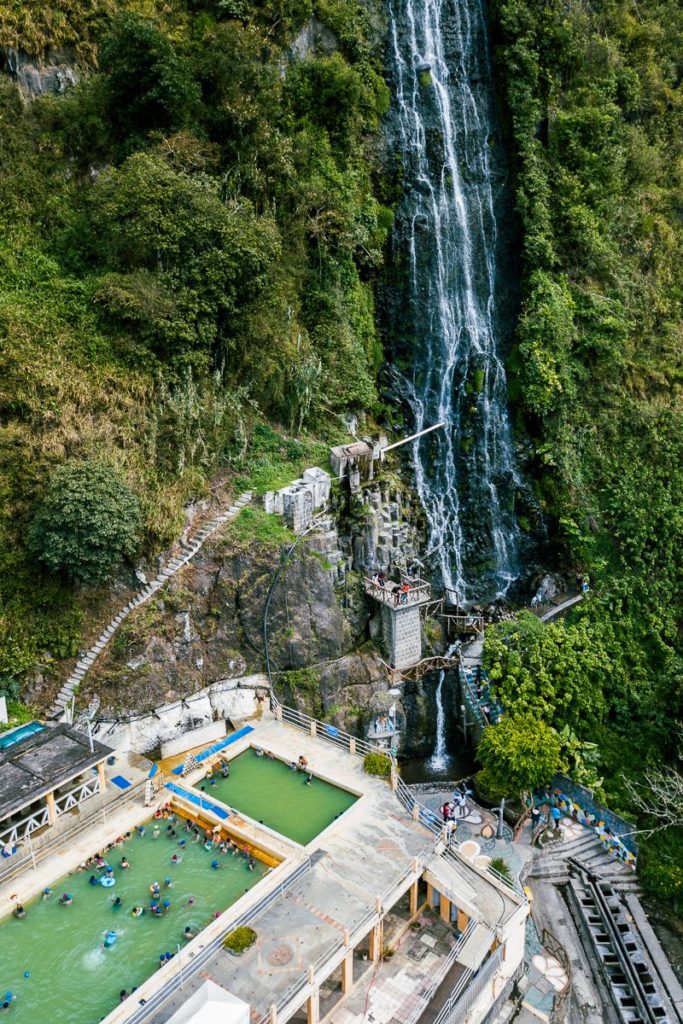
Some of the best hot springs include: Termas de la Virgen (right below a waterfall and most popular with the locals), El Salado (less crowded, but not as hot as Virgen), El Refugio, and Luna RunTun (these are the hot springs at Luna Volcan hotel and perhaps boast the best views!). Soaking in some hot springs is the perfect way to end an adventure-filled day!
Other activities to consider in Banos should you have time are rock climbing (also popular in Banos!) and if you’re really into extreme sports, bungee jumping and paragliding. We spent half a day rock climbing with Geo Tours and it was so much fun! We also did the bungee jumping (because why not!?) and that was such an adrenaline rush! Geo Tours set us up with the guide who operates the bungee jumping and reassured us that it was 100% safe and legit. We were very impressed with the equipment and the professionalism dedicated to making sure we were safe.
Did I mention you jump off a bridge over a river? Yep.
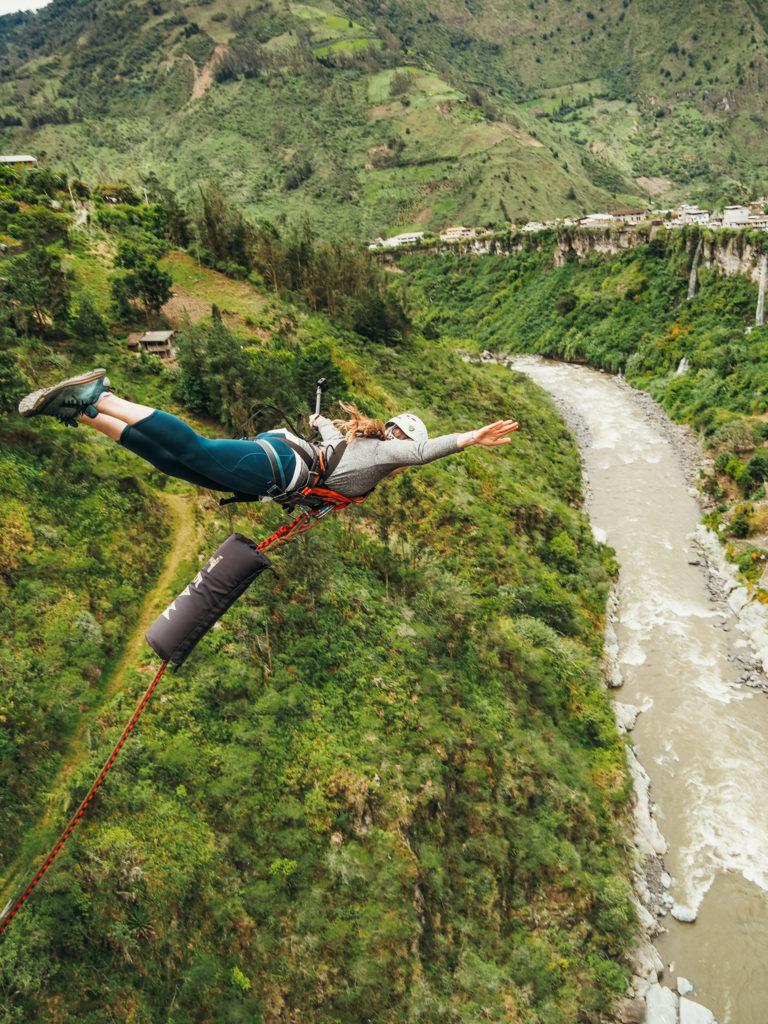
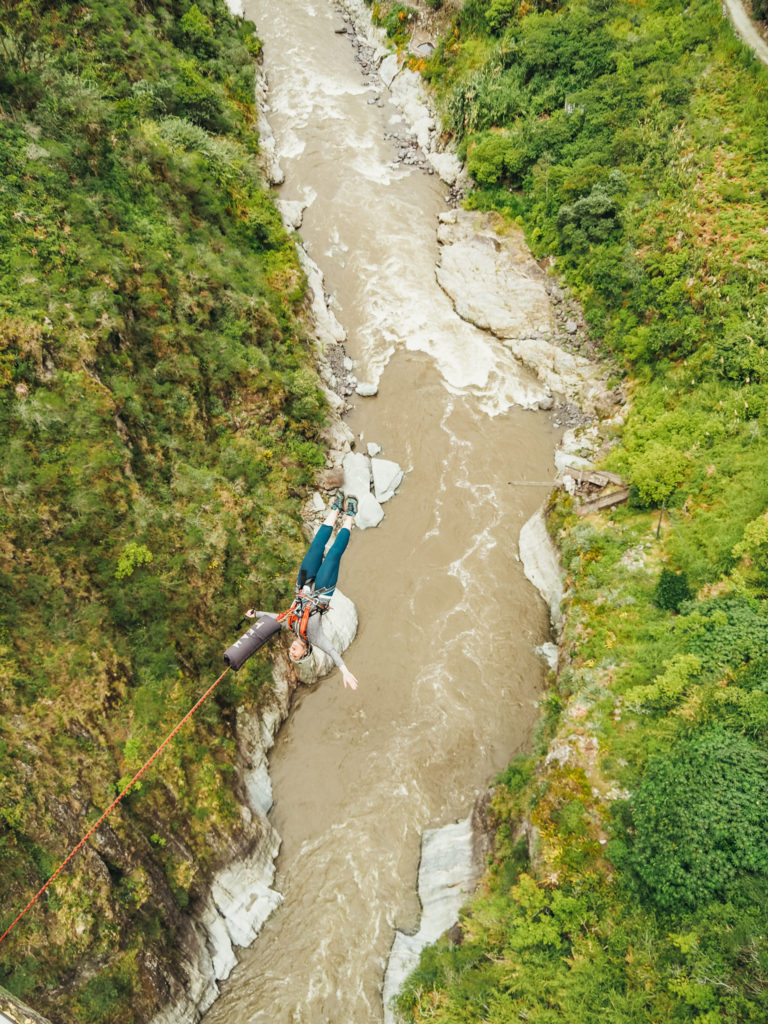
Banos is about equal distance to Guayaquil and Quito (around 4 hours), the two major airports in Ecuador that you fly from to get to the Galapagos, so you will need to coordinate flights to the islands. We would suggest checking both airports and seeing whichever is cheapest. If you rented a car in Quito, likely you will return to Quito (unless the rental company allows you to drop off the car in Guayaquil).
There are two airports on the islands, one in Baltra (the main one) and another on San Cristobal (Puerto Baquerizo Moreno). Most tourists fly into Baltra which is adjacent to Santa Cruz (a short 5 min ferry), the most popular tourist hub in the Galapagos Islands. Another reason Baltra is the go-to airport is because if you are going on a cruise, this is where you would start. You can book tickets through domestic airlines with LAN or Avianca. We use Sky Scanner and Momondo for finding the best deals on flights.
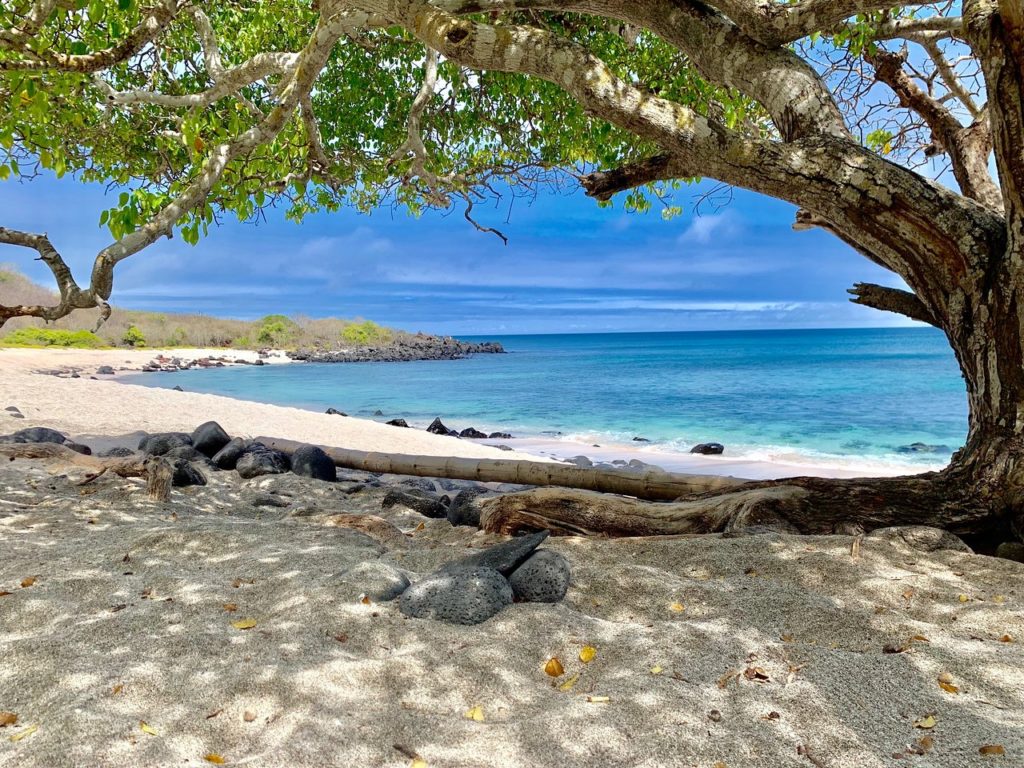
Because you only have a little less than a week in the Galapagos (unless you have the flexibility to stay longer), we highly recommend doing a small cruise with Galagents Galapagos Cruises if your budget allows for it. Why? You will see MORE places and get the BEST Galapagos Islands experience in just 5-6 days. We spent a total of 10 days on the Galapagos Islands and our 5 day cruise was hands-down the highlight of our time on the islands.
If you choose to do the cruise, you will want to fly into Baltra. Depending on the itinerary with the cruise, you might plan it so that you start the cruise the day you arrive (this is what many people do). This would be ideal because the cruise company will arrange to pick you up directly at the airport and take you to the ship. However, if you end up having a day or two before the cruise starts, we would recommend staying on the island of Santa Cruz (a short 5 minute ferry ride from Baltra).
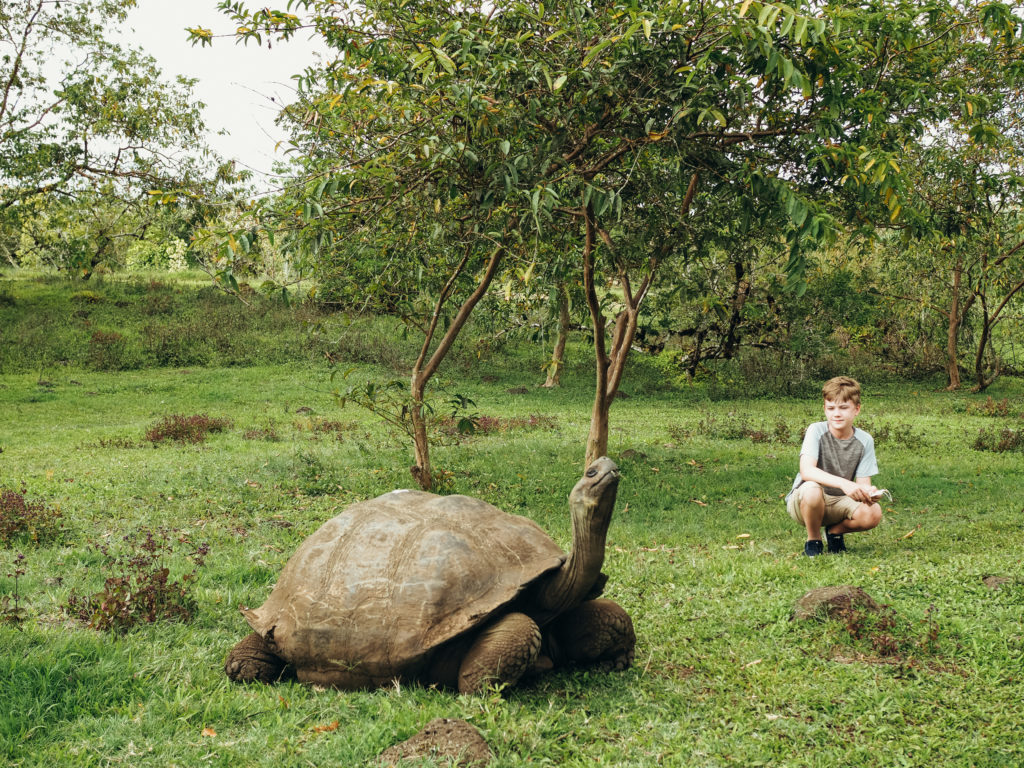
Santa Cruz is the main tourist hub, as well as the most populated island in the Galapagos. Puerto Ayora is the port city on the island where the largest variety of hotels, restaurants, tour companies and shops are located. There are plenty of activities and places of interest on Santa Cruz, most notably the Charles Darwin Center, Fish Market, El Chato Tortoise Reserve, Tortuga Bay, and others.
Santa Cruz has a wide range variety of accommodations ranging from hostels, B & B lodges, high-end hotels and resorts, as well as Airbnb’s. Our top choice in Santa Cruz is the Royal Palm Hotel, located in the highlands away from the hustle and bustle of Puerto Ayora. It is peaceful and beautiful, private and spacious, and offers great amenities for nature lovers and people who want to get away from it all. The Royal Palm mainly consists of private villas of different sizes to accommodate couples or families.
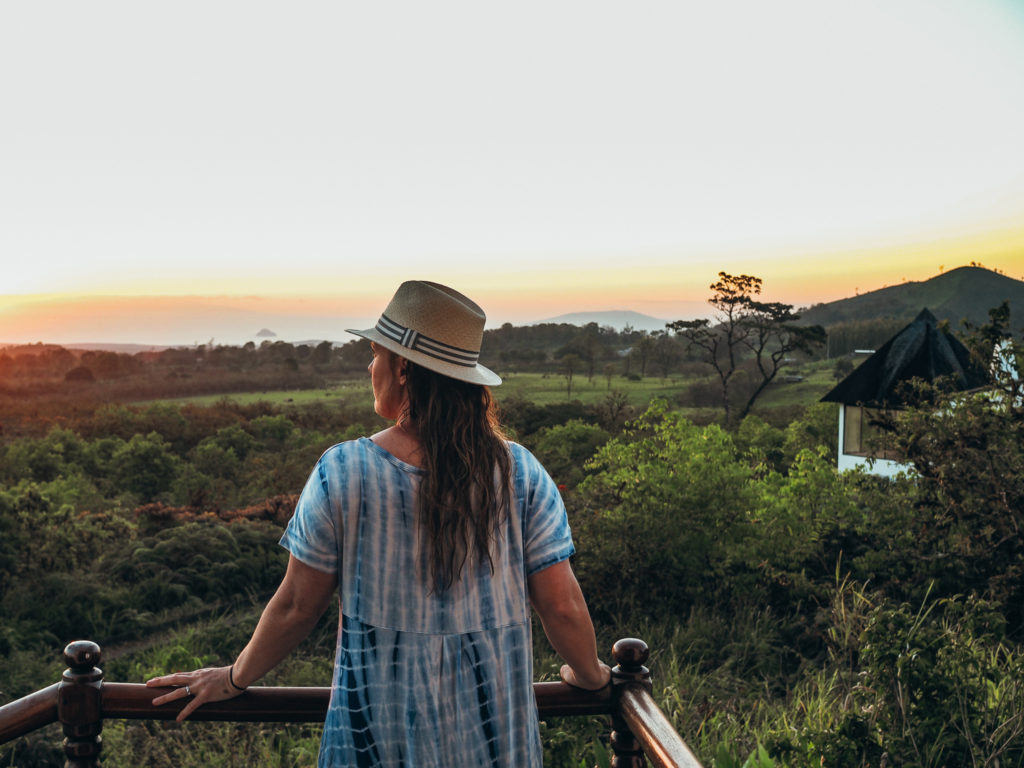
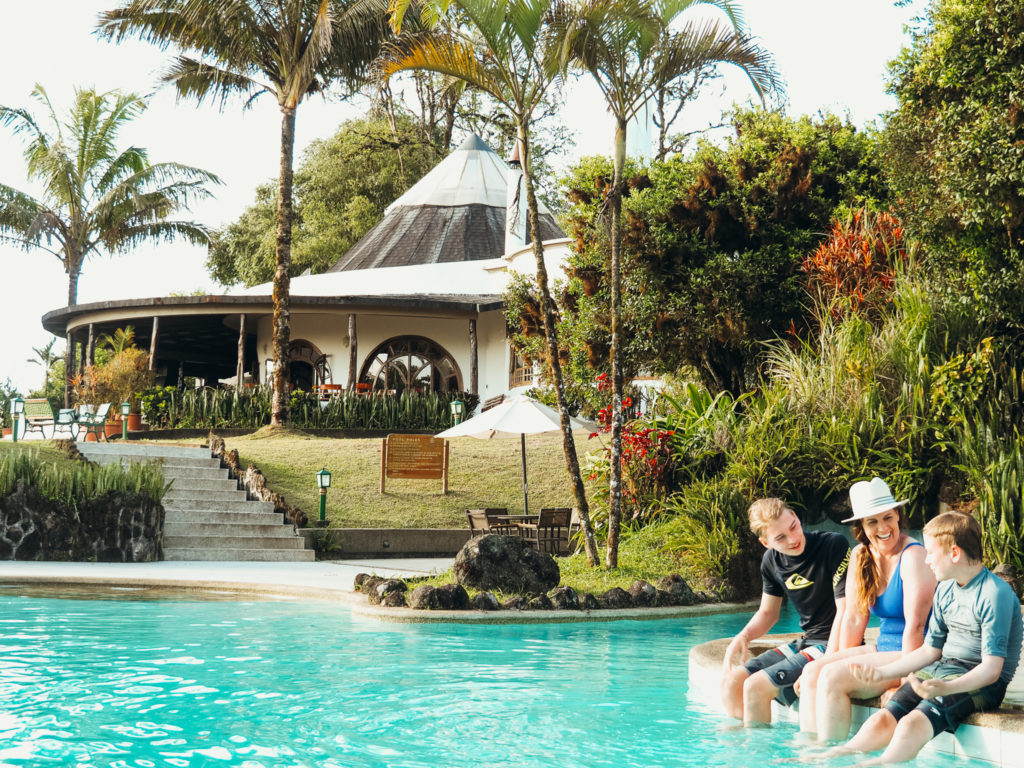
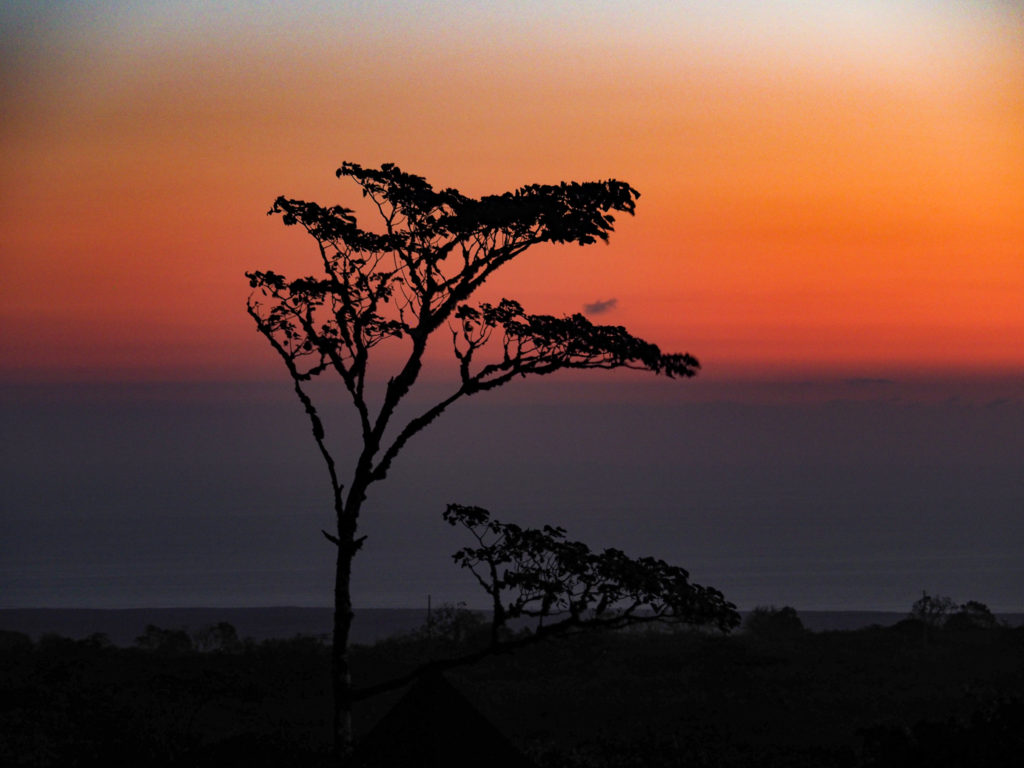
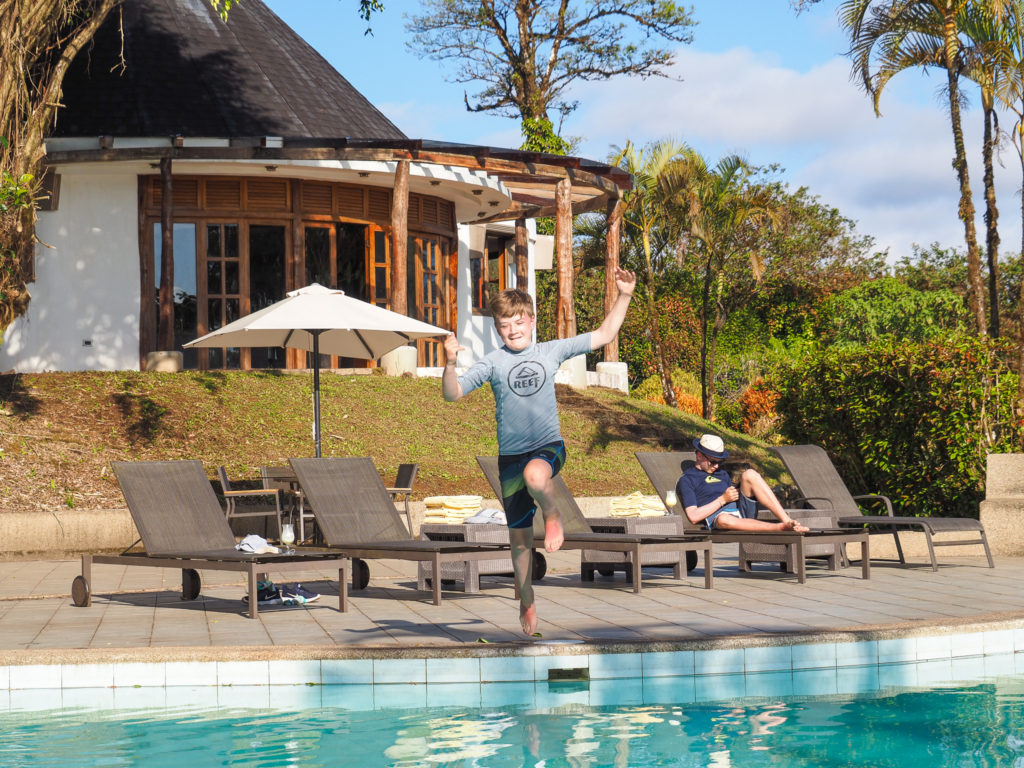
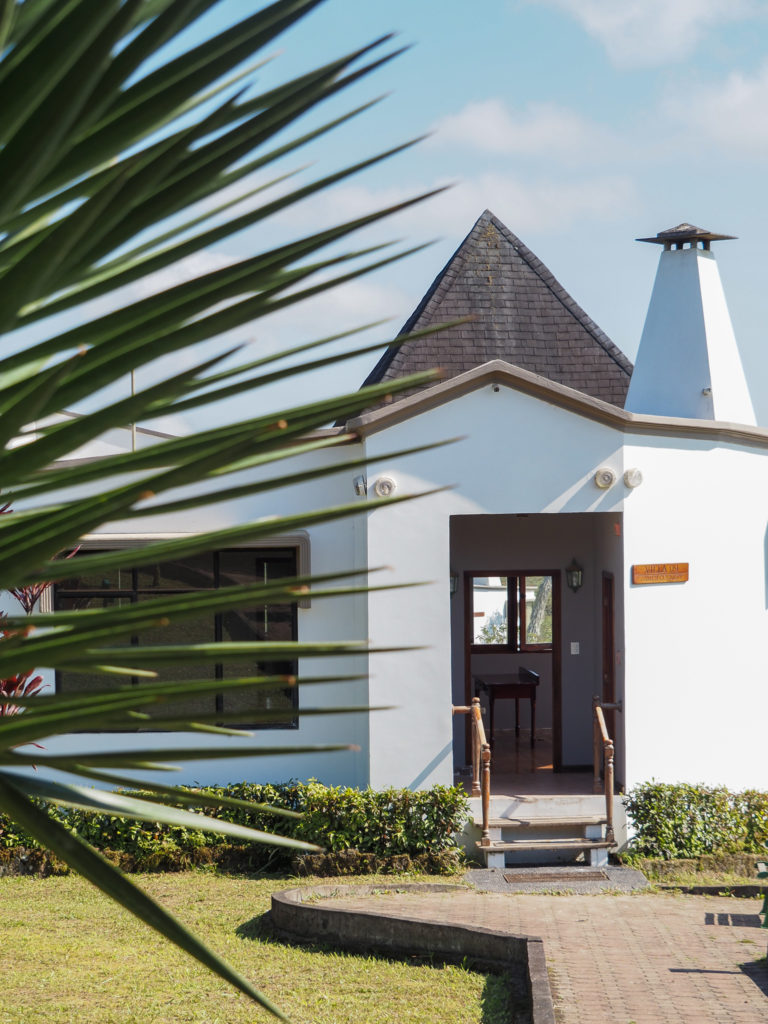
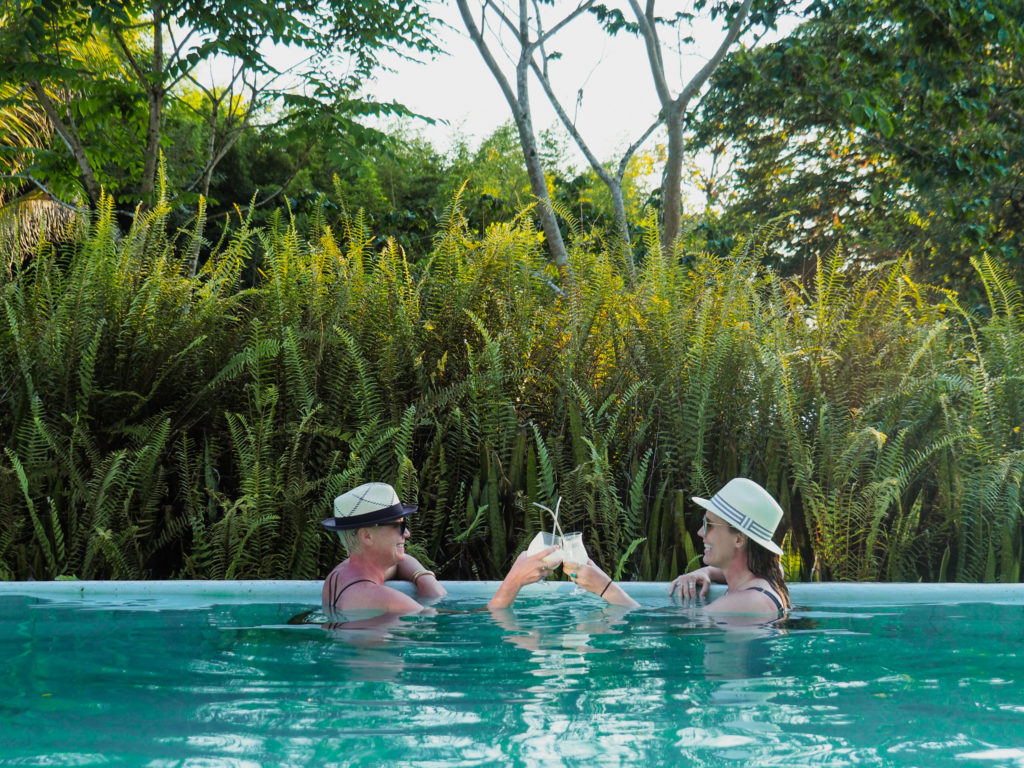
If you only have a day or two to spend on Santa Cruz before your cruise, we would recommend prioritizing Tortuga Bay and the El Chato Tortoise Reserve (unless your cruise itinerary stops here). Theoretically you could get to both of these places in one day, however you might feel rushed and want to just choose one. El Chato is a must if you want to see the famous giant tortoises. It is very fascinating to watch the tortoises in their natural habitat and you will learn a lot about these incredible creatures that can live over 200 years old and weigh up to 700 lbs. Your hotel can arrange for a taxi to take you to El Chato.
If you decide to go to Tortuga Bay, you will not be disappointed. It’s probably the most famous beach on the whole island and for good reason–it’s insanely gorgeous and offers a little of everything for beach and nature lovers. Here you will see plenty of wildlife such as marine iguanas, birds, sea turtles, rays, and even sharks! If you’re looking for more information and details on Tortuga Bay and things to do on the island of Santa Cruz, make sure to check out our full itinerary for the Galapagos Islands.
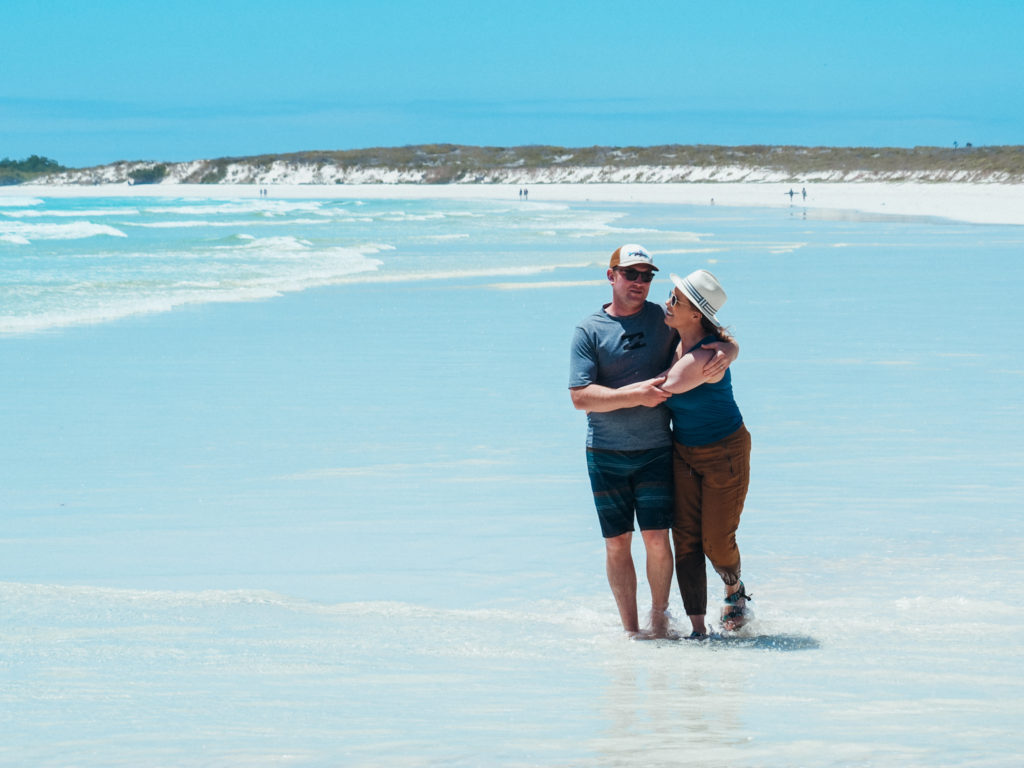
As mentioned earlier, the highlight of our time in the Galapagos was on a small cruise with Galagents Galapagos Cruises, one of the top cruise operators in the islands. We went on the Eco Galaxy catamaran and honestly, we couldn’t recommend it enough. It was the absolutely the highlight of our entire trip to the Galapagos! One reason we chose to cruise with Galagents is the fact that they are committed to environmentally- friendly practices.
There are a few other really important reasons we chose to cruise with Galagents: one, they only operate small cruises. All of their cruises have a maximum capacity of 16 passengers or guests, plus about 10 staff members. We love this! This makes for a more intimate experience where you get to know the other guests on the ship. After 5 days living aboard the Eco Galaxy, we had made some great friends! (*Side note: You could book a cruise with 16 family members/friends and pay the same price and basically have your own chartered boat!)
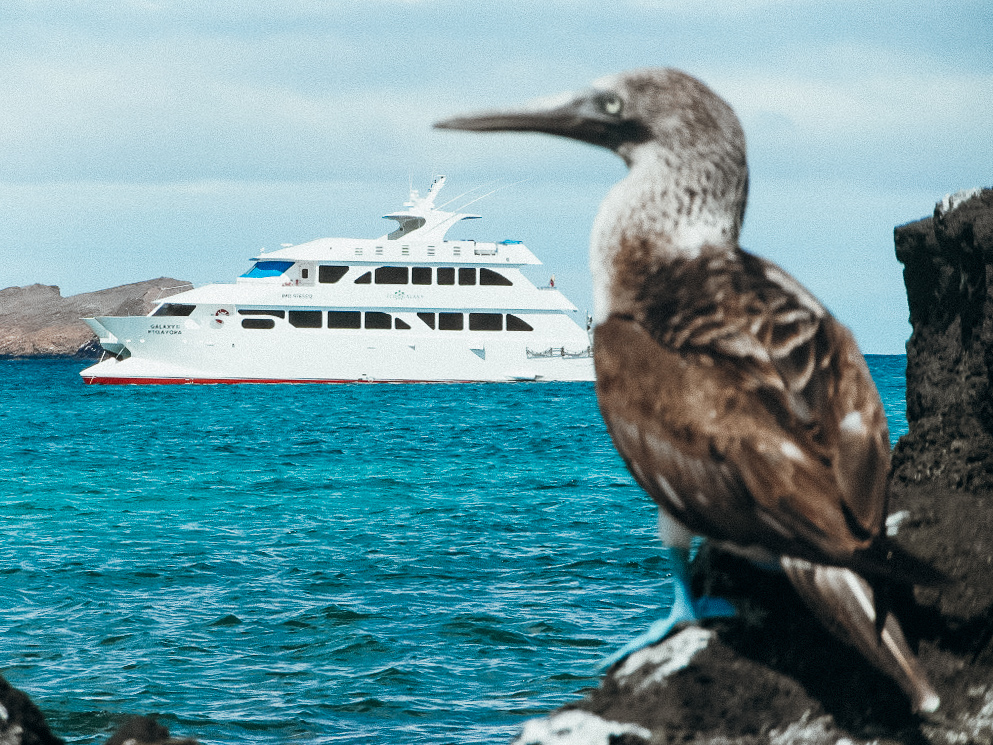
Another perk of going with Galagents Galapagos Cruises is they offer different options in terms of length of cruises and prices. We did the 5 day/4 night cruise, but they offer 4 day up to 8 day options. Make sure to check out all the itineraries and different ships to find the best one to suit your budget and schedule. If you are traveling to the Galapagos during Covid times, it’s important to note that Galagents is following every precaution and biosecurity measure to ensure guests and staff are safe. You can read about Covid requirements to travel to the Galapagos here or here.
What’s included in your cruise with Galagents? Your own private room or cabin (with a bathroom), ALL meals and snacks, a guide, the use of wetsuits and snorkels, kayaks and/or paddle boards. Basically everything is included except alcoholic drinks, tips to the staff/guide, and of course, your transportation to and from the Galapagos. We loved the cabins–they were spacious, comfortable and each had windows with views.
The staff aboard the Eco Galaxy was outstanding, helpful and extremely friendly. Our guide spoke English and was very professional and knowledgable about the islands. In fact, our specific guide (from the Galapagos!) has been guiding for over 30 years! He guided us on both land and sea excursions.
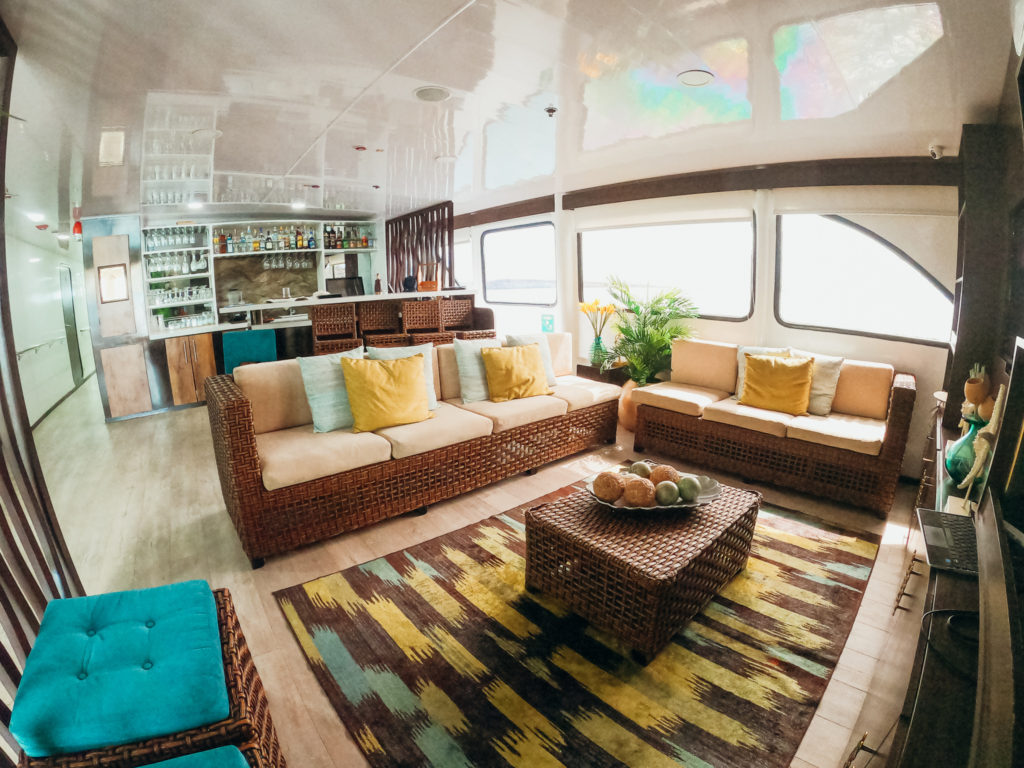
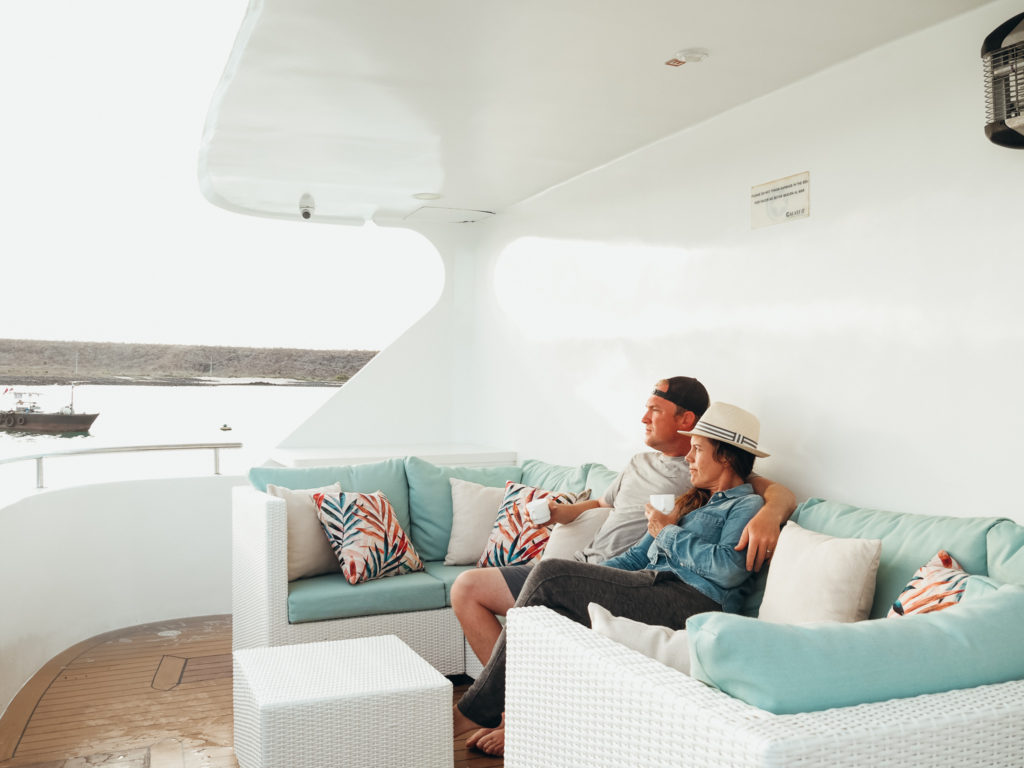
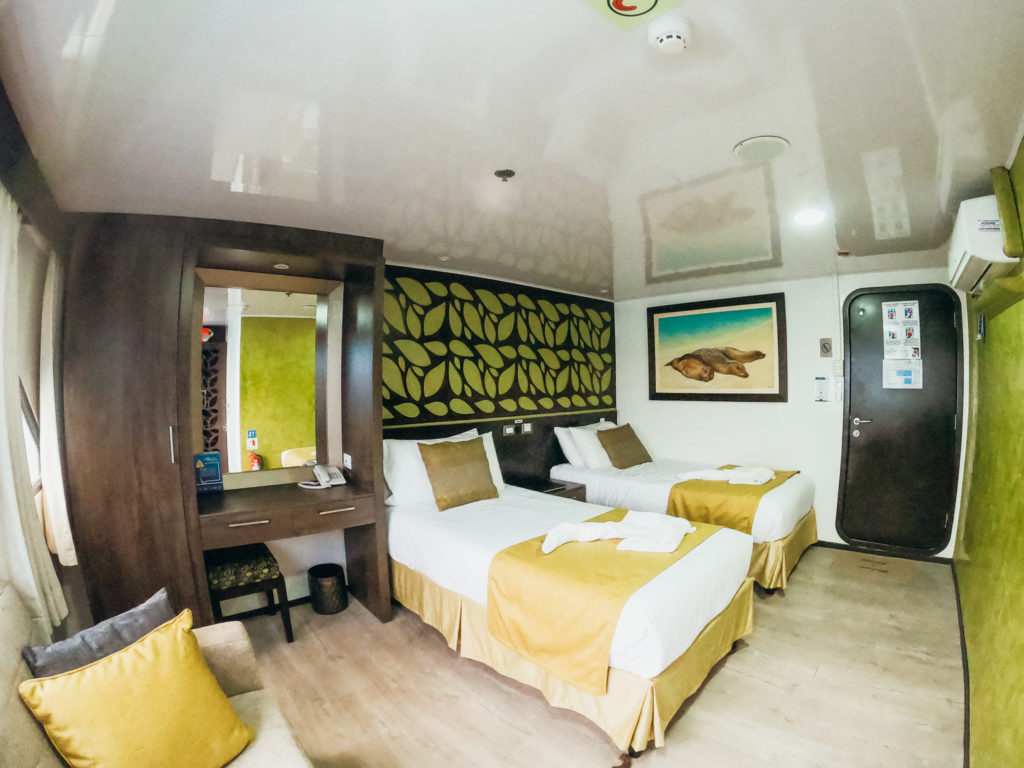
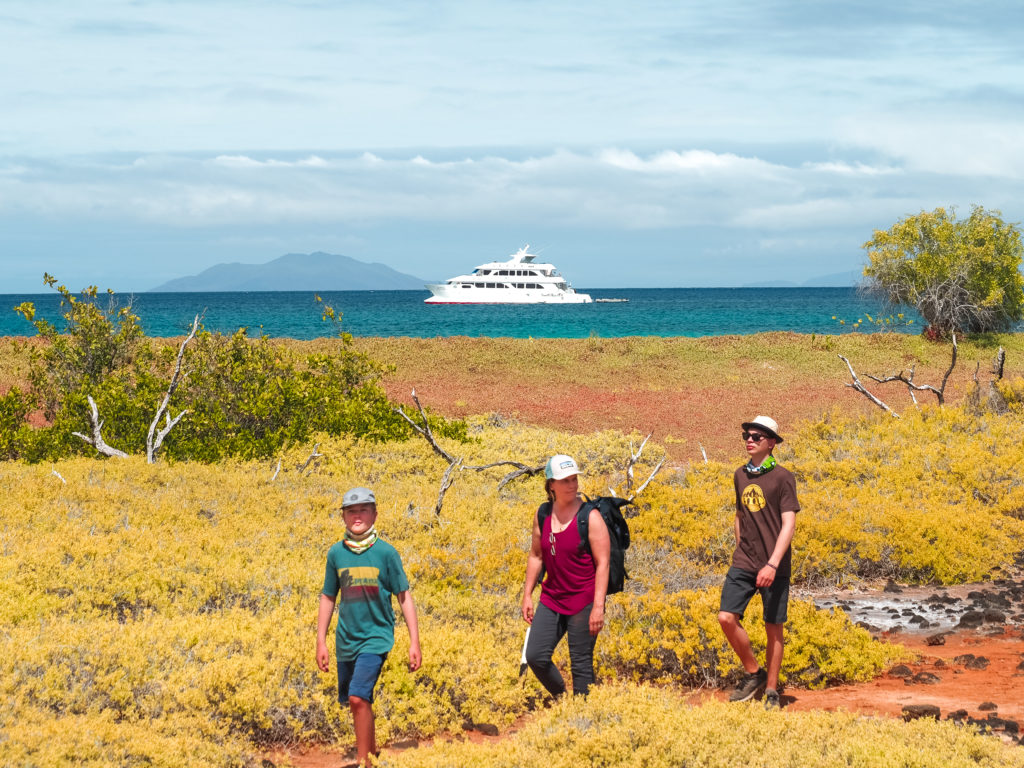
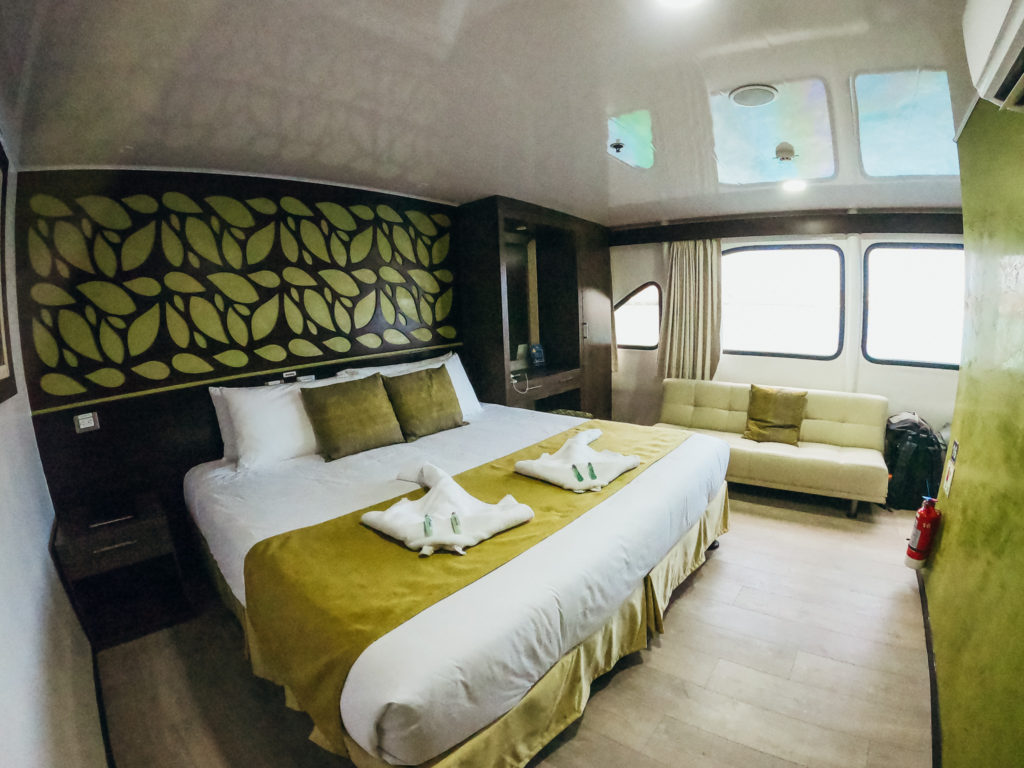
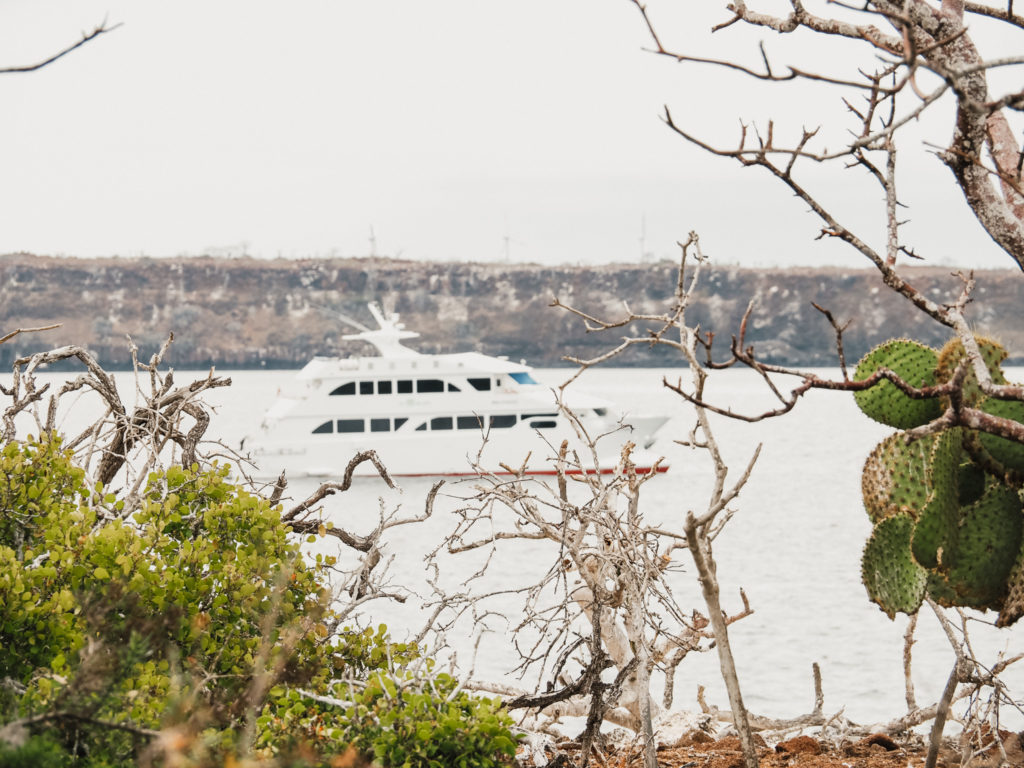
Each day on the cruise you stop at different places of interests on the islands. Depending on your schedule and itinerary, you might have longer travel times between destinations, however most of the “cruising” time happens at night while you are sleeping. This is great because it means more time on land to explore and spot wildlife, plus plenty of snorkeling and water based activities. Generally speaking, every day after breakfast is a land excursion for a few hours where you will walk/hike, and look for wildlife.
You will observe different kinds of iguanas (some endemic to the Galapagos), frigate birds, blue-footed boobies, flamingoes, pelicans, swallow-tailed gulls, Darwin’s finches, red-billed tropic birds, and more. There are also plenty of sea lions lazily sun bathing on the beach–such fun and curious creatures to watch in the wild. Probably the most significant thing about the wildlife in the Galapagos is they don’t fear humans–even the birds. They co-exist on these islands in peace and harmony because for hundreds of years the wildlife has been protected here, meaning they don’t feel threatened by humans!
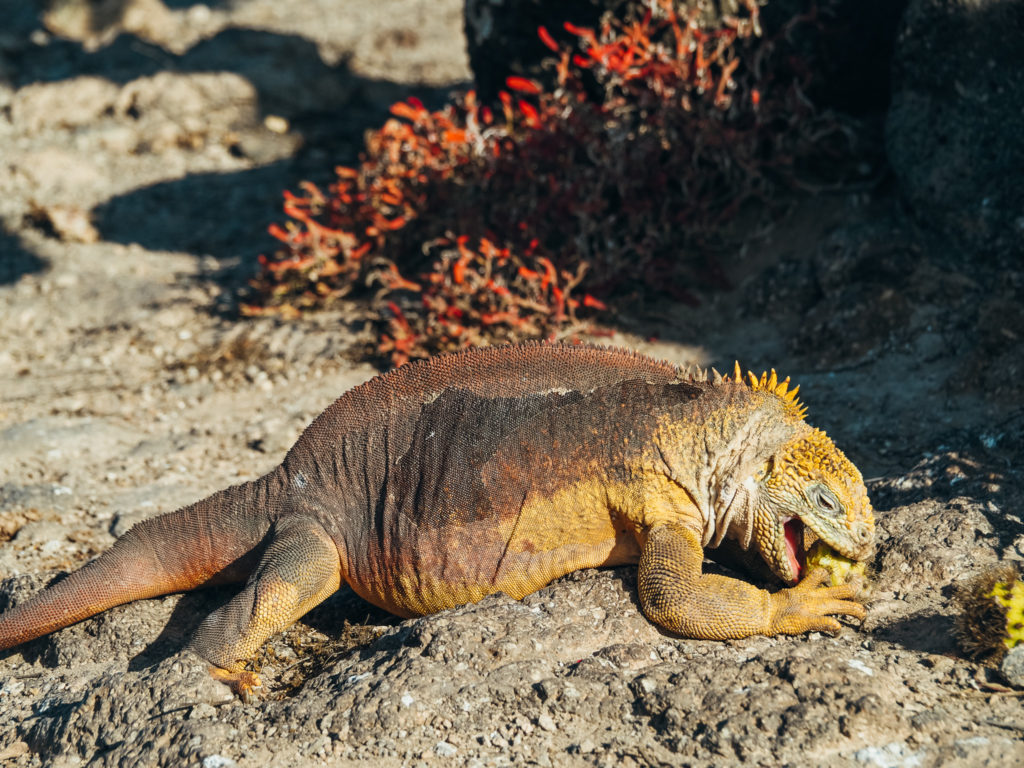
Typically after a land excursion with Galagents, the pangas (small boats) will take you back to the ship where you will eat lunch and have some down time on the boat before heading out for a sea excursion in the afternoon. Some days depending on the length of the land excursion though, you might do a sea excursion first, then have lunch and head to a different island for another land excursion later in the day. It is all dependent on your itinerary and schedule. Swimming with the marine life was the best part of each day on the cruise with Galagents.
Every day you are guaranteed to see a plethora of marine animals and tropical fish–from sea turtles, marine iguanas, sting rays and eagle rays, sea lions, and even sharks. We saw several white tip reef sharks, hammerheads, and even a Galapagos shark. The sea lions were probably our favorite though because they are so playful and curious.
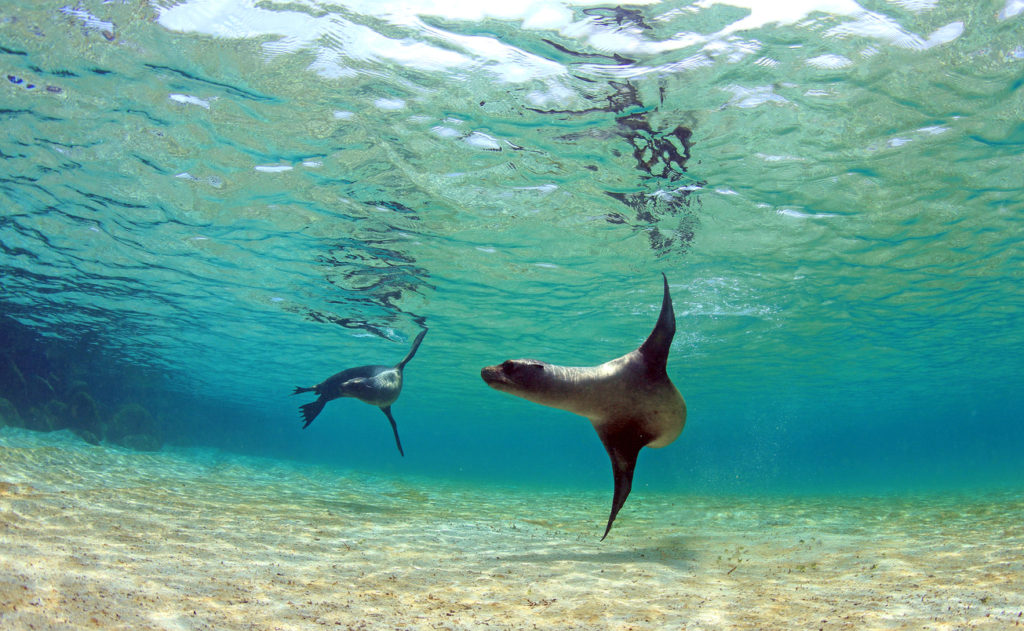
Living aboard a boat and cruising around the Galapagos is absolutely the best way to really experience these enchanting and unique islands because you see a side of the Galapagos that most don’t see. You get off-the-beaten-path and have a once-in-a-lifetime adventure that the whole family will never forget. For more information on your cruising options, including cost, what it includes, itinerary options, activities and more, make sure to check out the Ultimate Galapagos Itinerary.
If you decide against doing a cruise perhaps due to budget, no worries! You can still experience the magic of the Galapagos Islands via more land-based activities on the main islands of Santa Cruz, San Cristobal, and Isabela. We have included more information and details about the Galapagos in our comprehensive guide which covers what to do on some of the other islands, getting around (such as how to island hop), estimated costs for things like national park entrance fees, dining out, and MORE.
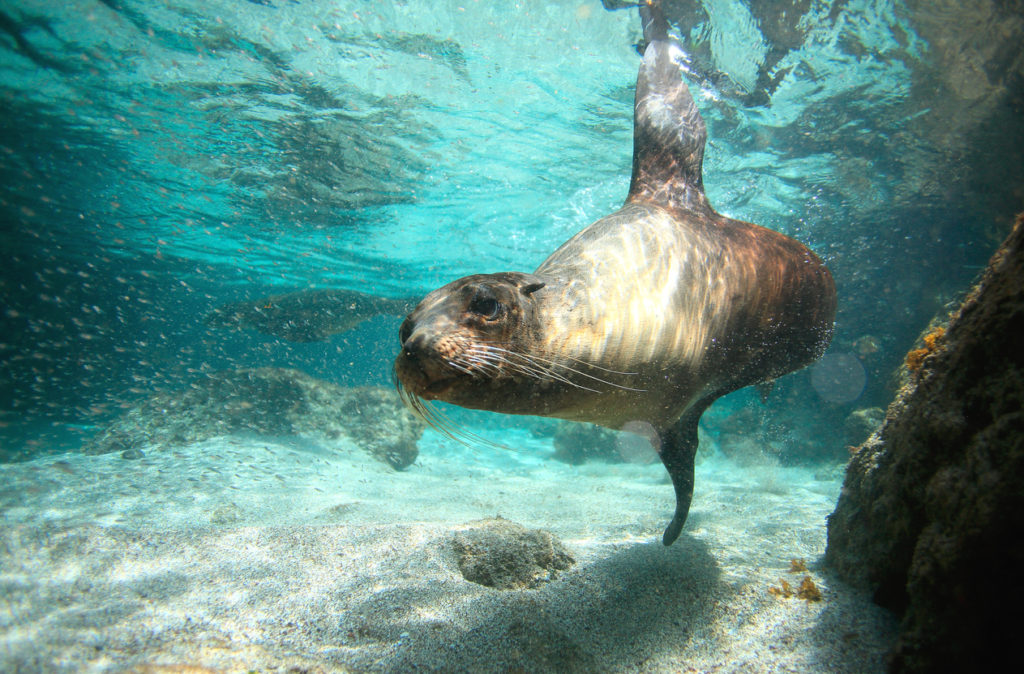
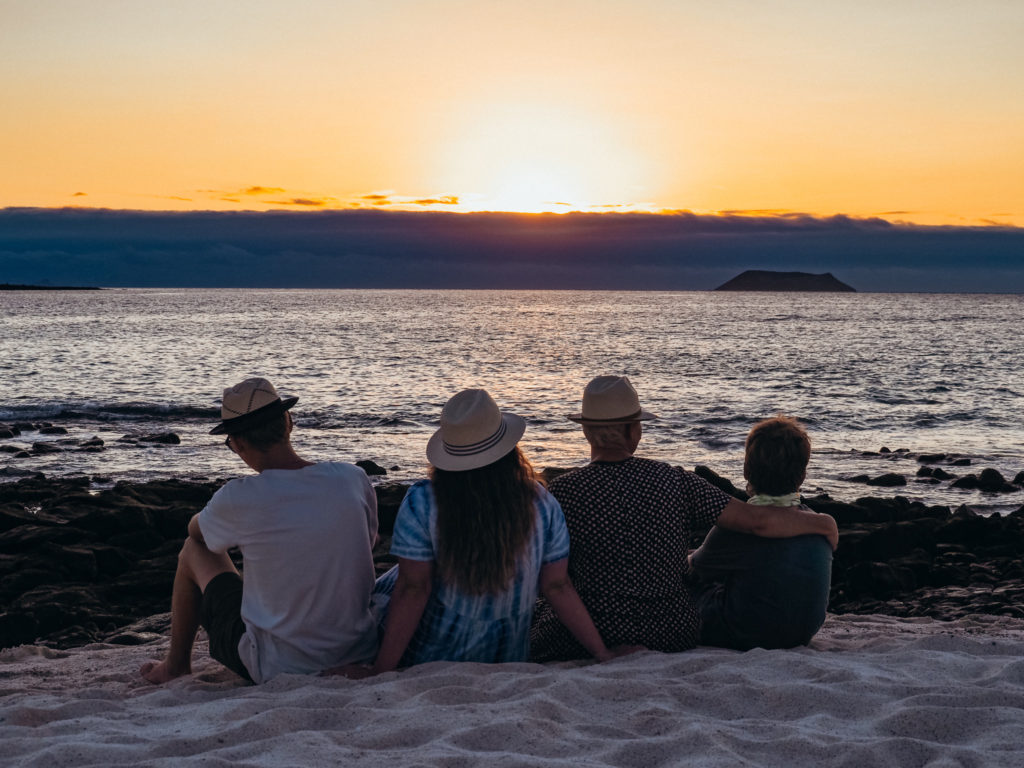
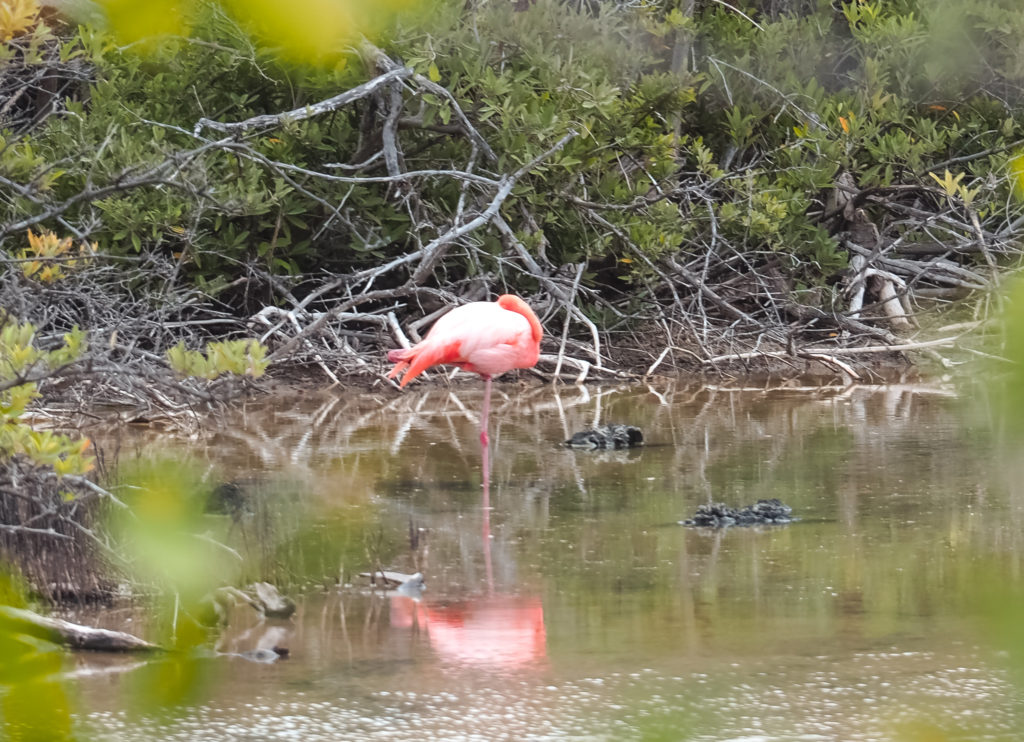
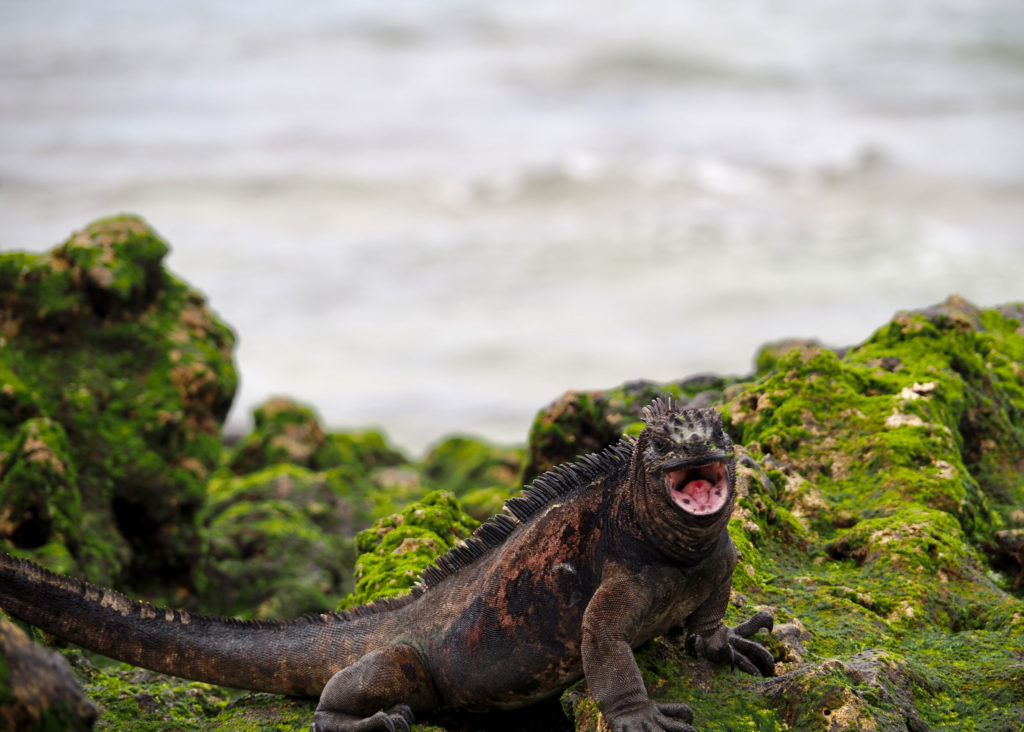
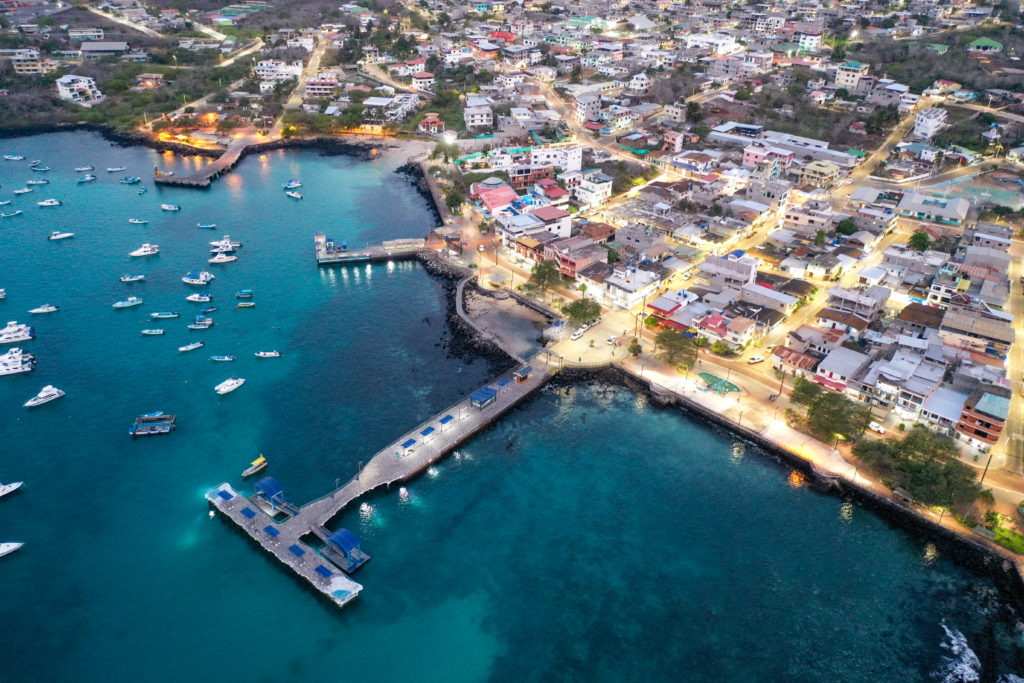
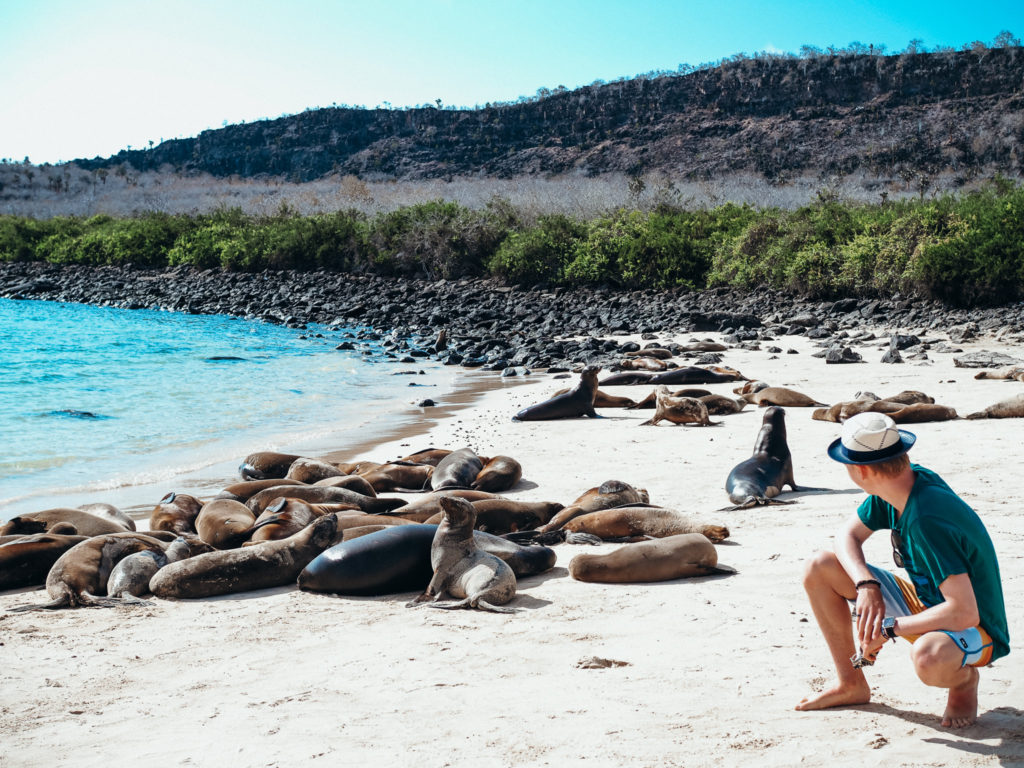
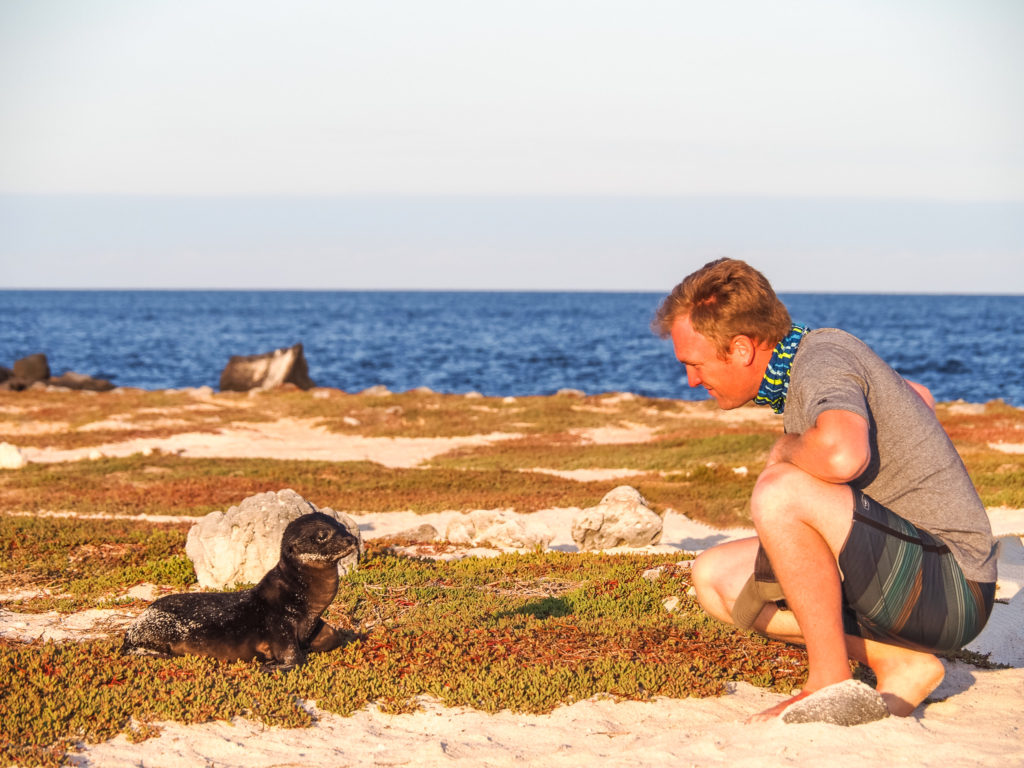
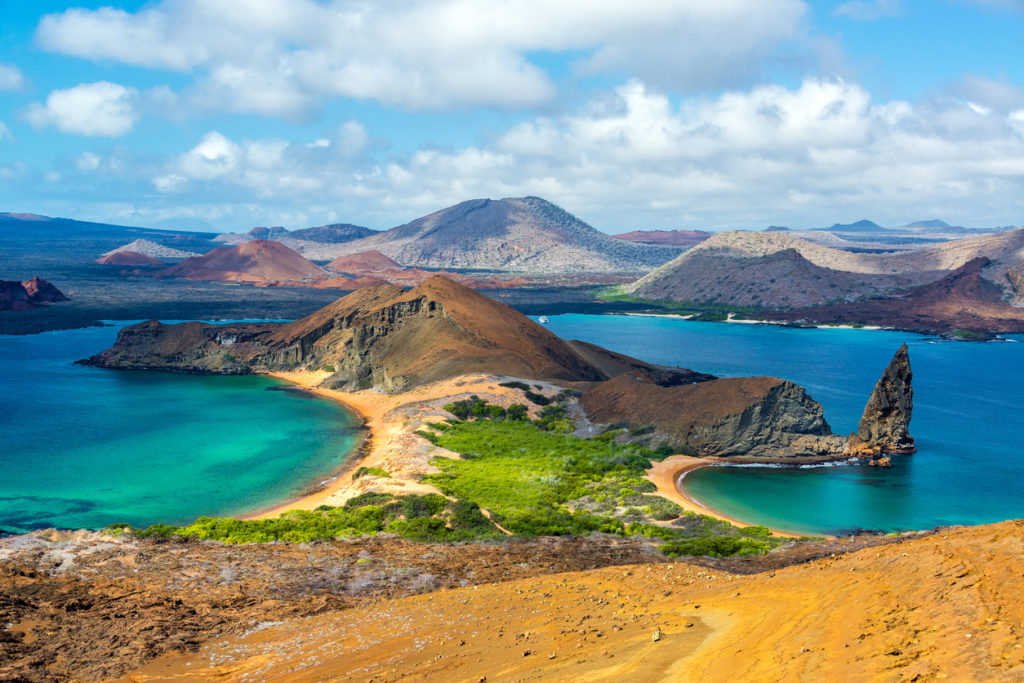
Ecuador is one of our favorite countries for a plethora of reasons–incredibly, diverse landscapes, wildlife, adventure, rich culture and history. We also love that it’s easy to get around since it’s such a small country! It’s one of those places that you want to return to over and over again because you just can’t get enough. If you want a unique trip of a lifetime, you don’t want to miss the best 2 week Ecuador itinerary which will give you a small taste of some of the most incredible places in all of Ecuador.
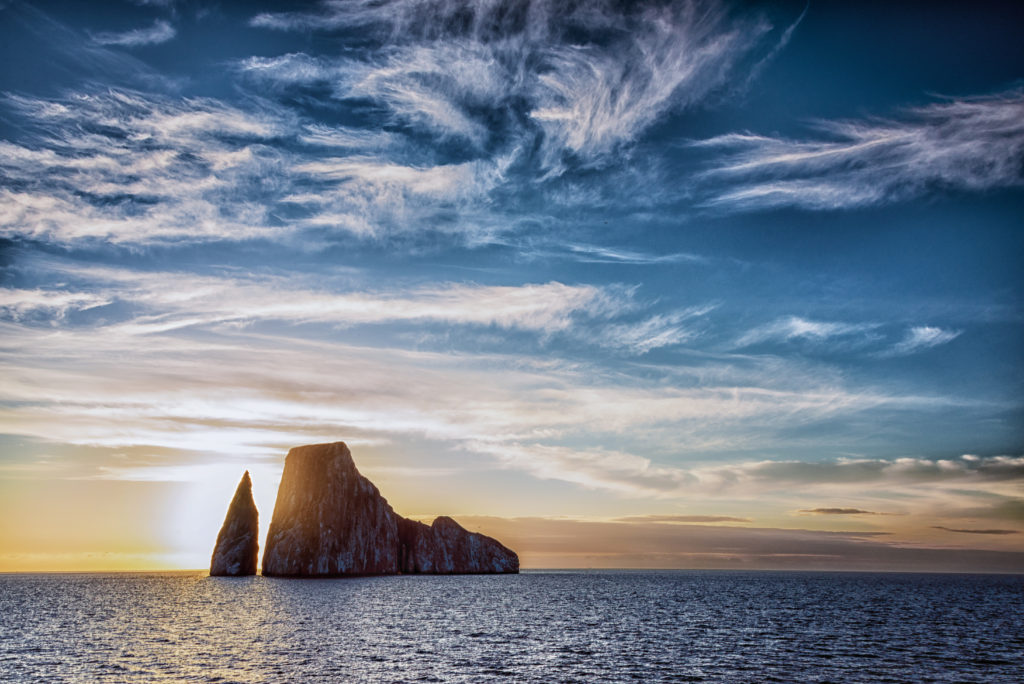
The Galapagos Islands are revered as one of the most unique places in the world and rightfully so. This volcanic archipelago lies 1,000 km off the coast of Ecuador in the Pacific Ocean and is considered one of the world’s foremost destinations for wildlife-viewing. Its isolated terrain hosts a diversity of plant and animal species, many endemic or found nowhere else on Earth. That’s why the Galapagos Islands makes for the ultimate trip with kids and a bucketlist destination for world travelers, as well as nature and wildlife enthusiasts.
We recommend spending at least two weeks in Ecuador if you can, with one week in the Galapagos Islands and one week on the mainland. Check out our two week Ecuador itinerary. However if you want to spend more than one week in the Galapagos, this article includes an itinerary for 2 weeks in the islands.
Here you can swim with a large variety of marine species–from hammerhead and white tip reef sharks, to sea lions, to tropical fish, to dolphins, to sea turtles. The waters in the Galapagos are brimming with life. If snorkeling or diving isn’t your thing though, no need to worry! On land you can also view a variety of mammals, birds, and reptiles such as giant tortoises, marine iguanas, blue footed boobies and more.
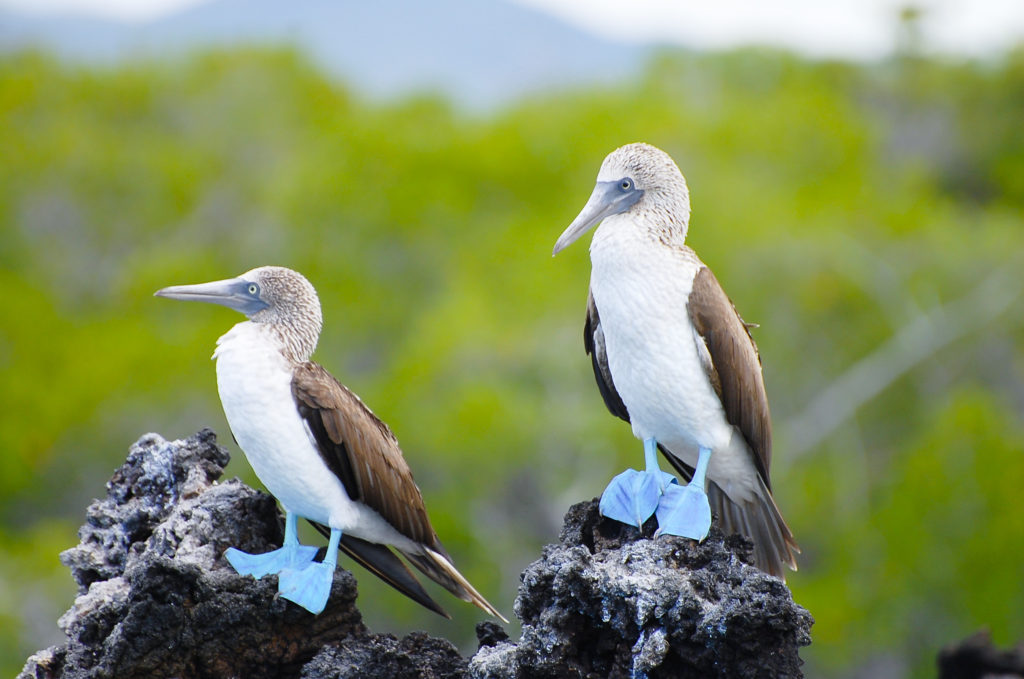
If you’re a big nature and wildlife lover, the Galapagos Islands will NOT disappoint. It is truly one of the most magical places we’ve ever been (and that’s saying a lot because we’ve been to a lot of amazing places!). The Galapagos is the perfect destination for families of all ages too–whether you have young or older children, you can find something for everyone to enjoy here.
The good news is there really isn’t a “bad” time of year to visit the Galapagos Islands. Wildlife sightings are plentiful all year. There are two main seasons in the Galapagos, cool and dry (June to November) and warm and wet (December to May). During the wet season it drizzles almost daily for a short period of time, however, ironically this is also the sunniest time of year. Ideally, the best time to visit the Galapagos Islands is from December to May if you want warmer, calmer seas and good underwater visibility.

December to mid-January are considered peak tourism season. As you get further into the new year (and away from the winter holidays), booking a trip to the Galapagos will get easier and cheaper. Perhaps some of the cheapest months to visit are March and April when the rainfall is the heaviest. If you’re willing to tolerate some afternoon showers, the affordability will make it worth it! Crowds are lower this time of year and the water visibility is also the clearest if you crave underwater adventures.
In the Summer months (June-August), expect prices and tourism to pick up as this is a popular time for school holidays and vacations. These months make up the Galapagos’ second tourism peak, so planning months in advance is highly recommended for the sake of both prices and availability.
Unfortunately, there are no direct flights to the Galapagos from any country in the world (except Ecuador). Getting to the Galapagos takes a bit of careful planning and time. In order to get to the islands, you must pass through one of Ecuador’s two main international airports, Quito or Guayaquil. From there, it is roughly a 2-3 hour flight to the Galapagos.
(*Side note: Quito tends to be a little cheaper, however Guayaquil is closer and many flights from Quito stop in Guayaquil en route to the Galapagos.)
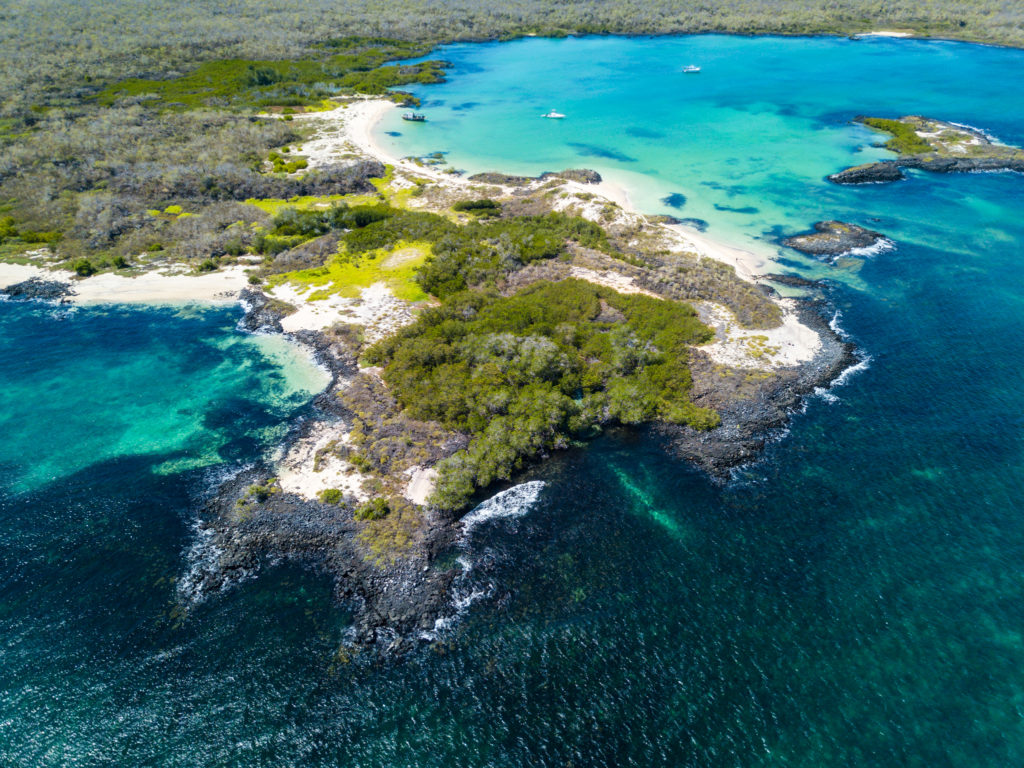
There are two airports on the islands, one in Baltra (the main one) and another on San Cristobal (Puerto Baquerizo Moreno). Most tourists fly into Baltra which is adjacent to Santa Cruz (a short 5 min ferry), the most popular tourist hub in the Galapagos Islands. Another reason Baltra is the go-to airport is because if you are going on a cruise, this is where you would start. You can book tickets through domestic airlines with LAN or Avianca. We use Sky Scanner and Momondo for finding the best deals on flights.
Flights to the Galapagos Islands from mainland Ecuador can range as low as $200 RT to more than $500 RT per person. It really just depends on the time of year you go and when you book your flights. Also, if you plan to visit both Santa Cruz and San Cristobal, book your flights into one airport (Baltra), but return from the Puerto Baquerizo Moreno airport on San Cristobal (or vice versa). This saves you time, money and a ferry back to Santa Cruz from San Cristobal and then a taxi and another ferry to Baltra. This is what we did and we are so glad we made that choice.
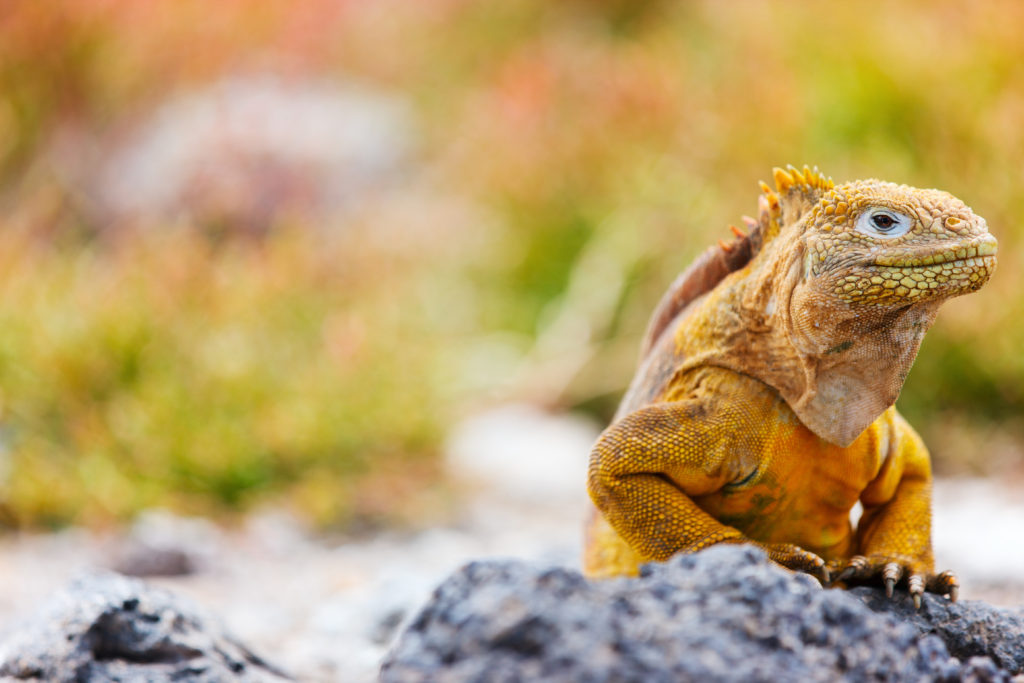
One of the hardest decisions when planning a trip to the Galapagos Islands is where to go. There are 3 main inhabited islands in the Galapagos that you can stay on–Santa Cruz, San Cristobal and Isabela. And then there’s also the option of “cruising” if you want to explore uninhabited islands and get off-the-beaten-path. After doing a lot of research and talking to both travelers who had visited the Galapagos many times, as well as locals, we decided that the best way to really experience these islands was by land and by sea.
If your budget and time allows it, we HIGHLY recommend doing a small cruise with Galagents Galapagos Cruises (more on that later) and then spending some time on one or more of the islands before or after your cruise. If you only have 1 week (7 days) in the Galapagos Islands, we would suggest doing one or the other–a cruise OR staying on two different islands. However, if you have 10 or more days in the Galapagos, we would recommend doing both (which is what we did).
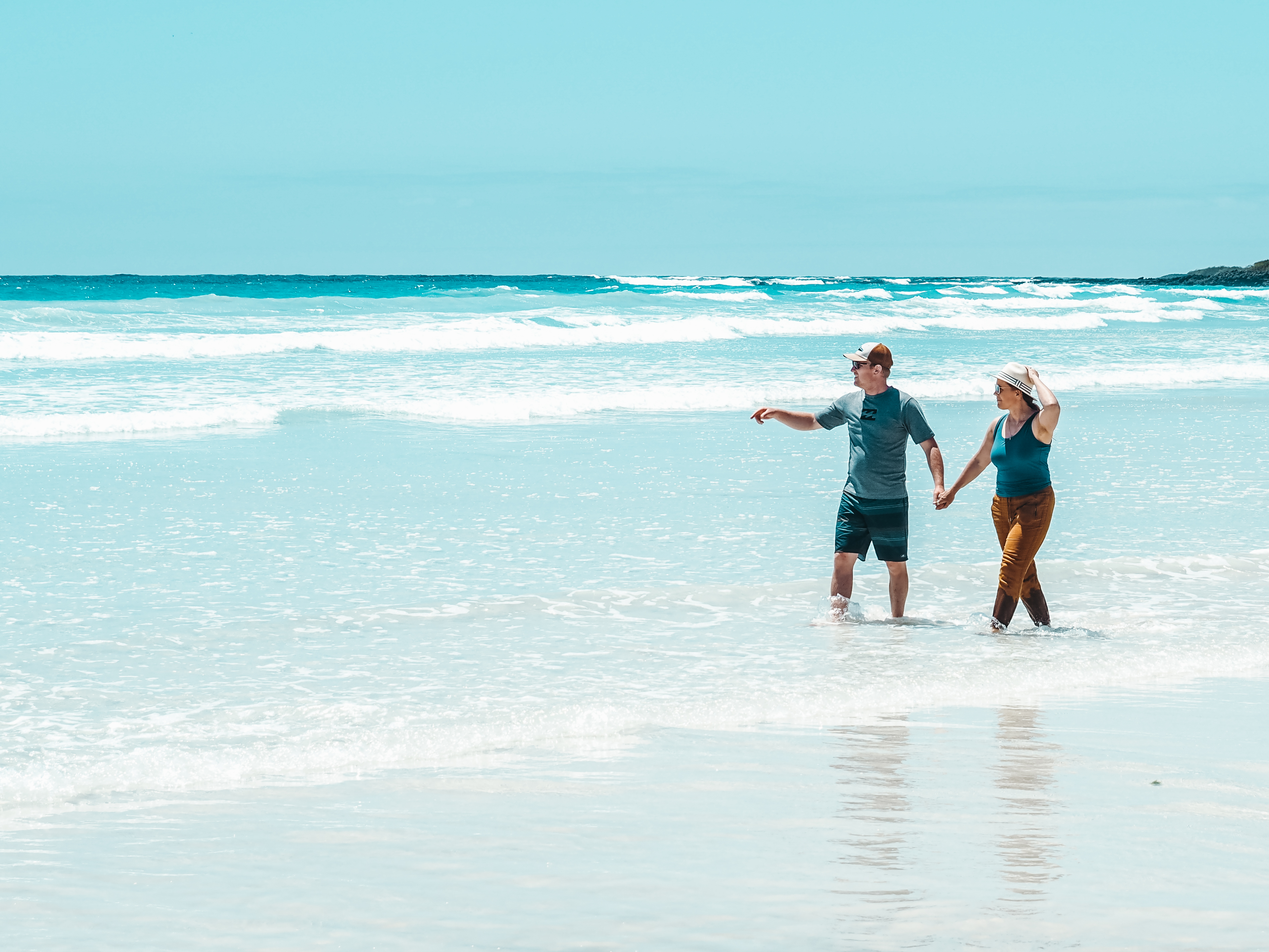
As mentioned previously, Santa Cruz is the main tourist hub, as well as the most populated island in the Galapagos. Puerto Ayora is the port city on the island where the largest variety of hotels, restaurants, tour companies and shops are located. It is also where you catch the ferry to San Cristobal or Isabella if you are island hopping. There are plenty of activities and places of interest on Santa Cruz, most notably the Charles Darwin Center, Fish Market, El Chato Tortoise Reserve, Tortuga Bay, and others. More on those later.
If you’re looking for ease of access, lodging options for every budget, and a variety of activities and interesting, natural places to explore, Santa Cruz might be your best bet. Here you have the biggest variety of accommodations ranging from hostels, B & B lodges, high-end hotels and resorts, as well as Airbnb’s. Our top choice in Santa Cruz is the Royal Palm Hotel, located in the highlands away from the hustle and bustle of Puerto Ayora. It is peaceful and beautiful, private and spacious, and offers great amenities for nature lovers and people who want to get away from it all.
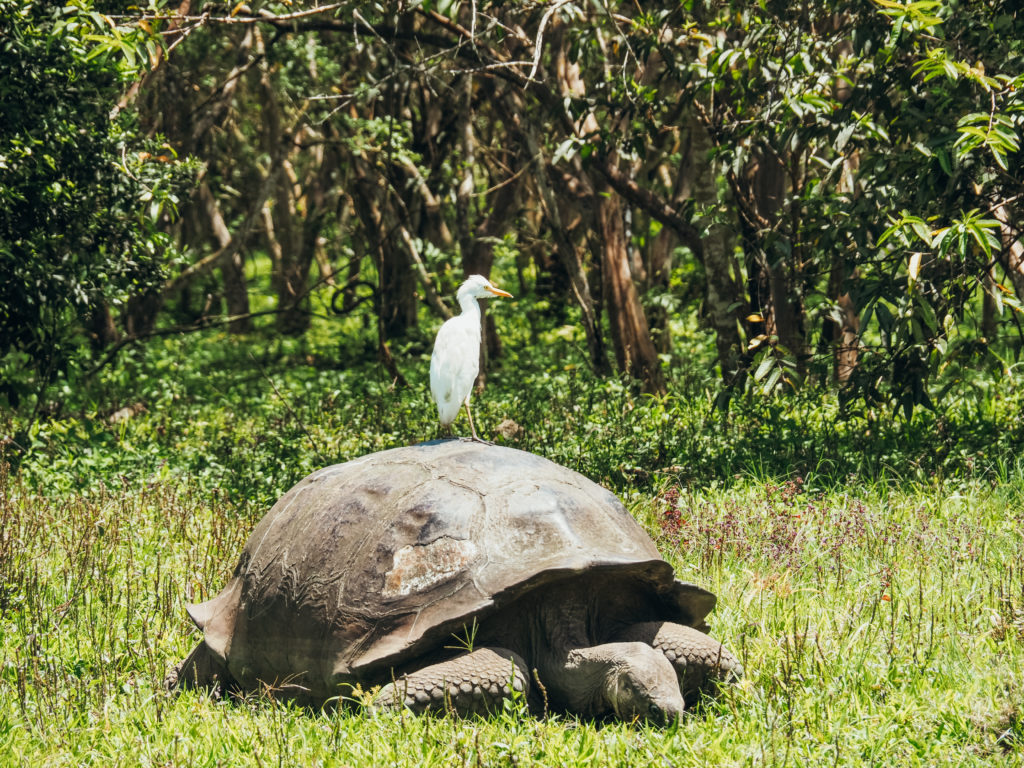
A 2 hour ferry ride (or a short puddle jumper flight) from Puerto Ayora lies San Cristobal, the easternmost island in the Galapagos archipelago, as well as one of the oldest geologically. The biggest draw to this island is the famous Kicker Rock (one of the premier scuba dive and snorkeling spots in all of the Galapagos), Isla Lobos, Cerro Brujo and El Junco Lagoon. It is also the only island in the Galapagos where you can find three different species of booby birds and home to another tortoise breeding center, La Galapaguera.
San Cristobal also hosts the Interpretation Center which far exceeds the more popular Charles Darwin Research Station on Santa Cruz. Lastly, if you love to surf, San Cristobal is probably your best option for awesome surfing, Namely the beach of La Loberia. We used Booking.com to find lodging here and loved staying in Cactus Hotel. Very affordable, clean, friendly and helpful staff, and right in the main town!
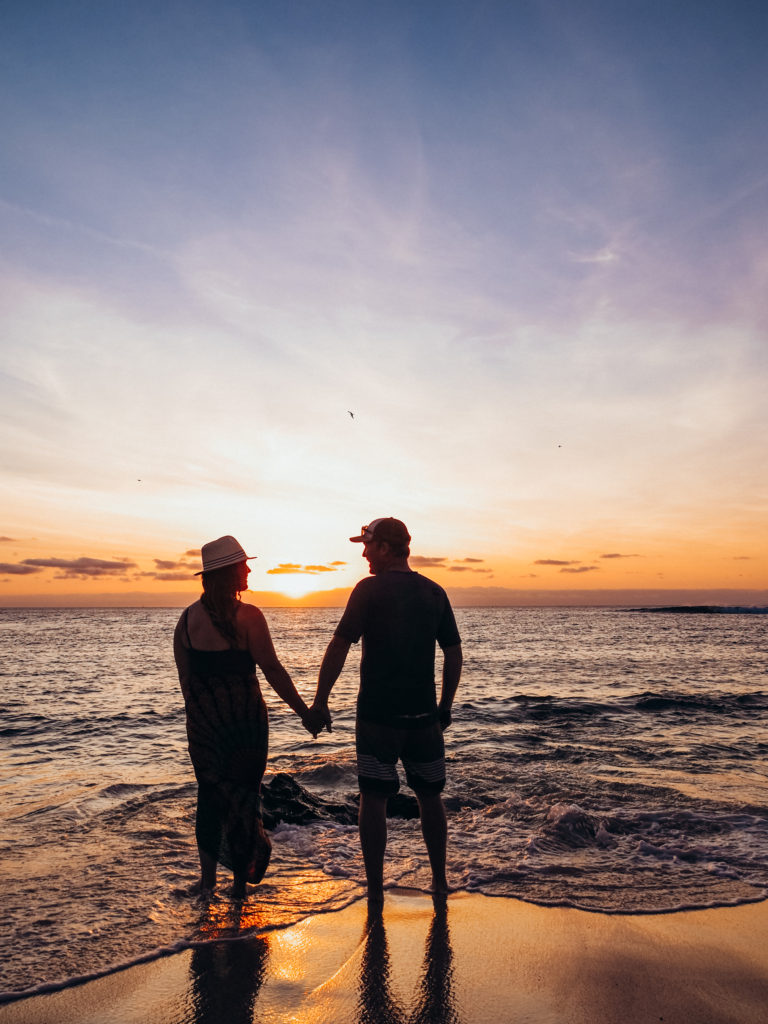
Isabela is the one island we were hoping to visit while in the Galapagos, but due to the logistics and timing of getting there from Santa Cruz, it didn’t work out. Many locals told us that Isabela was their favorite island and for good reason: it is the most unspoiled of all the inhabited islands. It is also the largest and the most volcanic of all the islands!
Despite being the largest island by area, Isabela is home to just over 2,000 residents, but that’s what makes it the ultimate Galapagos paradise, where nature and wildlife dominate the landscape! Due to its location, Isla Isabela is not always visited on Galapagos cruises or included in Galapagos tour itineraries, making it a bit more isolated and remote.
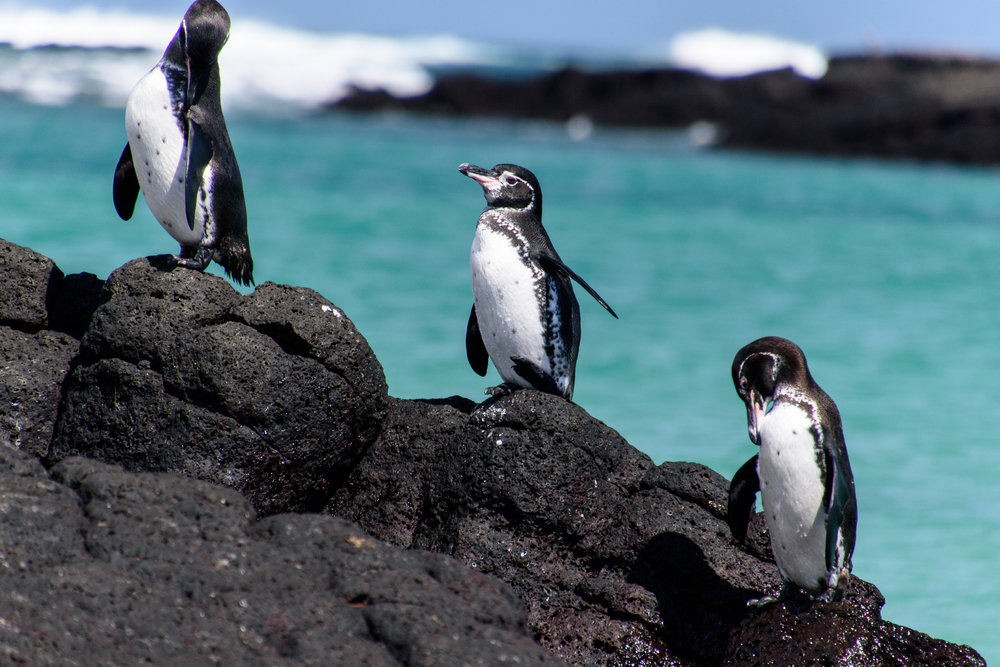
Some highlights of Isabella include seeing penguins and other wildlife at Las Tintoreras, Los Tuneles (a premiere snorkeling destination on the island), Cerro Negro volcano and others. With less accommodation options on Isabela compared with Santa Cruz or even San Cristobal, you might spend a little more money, however there are still plenty of hotels to choose from for every budget on booking.com.
We would personally recommend staying at Flip Flop House or the Isabela Beach House, both in Puerto Villamil. To get to the island of Isabela, one must either take a small puddle jumper flight or take the ferry from Puerto Ayora (the cheaper option), both on Santa Cruz.
One of the biggest questions people ask when it comes to planning a trip to the Galapagos is, “How much will it cost?” While that is a difficult question to answer, a trip to the Galapagos really depends on several factors (time of year, flights to Ecuador from different countries around the world, type of lodging, cruise or no cruise, etc), we would say plan on budgeting at least $2K per person (for a mid-range price trip).
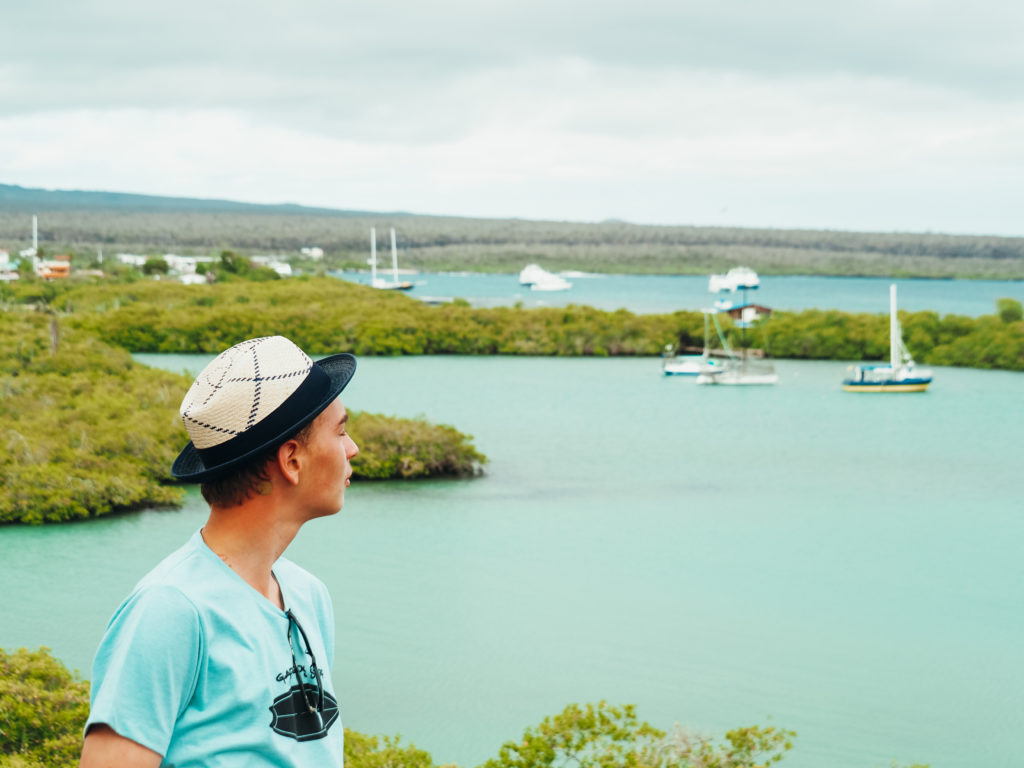
You’re probably thinking, “Wow! That’s expensive!” But the fact of the matter is, the Galapagos Islands isn’t exactly known as a budget-friendly destination. And that’s mostly due to the fact that just getting here isn’t cheap. Flights from the States will cost at least $500 RT and that doesn’t include the flight from mainland Ecuador to the Galapagos. And then you have mandatory entrance fees (see below), which add up to $120/person.
So in reality, the cost of entering and leaving the Galapagos could be close to $1,000. Then you have to factor in accommodations, transportation around the islands (taxi, ferry etc), food, activities, and/or perhaps a cruise.
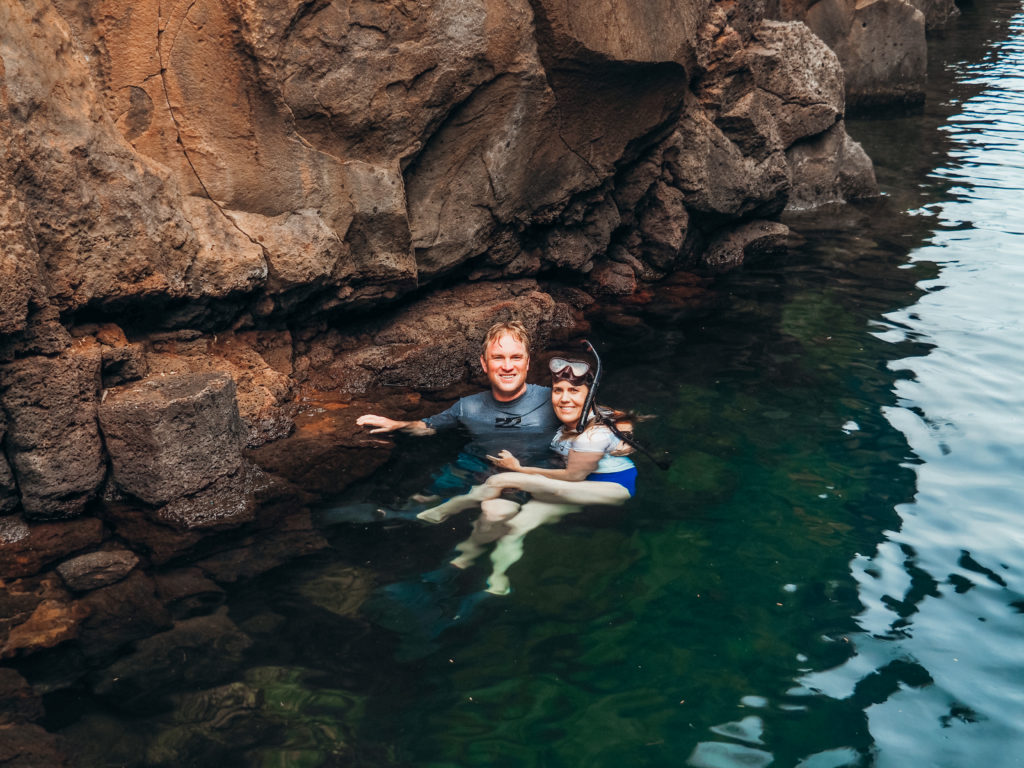
Now there are ways to make a trip to the Galapagos cheaper. For example, stay in hostels, or rent a modest Airbnb and cook your own meals. There are also plenty of FREE or nearly free activities to do on the islands, like go to the beach. However, anything inside the national park requires a guide and if you want to do any excursions to snorkeling spots away from the beaches or to other islands, that will also require a guide and added fee.
Now if you choose to go on a cruise, that could cost more unless you are only going to the Galapagos for a cruise and not spending any extra time on the islands. Cruises also range greatly in price from as low as $1,000 per person up to thousands for some luxury yachts and ships. With Galagents Galapagos Cruises, they offer the whole range of pricing options from budget up to luxury. Keep in mind that cruises cover ALL of your meals, a guide, excursions, equipment (such as snorkel), etc.
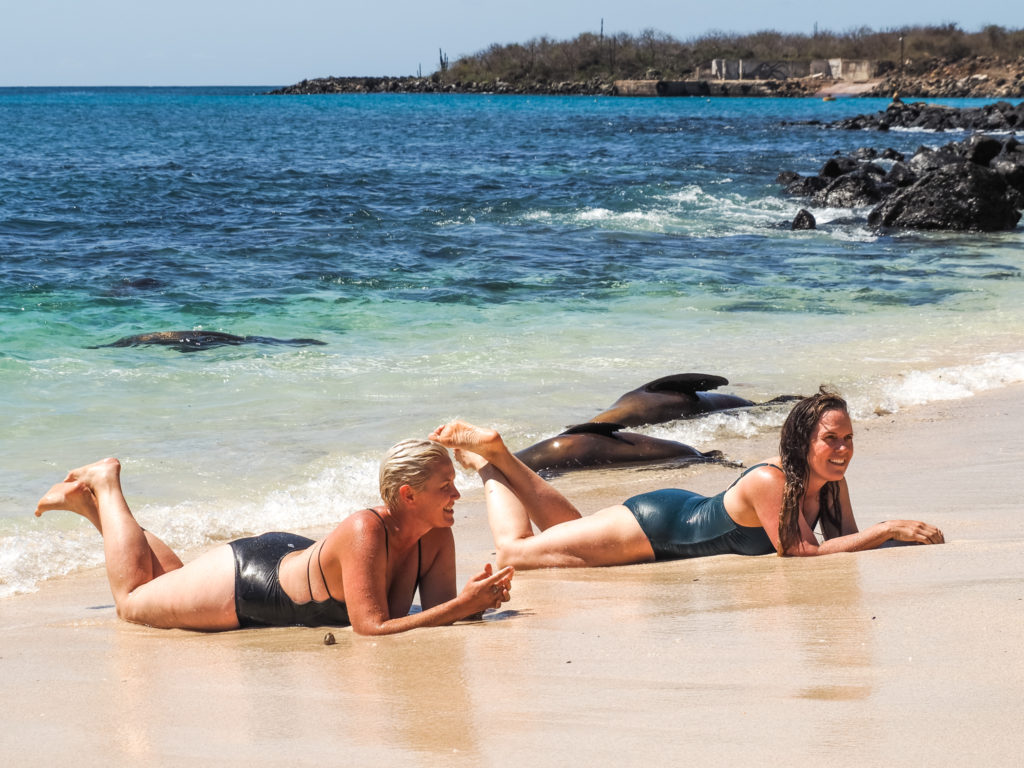
Ok, now let’s talk about entrance fees. When you enter the Galapagos Islands, there are two mandatory fees that all tourists must pay. These fees largely help cover efforts by the Ecuadorian government to preserve and protect the islands from humans harming its fragile ecosystem. The first fee is called the TCC or Transit Control Card which is $20/person. Visitors must pay this fee at a booth in the airport (Quito or Guayaquil) with their plane tickets to get the card (cash only).
The second fee is the Galapagos National Park entrance fee of $100/person. The amount of this fee depends on the age and nationality of the tourist. Most foreign tourists over the age of 12 pay $100, while children pay $50. Although an extra $100 may seem like a lot of money, rest assured that the fee is for an indispensable cause. By visiting the islands, you are also contributing to the conservation efforts protecting the enchanting Galapagos Islands.
*Note: If you are traveling to the Galapagos during Covid times, it’s important to know that Ecuador is following every precaution and biosecurity measure to ensure tourists and locals stay safe. You can read all about Covid requirements to travel to Ecuador and the Galapagos here or here.
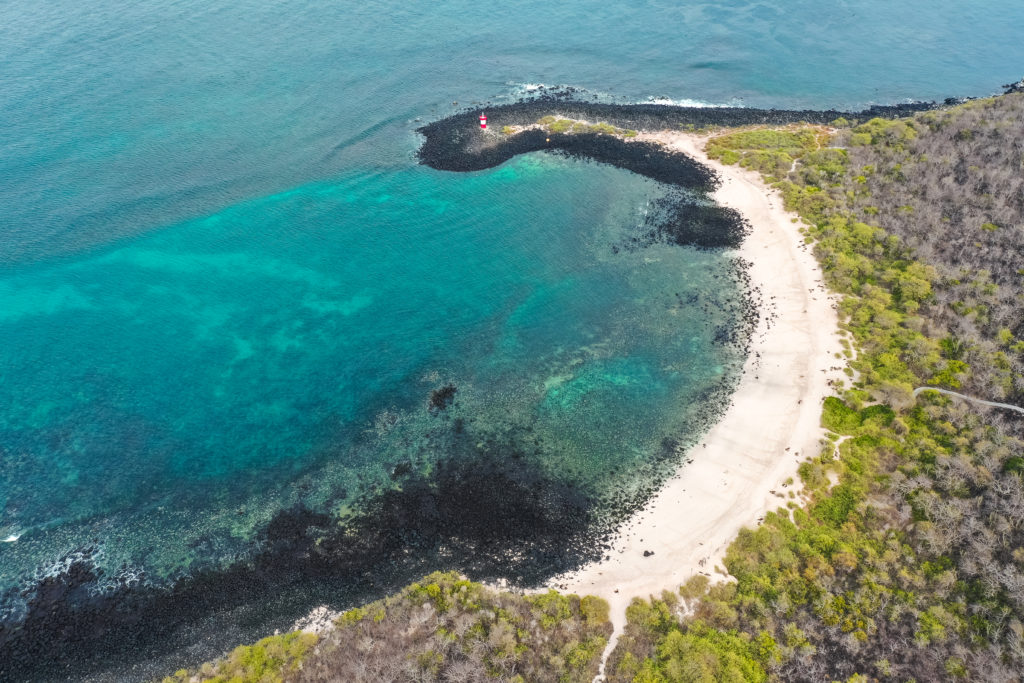
Keep in mind that the ultimate 14 day Galapagos trip with kids itinerary includes time on 2 different islands, plus a 5 day cruise. This itinerary can be adjusted to suit your needs. For example, if you decide not to do a cruise, you can shorten your stay to 7 days or choose to visit some of the islands longer. Alternatively, if you only wanted to do one week in the Galapagos and one week on the mainland of Ecuador to visit places like the Amazon, or the Andes, check out our two week Ecuador itinerary.
Assuming that your flight arrives in Baltra, you will spend the next 3 days on the island of Santa Cruz. Since Baltra is on a small island adjacent to Santa Cruz, once you leave the airport you will need to take the shuttle bus or a taxi to the port to catch the ferry. Or if your hotel provides a shuttle, arrange that with them. The ferry ride to Santa Cruz is only 5 minutes.
We mentioned earlier that our top choice for accommodations on the island of Santa Cruz is the Royal Palm Galapagos Hotel. It is located in the beautiful highlands of Santa Cruz on almost 200 acres of forest overlooking the valley and ocean. The Royal Palm mainly consists of private villas of different sizes to accommodate couples or families.
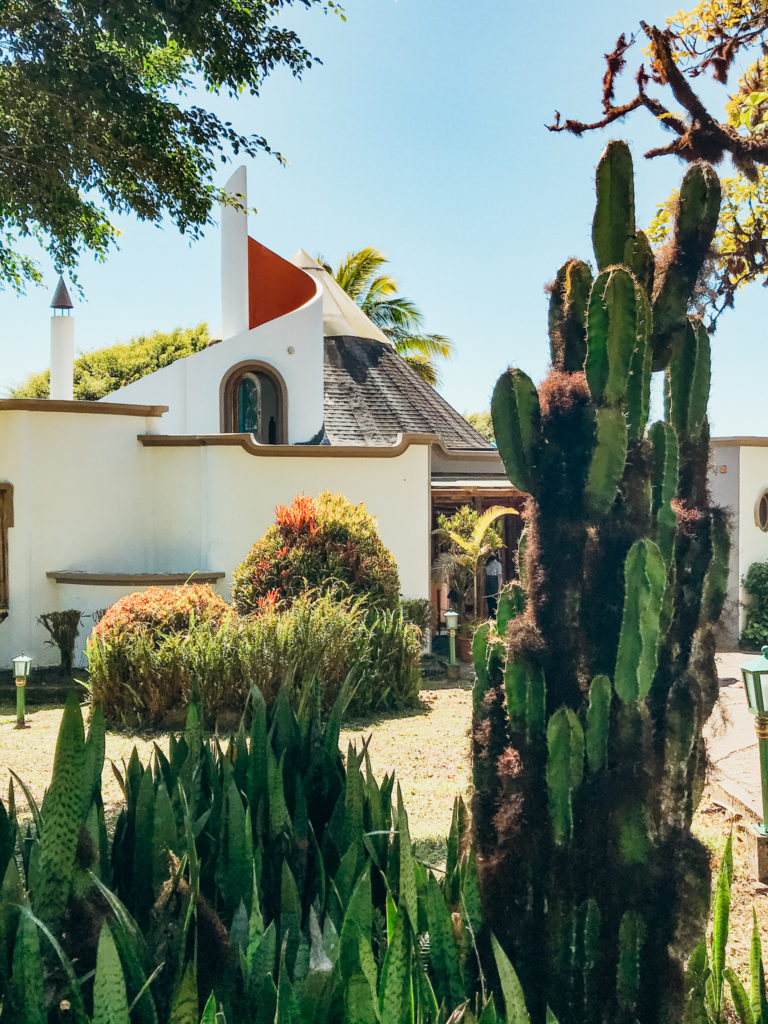




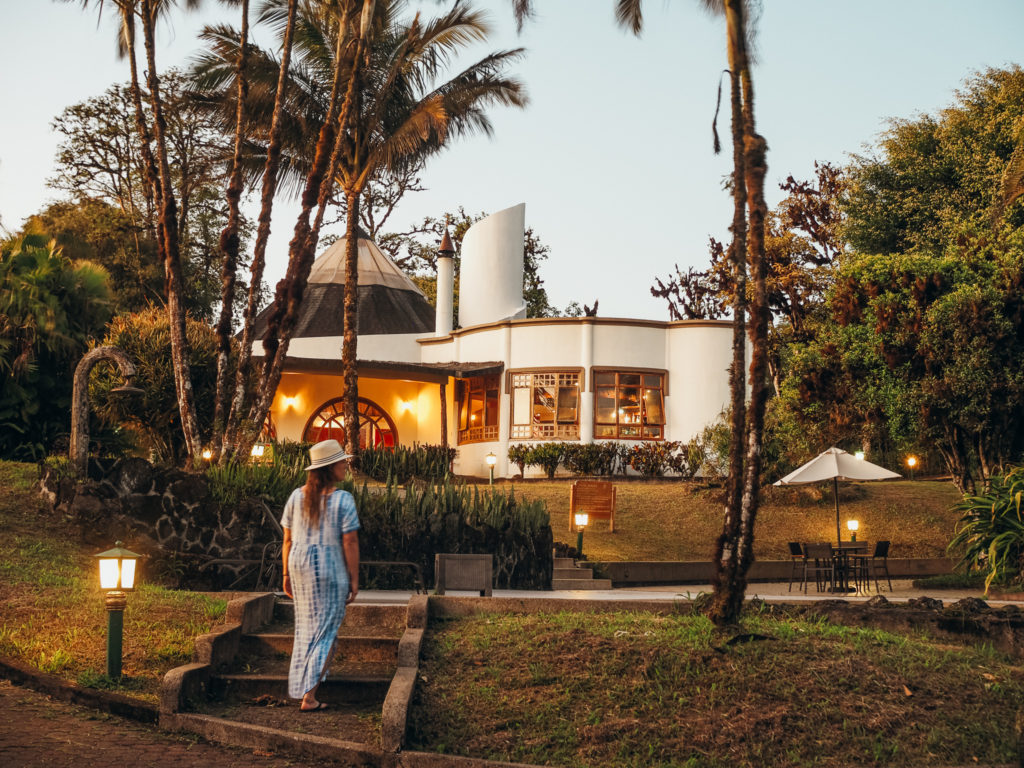
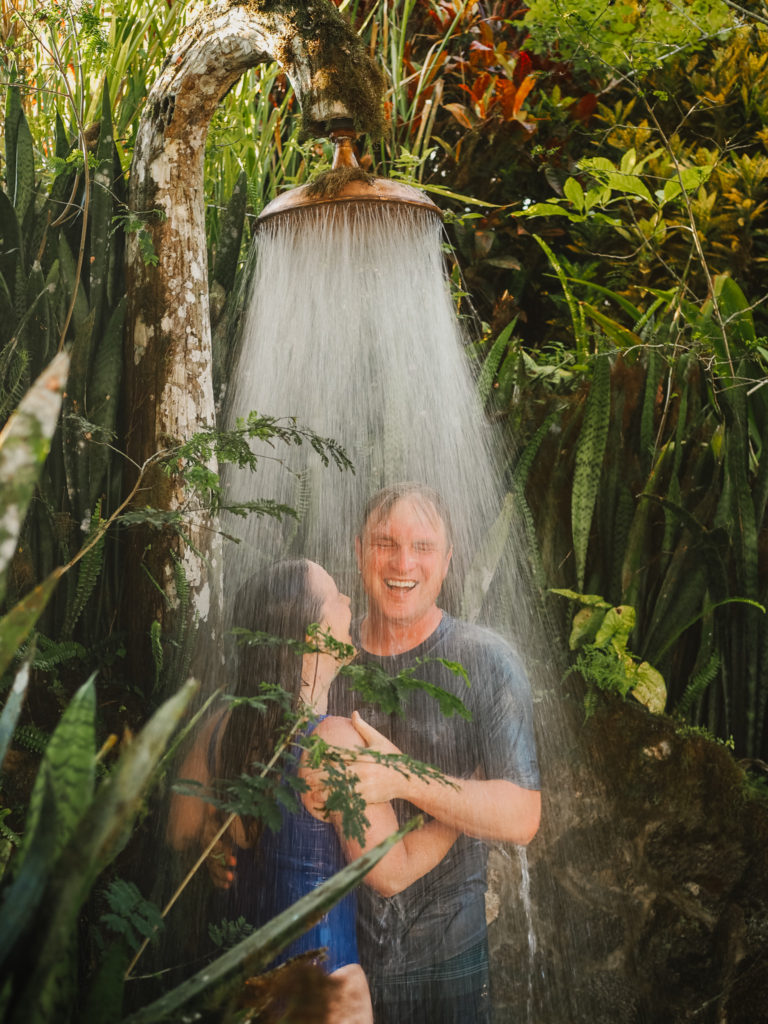

All your meals are included with your stay at the Royal Palm, and the food is delicious! The staff goes above and beyond to give you the “royal” treatment and ensure that every need is catered to. There is a pool and outdoor shower and the grounds are beautifully landscaped. One of the things we loved most about the Royal Palm was all the walking trails! Each villa has full privacy and incredible views, especially of the sunset every night. The Royal Palm is truly a garden oasis and the best part is it is moderately priced too.
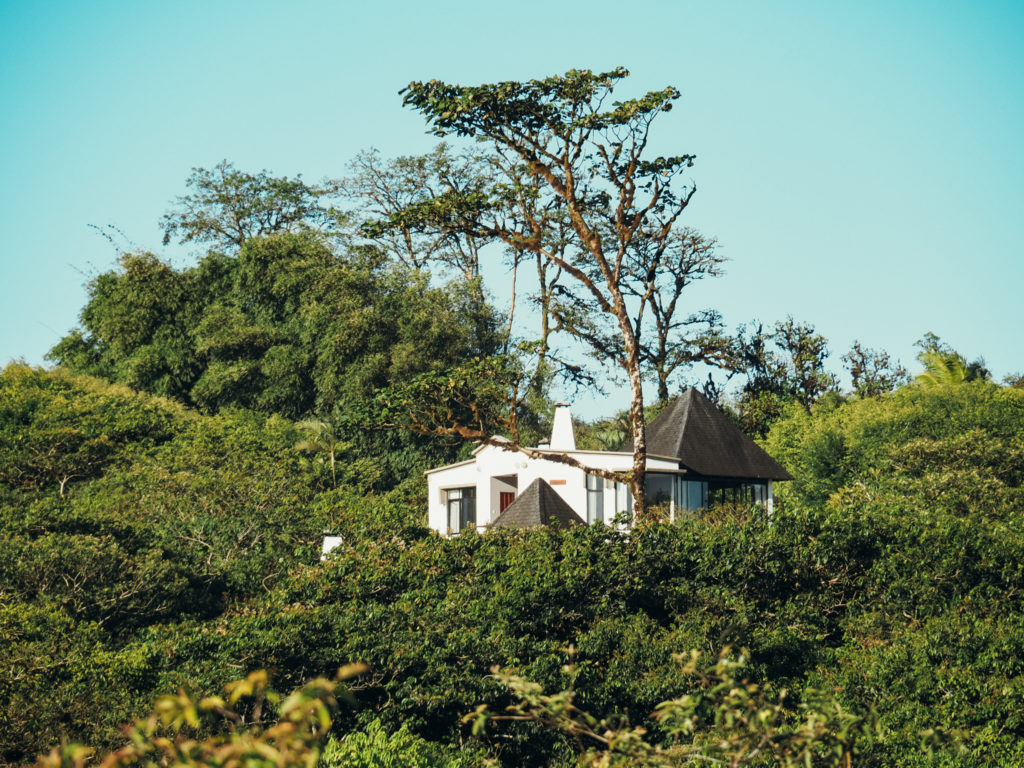
We also love that Royal Palm strives for sustainability practices to ensure they make the lowest impact on the environment. Another bonus of staying at the Royal Palm is their property boasts the largest lava tunnels in all of the Galapagos! A staff member can provide a guide (along with safety equipment) and take you through the lava tunnel which is quite the adventure! You can’t miss it!
In addition, Royal Palm is located near two giant craters and a giant tortoise reserve, which make a perfect destination if you love nature, tranquility and scenic vistas. And when you want to go to Puerto Ayora, it’s only a 25 min drive by taxi into town.
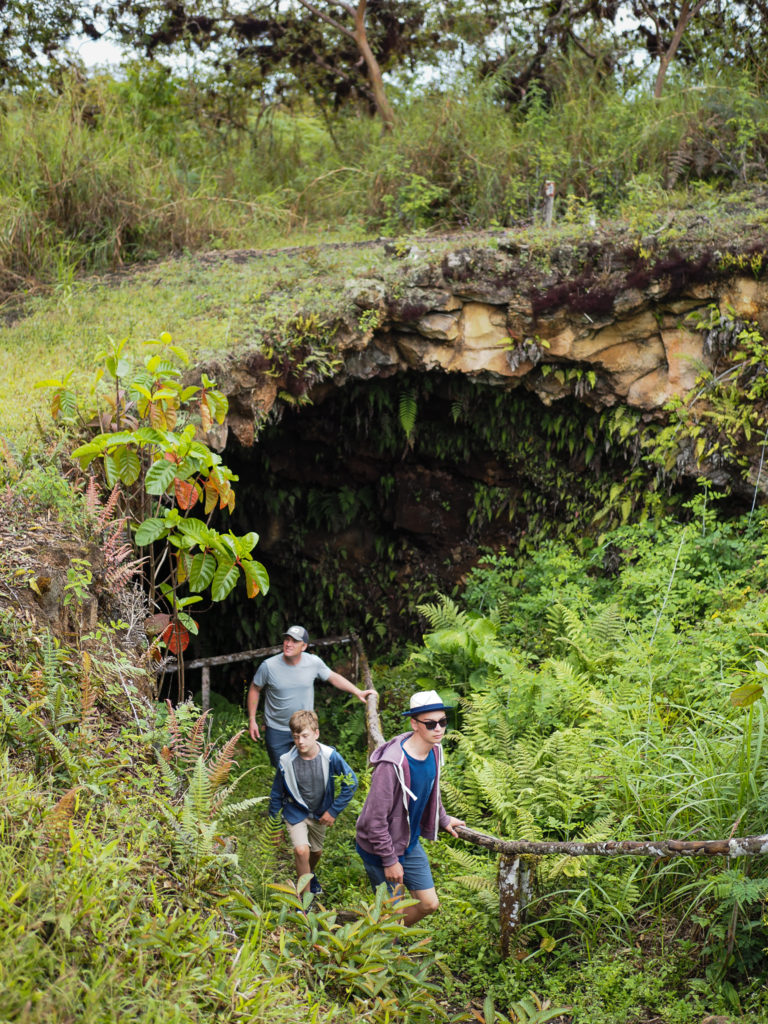
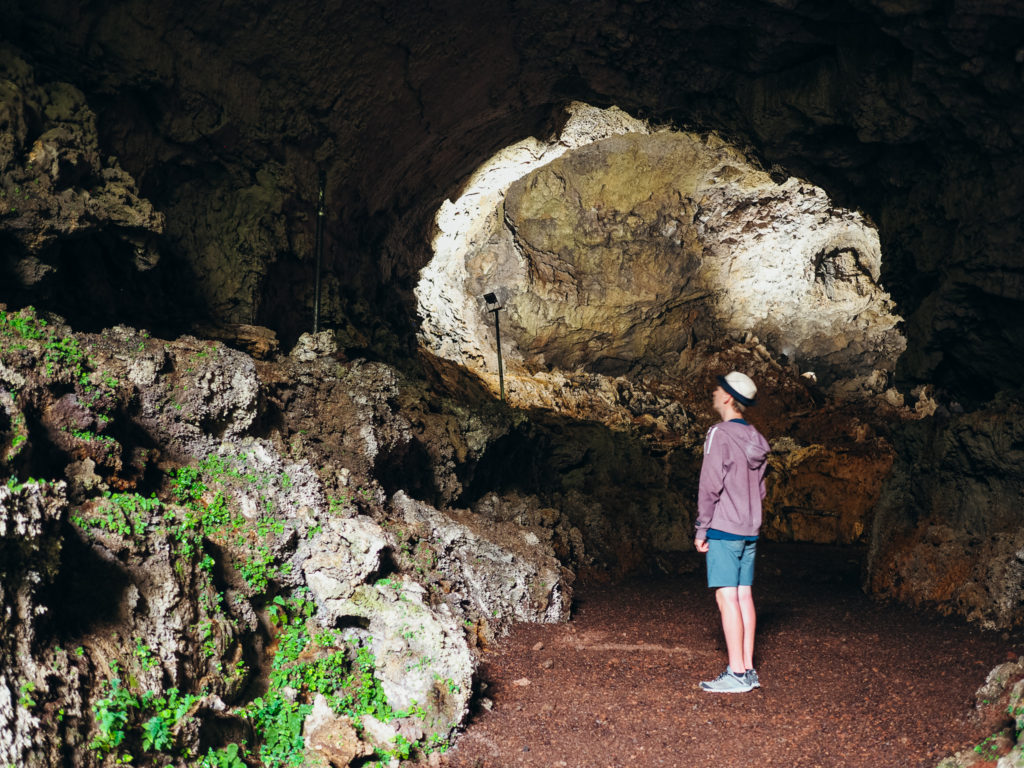
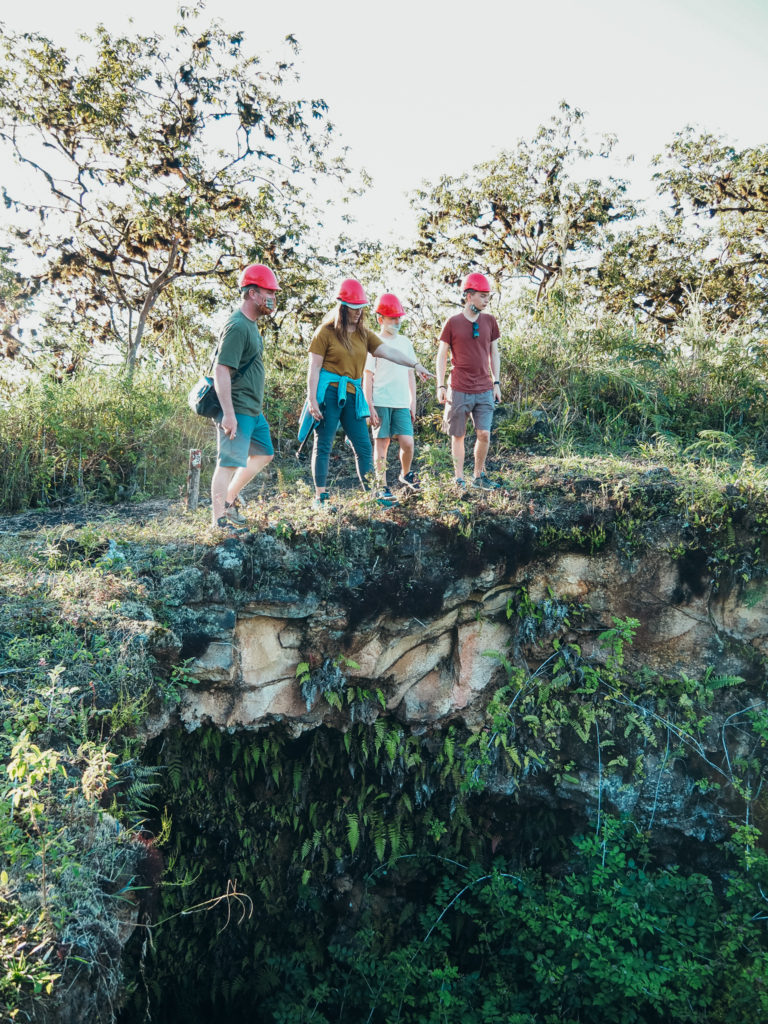
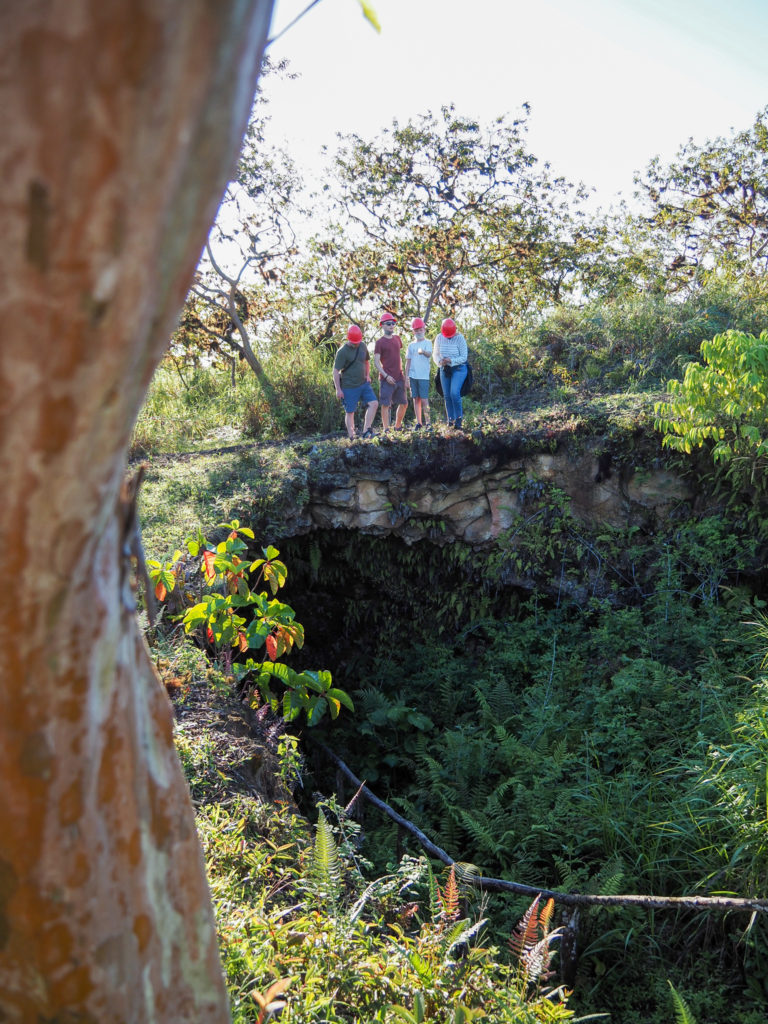
With only 3 days in Santa Cruz, you don’t have a lot of time to see ALL of the highlights of this island, but you can definitely see some of the best spots of Santa Cruz in just a few days. We would recommend spending one full day biking to El Chato Tortoise Reserve (or hiring a taxi), and checking out the lava tunnels and craters on the island. We loved biking from Royal Palm to El Chato (they provide bikes and helmets) because it was mostly downhill! Once at the tortoise reserve, we spent at least 2 hours walking the trails spotting dozens of giant tortoises. We even saw some mating!

We would suggest not rushing through this reserve as it is very beautiful and fascinating to watch the tortoises in their natural habitat. The owner of the reserve was very informative and helpful. We learned a lot about these incredible creatures that can live over 200 years old and weigh up to 700 lbs. El Chato Reserve is a great place to take kids and a definite must when you come to the Galapagos! And if you have the time, make sure to visit Pit Craters and Los Gemelos craters which are near El Chato Reserve. The best part about all of these activities is they are cheap or free!
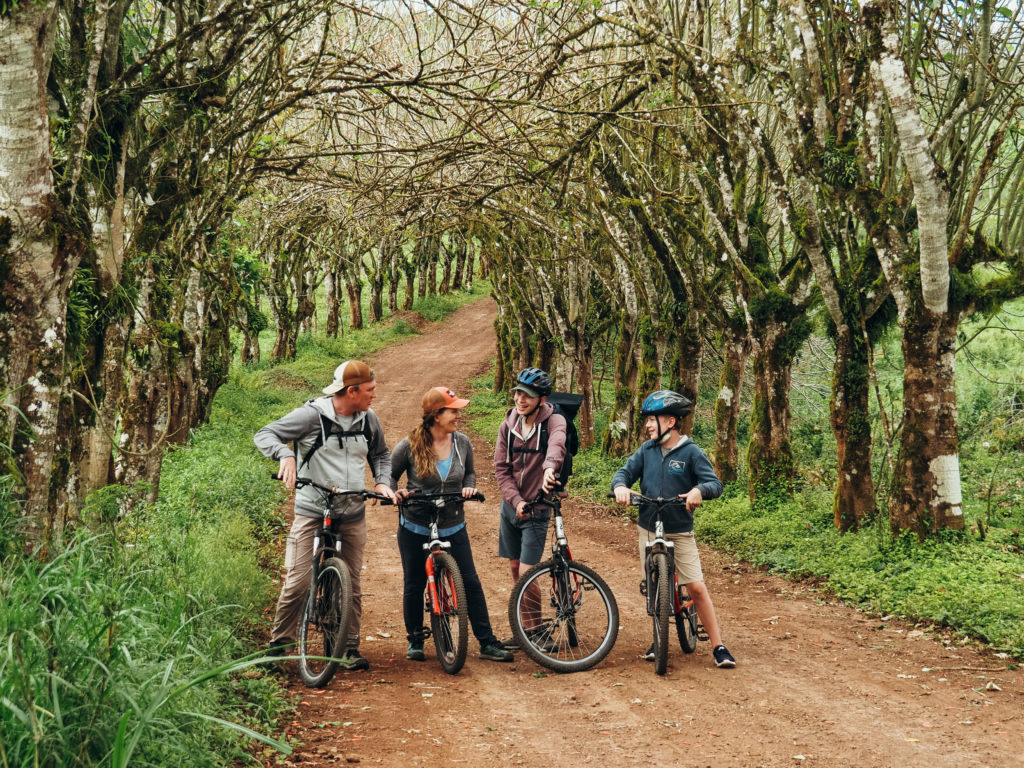
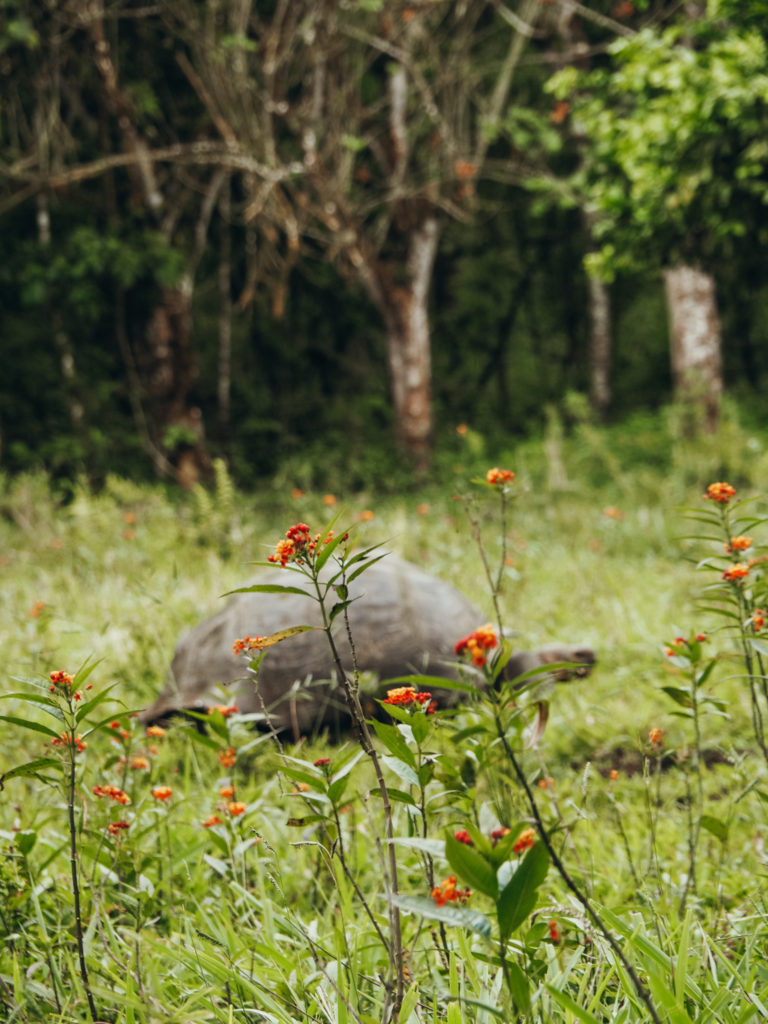
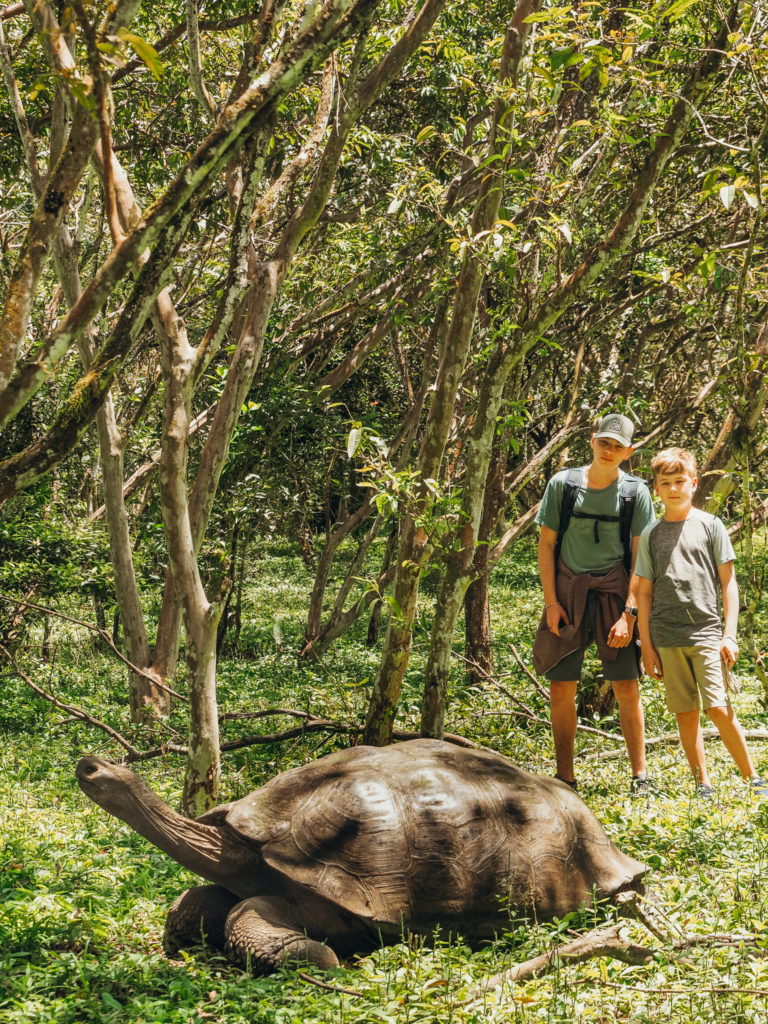
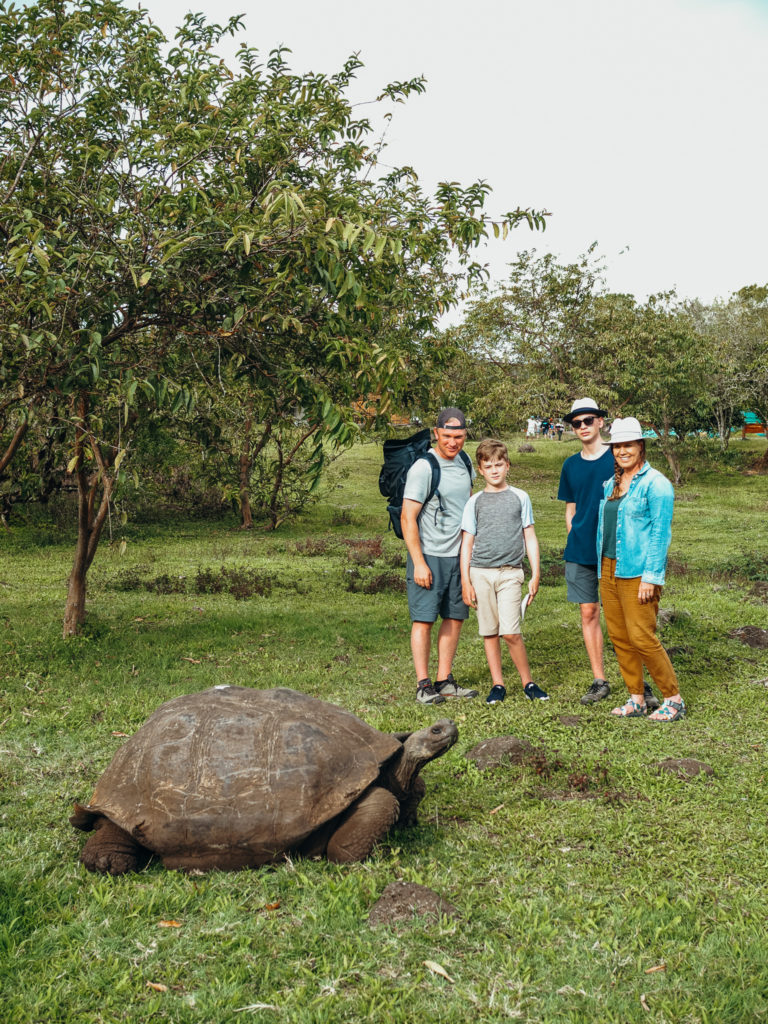
Another day while on Santa Cruz, plan on spending most (if not all) of the day at Tortuga Bay. It’s probably the most famous beach on the whole island and for good reason–it’s insanely gorgeous and offers a little of everything for beach and nature lovers. Here you will see plenty of wildlife such as marine iguanas, birds, sea turtles, rays, and even sharks! (Yes, we saw dozens of white tip reef sharks while snorkeling.)
To get to Tortuga Bay, you will need to go towards Puerto Ayora as this beach is close to the port city. Once there (you can take a taxi), it’s about a 1.5 hike from the road to the beach. Unfortunately, there is no parking right at the beach, but it is worth the hike! (*Tip: Bring plenty of water, food, towels and sunblock as there are no food vendors on the beach.)
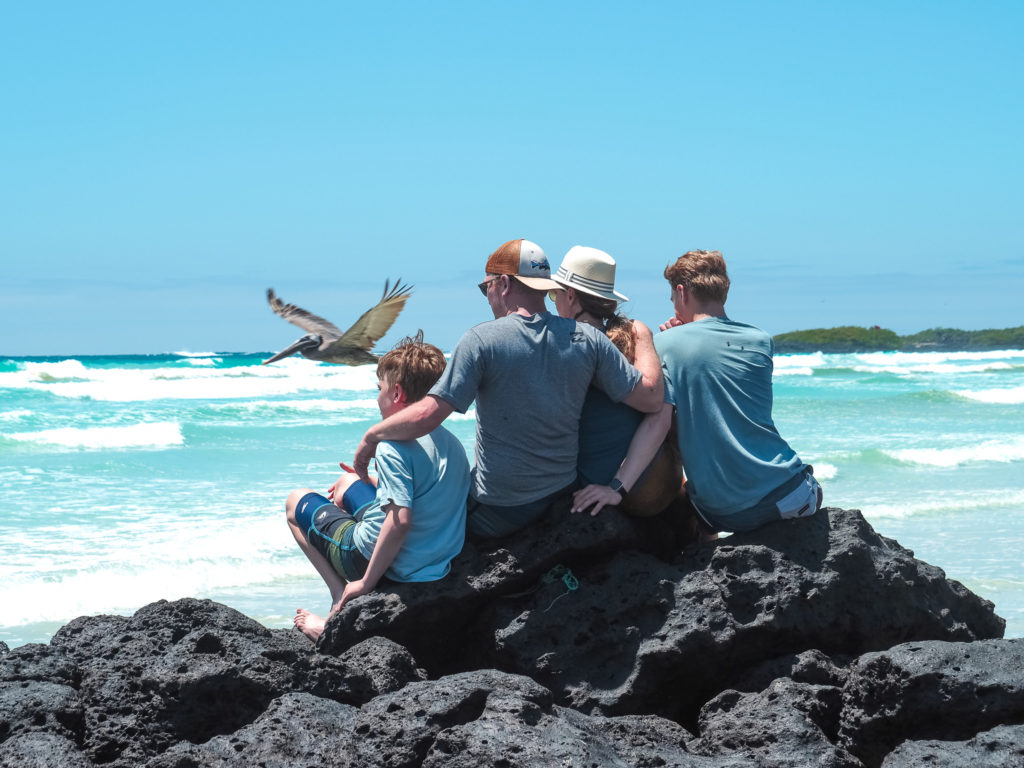
Once you arrive to Tortuga Bay, there are two beaches here. First is Playa Brava, the surf beach (best for more advanced surfers) and then Playa Mansa, which is protected and calm. To get to Playa Mansa, simply walk all the way across the main beach past the rocks until you reach the other beach. Mansa is beautiful too–turquoise green waters and white sand. There is more shade at this beach under the trees, and you can also rent kayaks and snorkeling equipment. The snorkeling here is amazing!
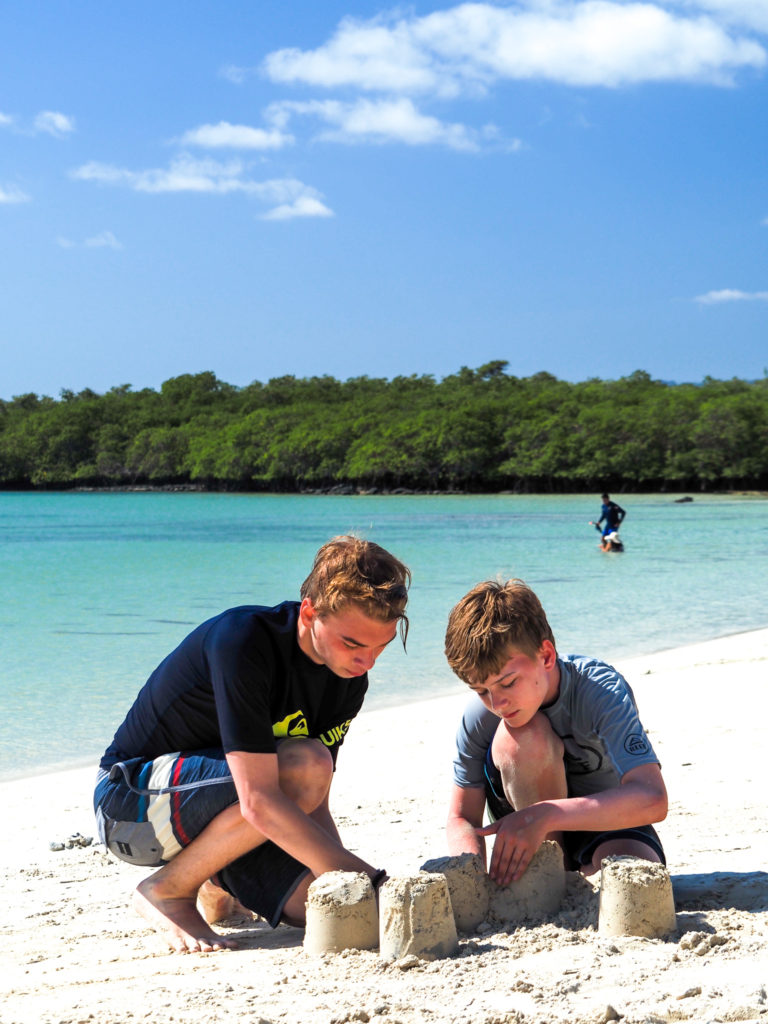
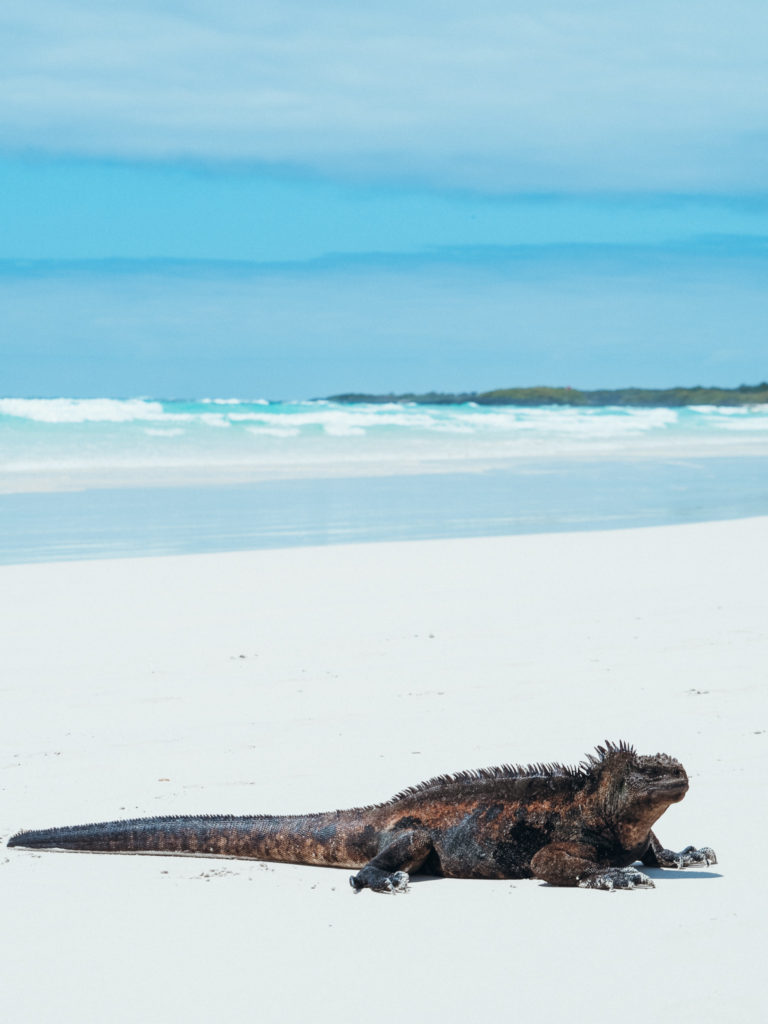
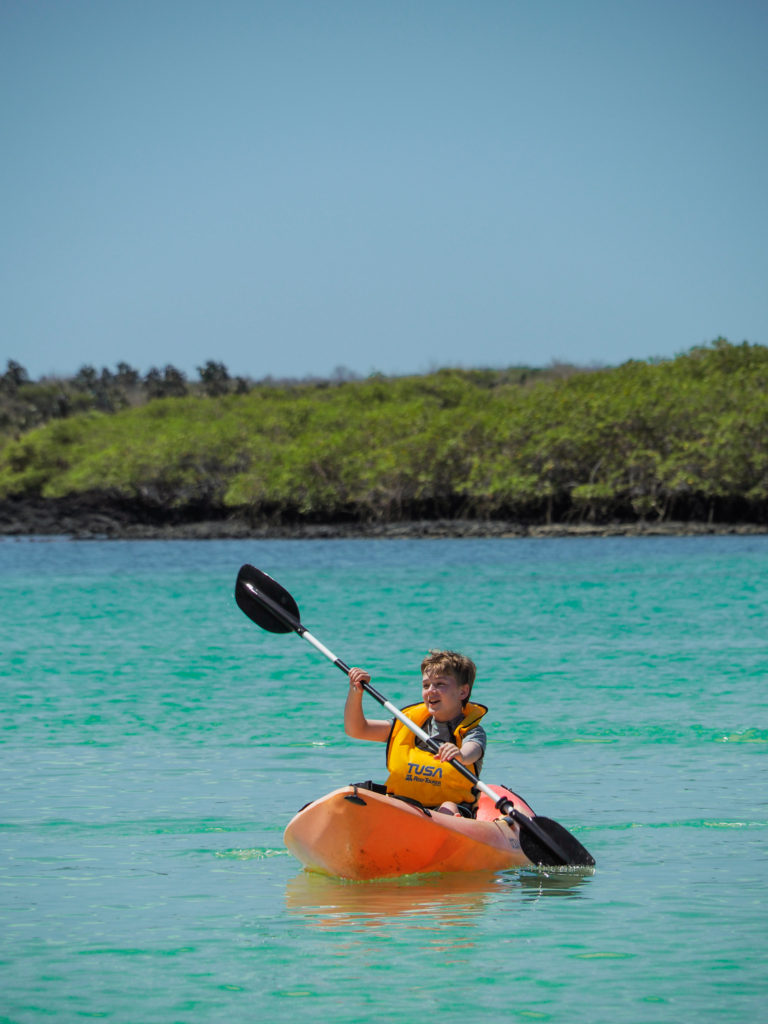

On the last day in Santa Cruz, we would suggest doing a few things around Puerto Ayora such as visiting the Charles Darwin Center, the Fish Market, snorkeling at Las Grietas, and if you have time, swimming at Laguna de las Ninfas. The Charles Darwin Center was founded in 1959 and dedicated to the preservation and conservation of the Galapagos Islands and the animals and plants that live there. It’s named after the famed British naturalist who visited the islands in 1835 and later made the Islands famous by using the Galapagos finches to illustrate his Theory of Evolution.
They have many projects going on at any given time, and it’s a very interesting and educational place to visit on Santa Cruz, especially with kids. Another must near Puerto Ayora is Las Grietas, a well-known local favorite spot for snorkeling. Las Grietas is a fissure in lava rocks that has created a series of narrow crevices filled with crystal clear water.
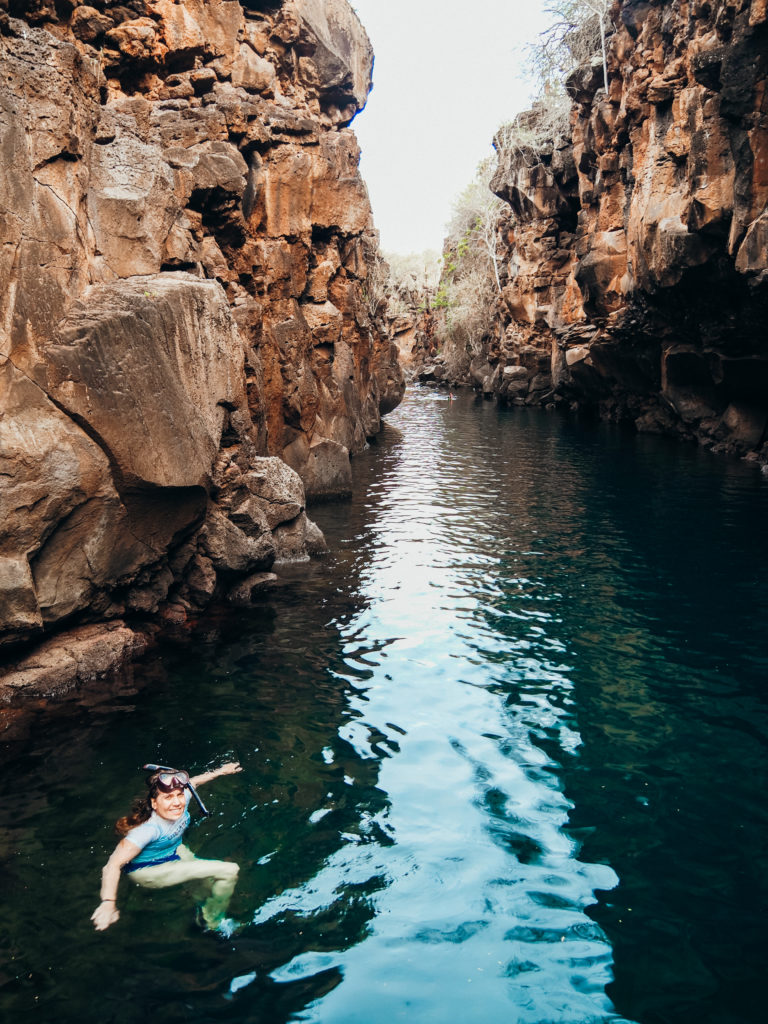
The water at Las Grietas is a mix of seawater that enters from one end, and freshwater that filters in from the other. The protected walls mean that the water is very calm, perfect for a relaxing swim. There is not much marine life to spot here, but there are plenty of other Galapagos wildlife along the path. Don’t miss the lookout or “mirador” along the trail that looks out over Academy Bay either–breathtaking!
If you end up spending more time on the island of Santa Cruz, there are a few more points of interest or activities/excursions we would highly recommend. If you are a beach lover, go to Playa El Garrapatero (there are flamingos!) or Las Bachas, another beautiful beach on the island. If you love snorkeling or diving, book a day trip to Gordon Rocks, one of the premiere spots to see hammerhead sharks and other marine life in the Galapagos. Another day trip option is to Island Bartolome, where you are likely to see penguins, sea lions, white-tipped reef sharks, and more.

We personally loved spending a few days on Santa Cruz before our cruise and then another few days on another island after the cruise, however you might plan your itinerary different to suit your needs (for example, choose to cruise first). As mentioned earlier, we booked our cruise through Galagents Galapagos Cruises, one of the top cruise operators in the islands. We went on the Eco Galaxy catamaran and honestly, we couldn’t recommend it enough. It was the absolutely the highlight of our entire trip to the Galapagos!
One reason we chose to cruise with Galagents is the fact that they are committed to environmentally- friendly practices. In fact, the owners and managers are 100% Galapegueños, so they are passionate about conservation of these islands and the wildlife therein. Everything they do is done with sustainability in mind!
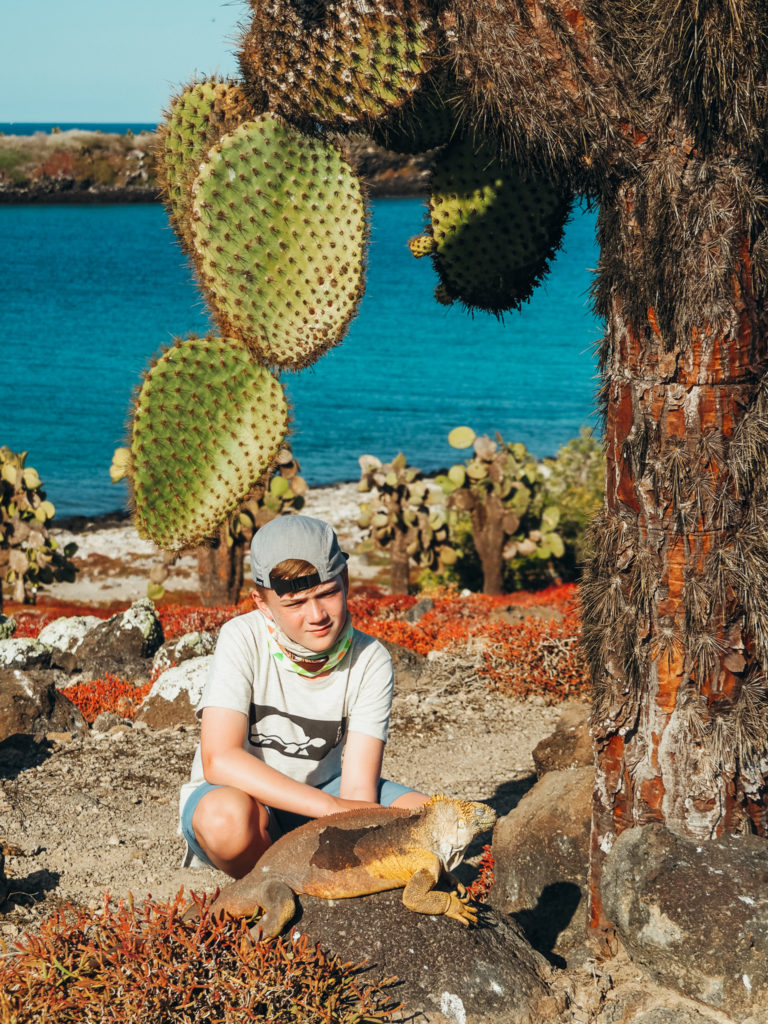
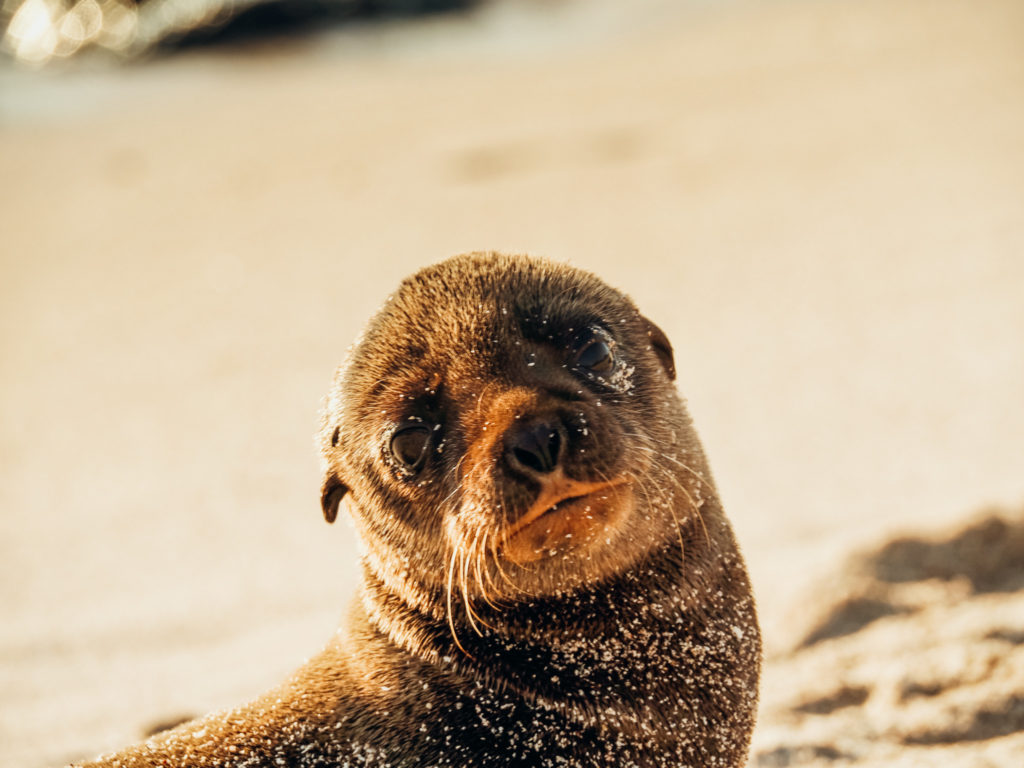
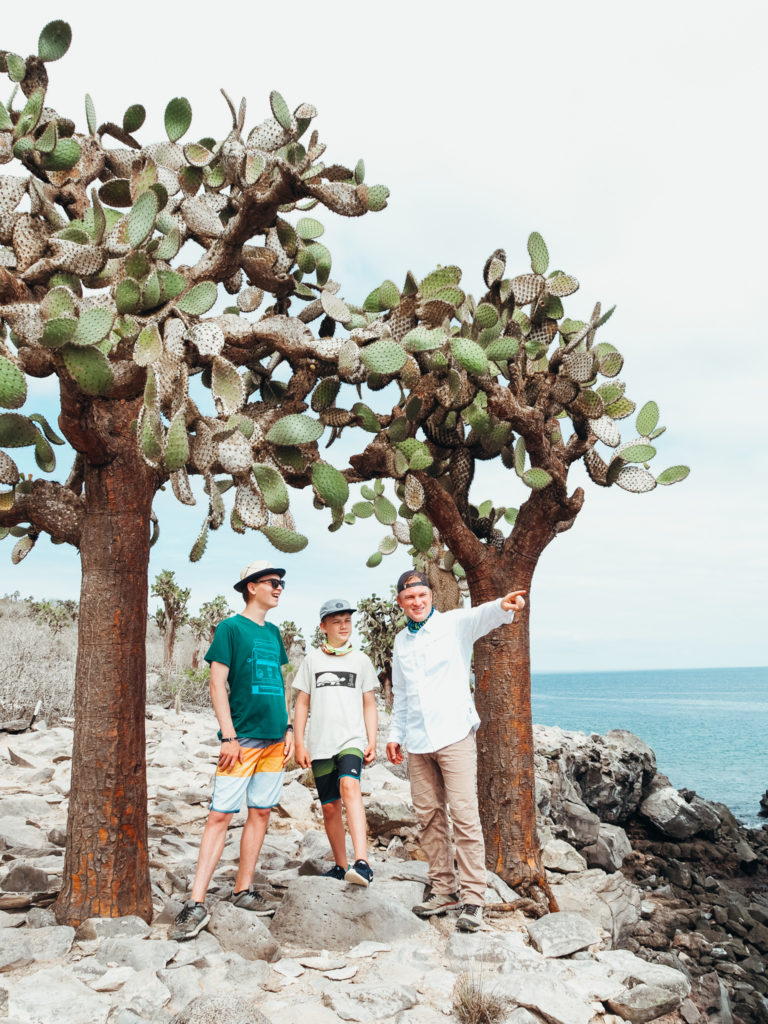
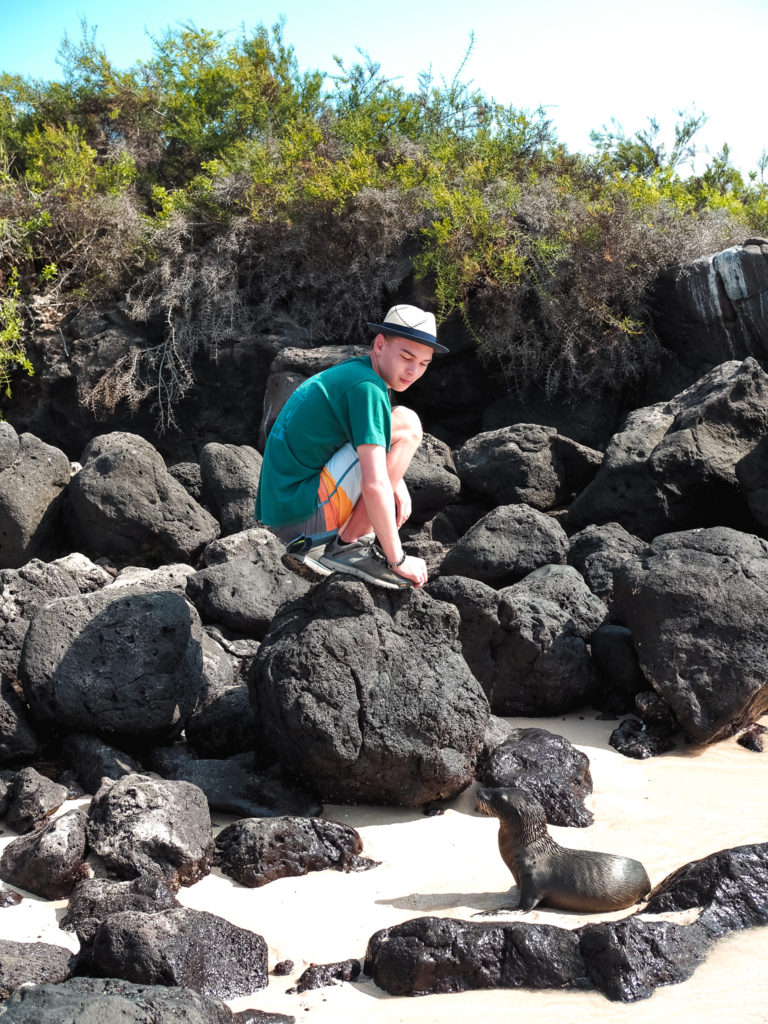
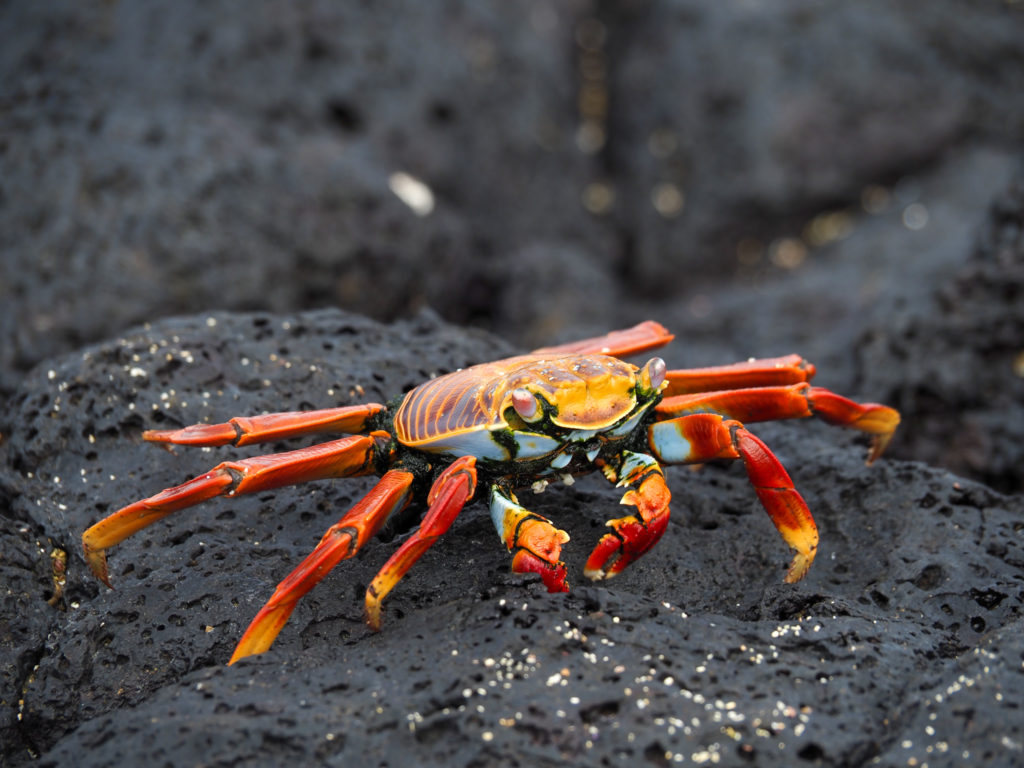
There are a few other really important reasons we chose to cruise with Galagents: one, they only operate small cruises. All of their cruises have a maximum capacity of 16 passengers or guests, plus about 10 staff members. We love this! This makes for a more intimate experience where you get to know the other guests on the ship. After 5 days living aboard the Eco Galaxy, we had made some great friends! (*Side note: You could book a cruise with 16 family members/friends and pay the same price and basically have your own chartered boat!)
Another perk of going with Galagents Galapagos Cruises is they offer different options in terms of length of cruises and prices. We did the 5 day/4 night cruise, but they offer 4 day up to 8 day options. Make sure to check out all the itineraries and different ships to find the best one to suit your budget and schedule. If you are traveling to the Galapagos during Covid times, it’s important to note that Galagents is following every precaution and biosecurity measure to ensure guests and staff are safe. You can read about Covid requirements to travel to the Galapagos here or here.

What’s included in your cruise with Galagents? Your own private room or cabin (with a bathroom), ALL meals and snacks, a guide, the use of wetsuits and snorkels, kayaks and/or paddle boards. Basically everything is included except alcoholic drinks, tips to the staff/guide, and of course, your transportation to and from the Galapagos. We loved the cabins–they were spacious, comfortable and each had windows with views.
The staff aboard the Eco Galaxy was outstanding, helpful and extremely friendly. Our guide spoke English and was very professional and knowledgable about the islands. In fact, our specific guide (from the Galapagos!) has been guiding for over 30 years! He guided us on both land and sea excursions.






Each day of the cruise starts out with breakfast promptly at 7AM. The meals are amazing! (Before your cruise, Galagents will ask you for your food preferences and allergies to make sure that your palette and needs are met to your specifications.) After breakfast, all guests are ushered off the boat and onto “pangas” which are small dingy-type boats to take you to various islands and land excursions.
Each day you will stop at different places of interests and landscapes. Depending on your schedule and itinerary, you might have longer travel times between destinations, however most of the “cruising” time happens at night while you are sleeping. This is great because it means more time on land to explore and spot wildlife, plus plenty of snorkeling and water based activities. Generally speaking, every day after breakfast is a land excursion for a few hours where you will walk/hike, and look for wildlife. The guide is very informative and entertaining too!

We observed different kinds of iguanas (some endemic to the Galapagos), frigate birds, blue-footed boobies, flamingoes, pelicans, swallow-tailed gulls, Darwin’s finches, red-billed tropic birds, and more. Of course, we saw plenty of sea lions lazily sun bathing on the beach, and even dozens of baby sea lion pups (we were there during birthing season). In addition, we also saw wild goats, snakes, crabs, giant tortoises, and more. The best part about coming to the Galapagos is you don’t have to look far or hard to spot wildlife–it’s right in front of you!
Probably the most significant thing about the wildlife in the Galapagos is they don’t fear humans–even the birds. They co-exist on these islands in peace and harmony because for hundreds of years the wildlife has been protected here, meaning they don’t feel threatened by humans! It was amazing to get close to the animals (no touching though!) and observe them in their natural habitat without them running or flying away.
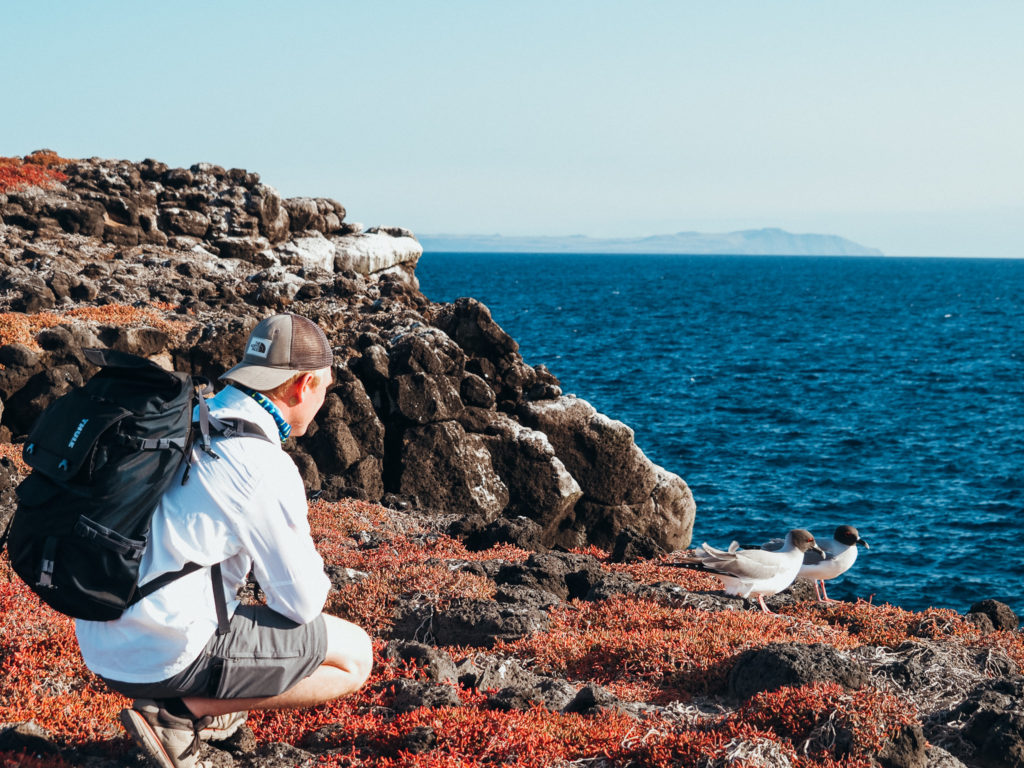
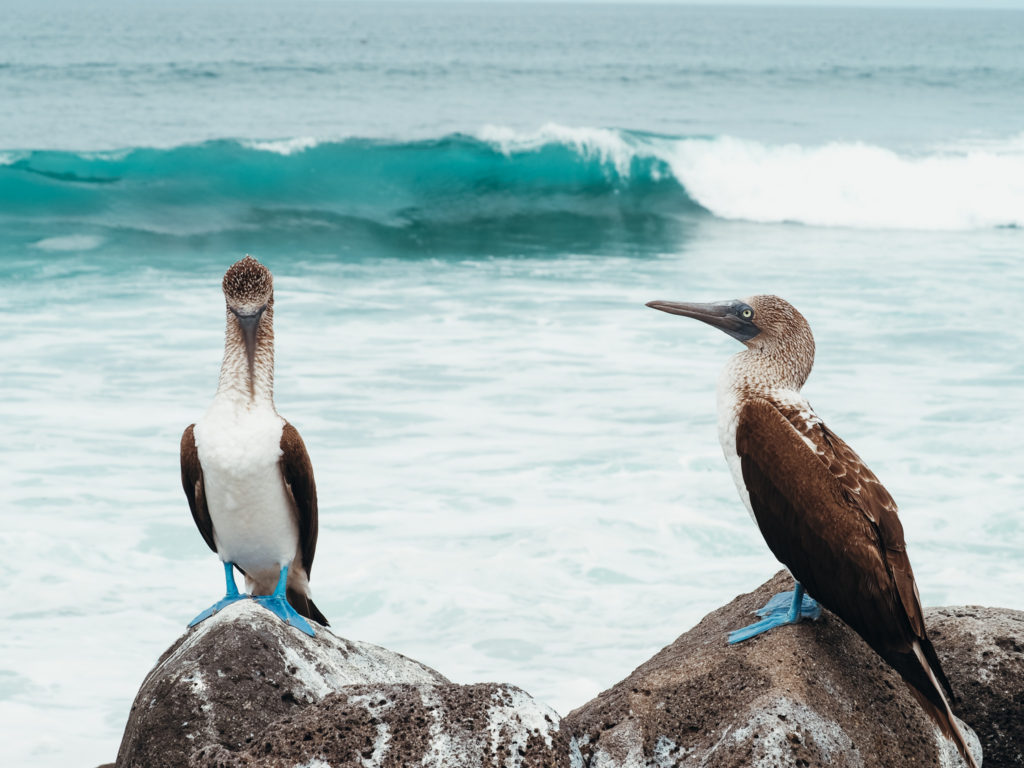
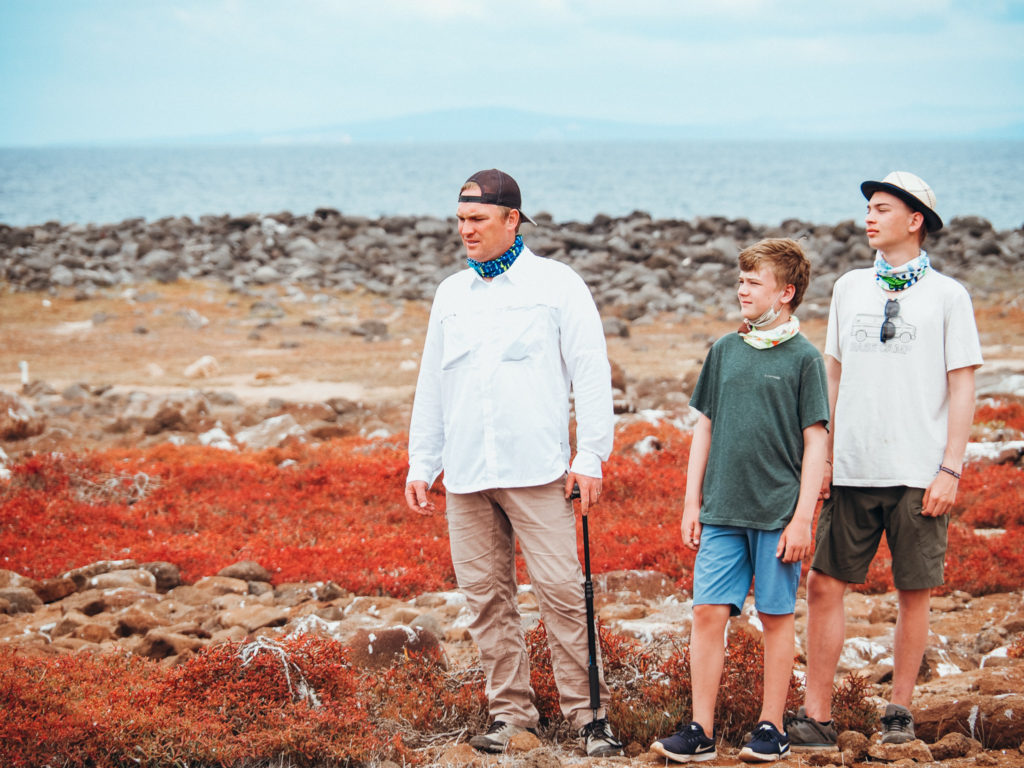
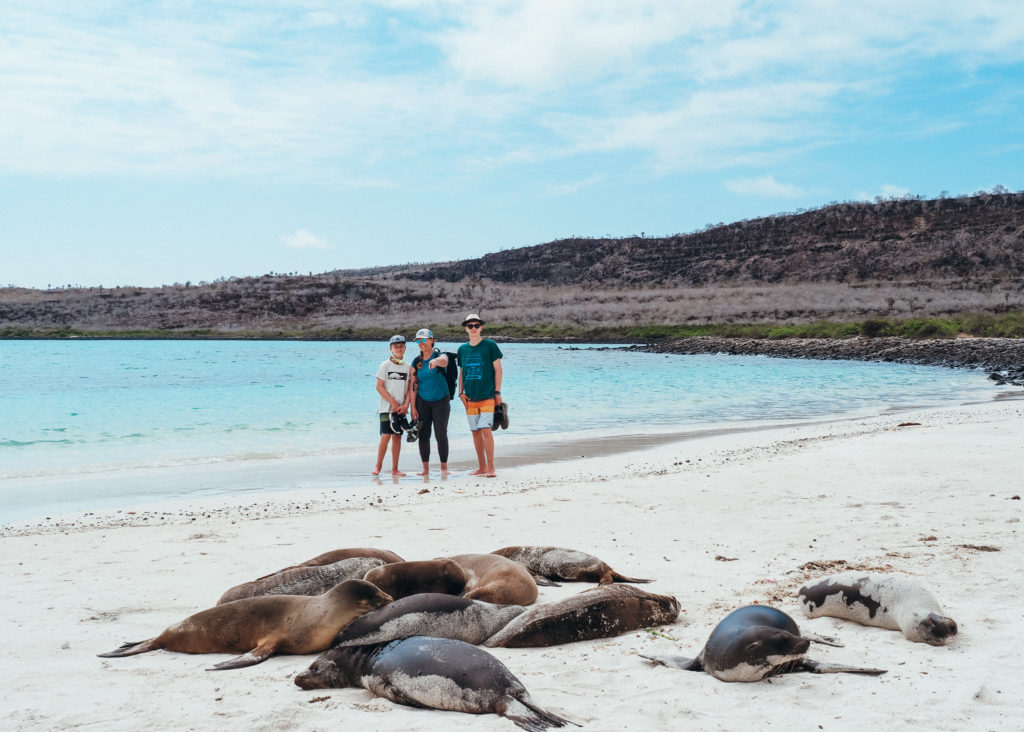
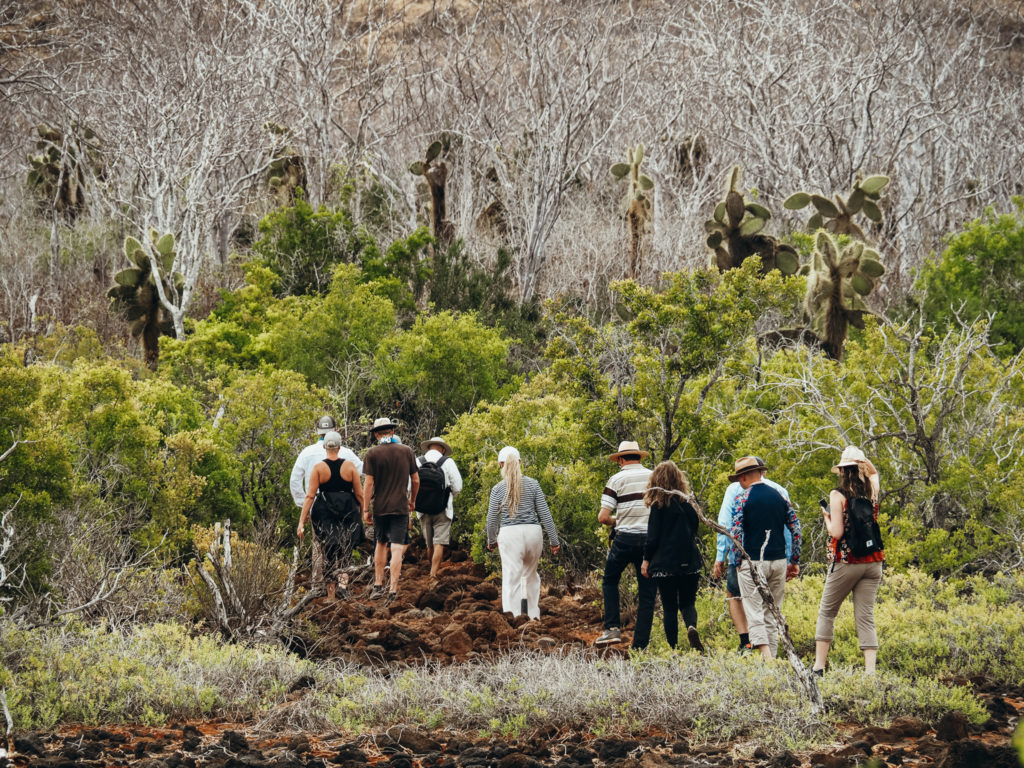
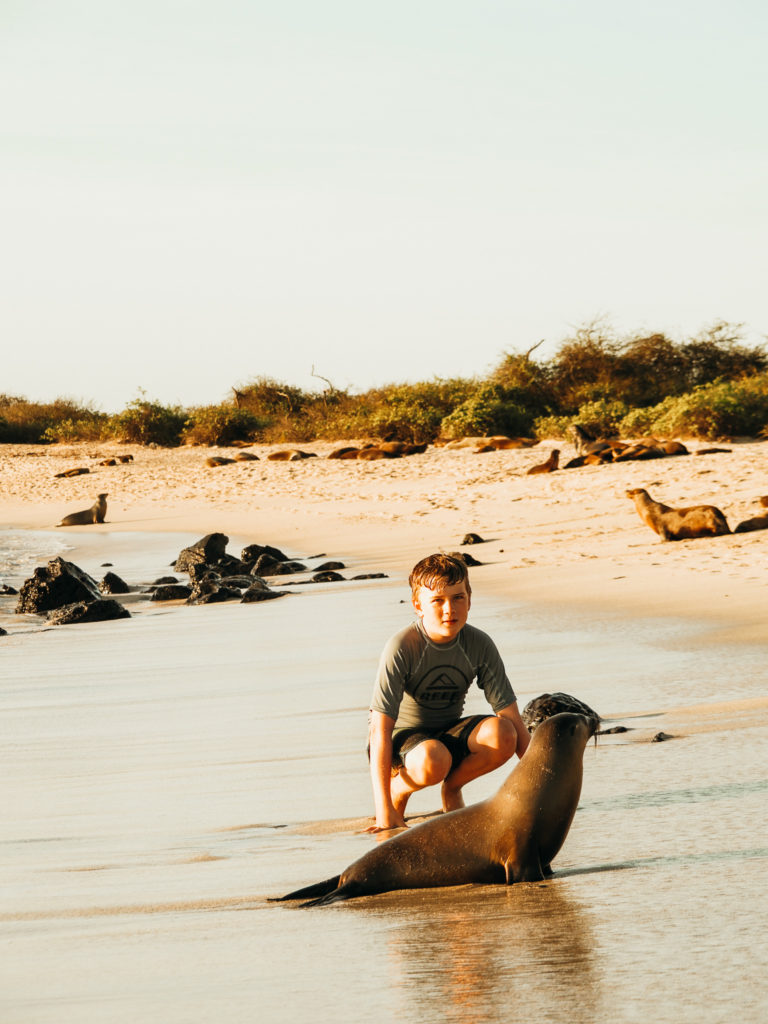

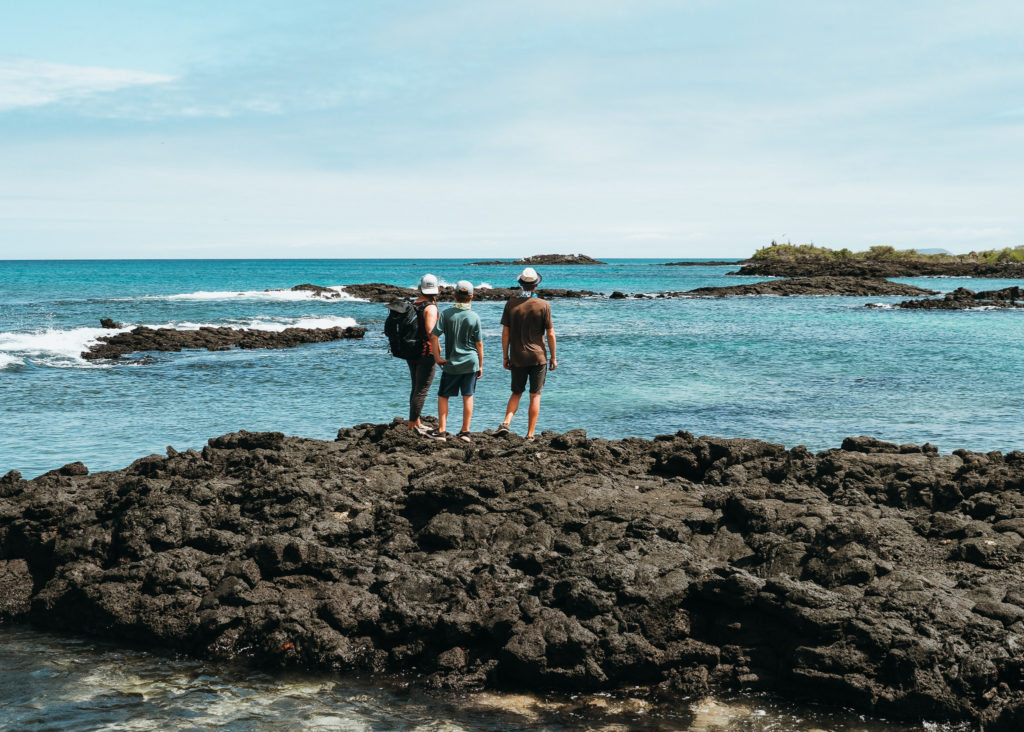


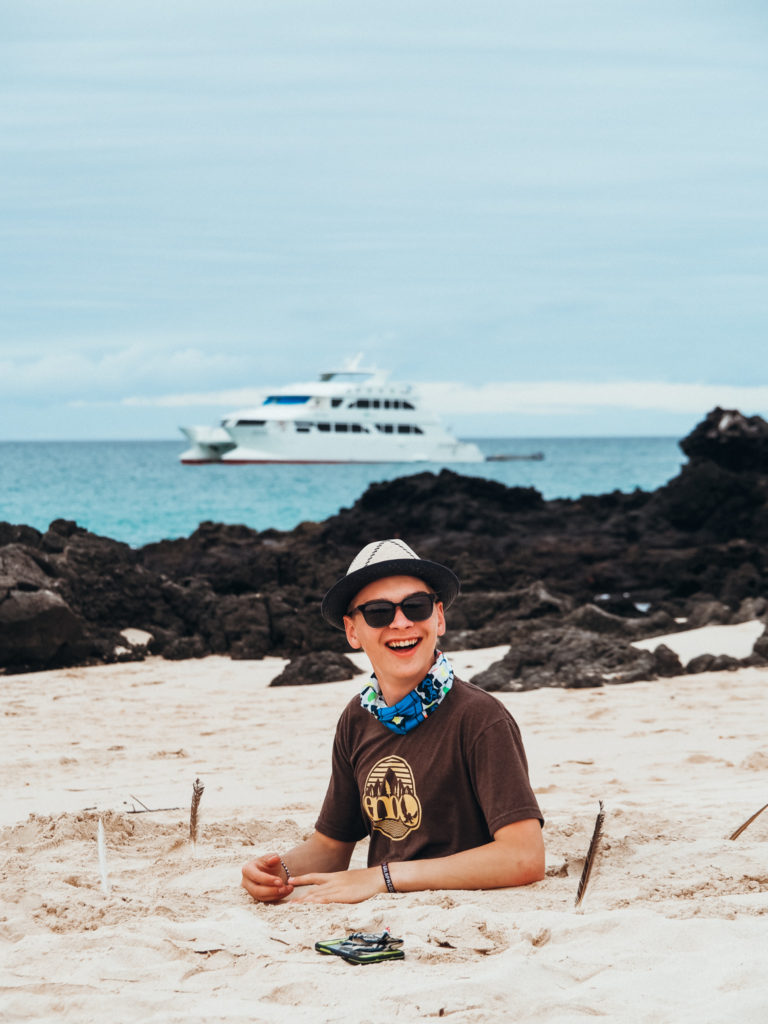
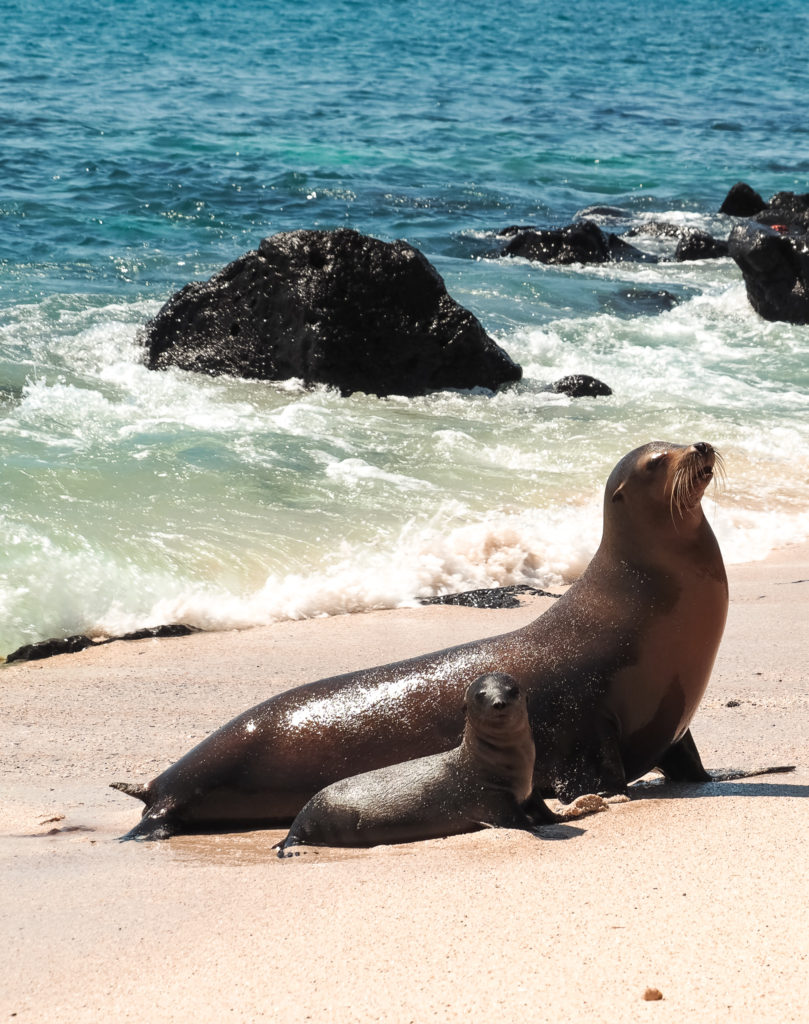
Typically after a land excursion with Galagents, the pangas will take you back to the ship where you will eat lunch and have some down time on the boat before heading out for a sea excursion in the afternoon. Some days depending on the length of the land excursion though, you might do a sea excursion first, then have lunch and head to a different island for another land excursion later in the day. It is all dependent on your itinerary and schedule. Every day we had a sea excursion where we would suit up in our wet suits and head out on the pangas to various snorkeling spots.
You might be asking, “You had to wear wetsuits?” If you come to the Galapagos between June and November, the water can be chilly so a wetsuit is preferred. Between Dec and May though, the water is warmer and wetsuits might not be needed.
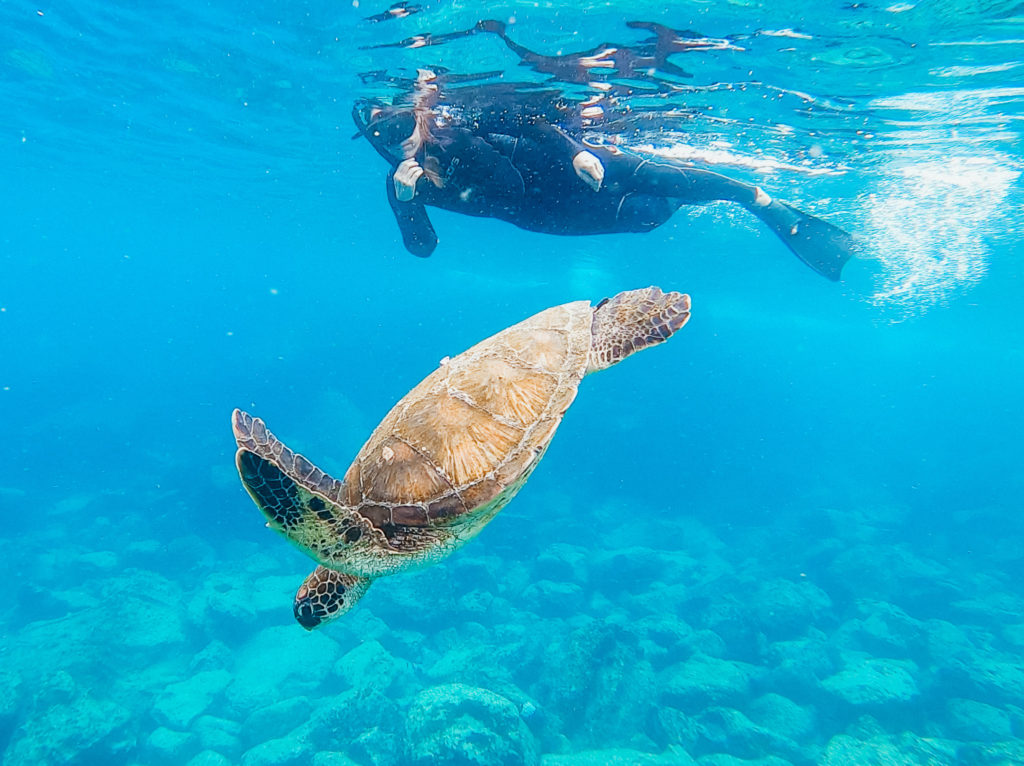
As amazing as it was to see all the incredible land animals, swimming with the marine life was the best part of each day on the cruise with Galagents. Every day you are guaranteed to see a plethora of marine animals and tropical fish–from sea turtles, marine iguanas, sting rays and eagle rays, sea lions, and even sharks. Luckily the sharks in the Galapagos are not a threat to people. They were absolutely exhilarating to see!
We saw several white tip reef sharks, hammerheads, and even a Galapagos shark. The sea lions were probably our favorite though because they are so playful and curious. We loved watching them gracefully and swiftly swim around us–they would even come up to our GoPro!

Each day on our cruise with Galagents, we would end with a breathtaking sunset (sometimes watched on land, other times on the ship) which was such a treat after an amazing day! Dinner was usually served after sunset and then you had time to lounge, play games, or watch a movie. The last night of our cruise, the entire staff aboard Eco Galaxy dressed up in pirate attire and we had a dance party. Perfect way to end the cruise!
As mentioned above, our cruise in the Galapagos with Galagents was the highlight of our trip on these islands. In fact, I would dare say that it was one of our favorite trips EVER! Living aboard a boat and cruising around the Galapagos is absolutely the best way to really experience these enchanting and unique islands because you see a side of the Galapagos that most don’t see. You get off-the-beaten-path and have a once-in-a-lifetime adventure that the whole family will never forget.

If you choose to spend 7 or 10 days in the Galapagos Islands (and part of that is on a cruise), then disregard the following. However if you are able to stay a few extra days on the islands (or forego the cruise and split your time between 2 different islands), we would highly recommend hopping over to San Cristobal. We spent the last 3 days of our trip on this island and it was equally as magical as Santa Cruz, yet different.
In order to get to San Cristobal, you must take a ferry from Puerto Ayora (the most economical way), or book a flight on a small puddle jumper plane (more expensive). It’s important to note that the ferry typically only makes trips 2 times per day from Santa Cruz to San Cristobal. With that said, you need to plan accordingly and book ahead since the ferries only have limited capacity. The ferry usually leaves around 7AM and then again later in the afternoon, around 3PM.

The ferry costs around $35 per person (children under 10 are $17) and takes about 2-2.5 hours to get there. Once you arrive to the island of San Cristobal, you will be in the main port town of Puerto Baquerizo Moreno. Be prepared to see lots of sea lions when you disembark all over the dock, pier and benches! They rule the town here!
Most accommodations are in the town and the good news is you can find fairly economical hotels too–we loved staying at the Cactus Hotel. It only cost about $50/night for our family and included breakfast! Make sure to use Booking.com to view all of the options for your budget in San Cristobal.

One thing you must do on the island of San Cristobal is visit some of the beaches here. We absolutely loved Punta Carola, Playa Baquerizo and Puerto Chino for just relaxing and swimming. We also loved La Loberia, although this is an advanced surf beach so likely you won’t swim here. It’s a beautiful rocky beach and sunsets are fabulous here. Same with on Punta Carola, so don’t miss watching a sunset on either of these beaches!
Another beach that is worth visiting on San Cristobal is Cerro Tijeretas which is located about 1 mile from the Interpretation Center (you can hike there from town). It is the ideal place to enjoy a spectacular view of white sand beaches on one side and the roofs of Puerto Baquerizo on the other. This beach offers a diverse array of flora, and is safe snorkeling and swimming.

You could easily spend a couple of days just hitting up the beaches of San Cristobal, but if you want a little more adventure and want to see some more remote places on or near the island, there are a few day trips we would highly recommend. The #1 day trip on San Cristobal we suggest is to Kicker Rock (Leon Dormido). It’s also a popular day trip but due to strict regulations in the Galapagos, you won’t see many other tour operators there all at the same time.
A few important things to note: There are many tour operators in town that promote a “360 tour” of San Cristobal which includes various activities and sights of interest around the island, however we were told by several locals to skip that tour and just choose the day trip to iconic Kicker Rock. Why? Because you get more time at Kicker Rock to snorkel and enjoy this incredible rock structure, plus spend time at a beautiful remote beach nearby. Let’s just say we made the right choice. Our day at Kicker Rock ended up being one of our favorite days in the Galapagos.

We chose the tour company Wreck Bay, as they came highly recommended by a guide and scuba diver from Santa Cruz. They did not disappoint. We started the day early at their shop and then boarded a boat to take us to Kicker Rock. After about an hour boat ride, we arrived to this infamous rock. Our guide taught us about the wildlife and marine life that lives here and then we prepared to go snorkeling.
We then got in the water to snorkel on one side of the rock and were amazed at the marine life, as well as the coral and other organisms that exist on the rock. We’ve never seen such colorful and healthy coral! In addition to the coral and fish, we observed sea lions, hammerhead sharks, sea turtles and even an eel! After about an hour of snorkeling, we got back in the boat and the captain took us all around the island so we could get different views and perspectives of Kicker Rock.
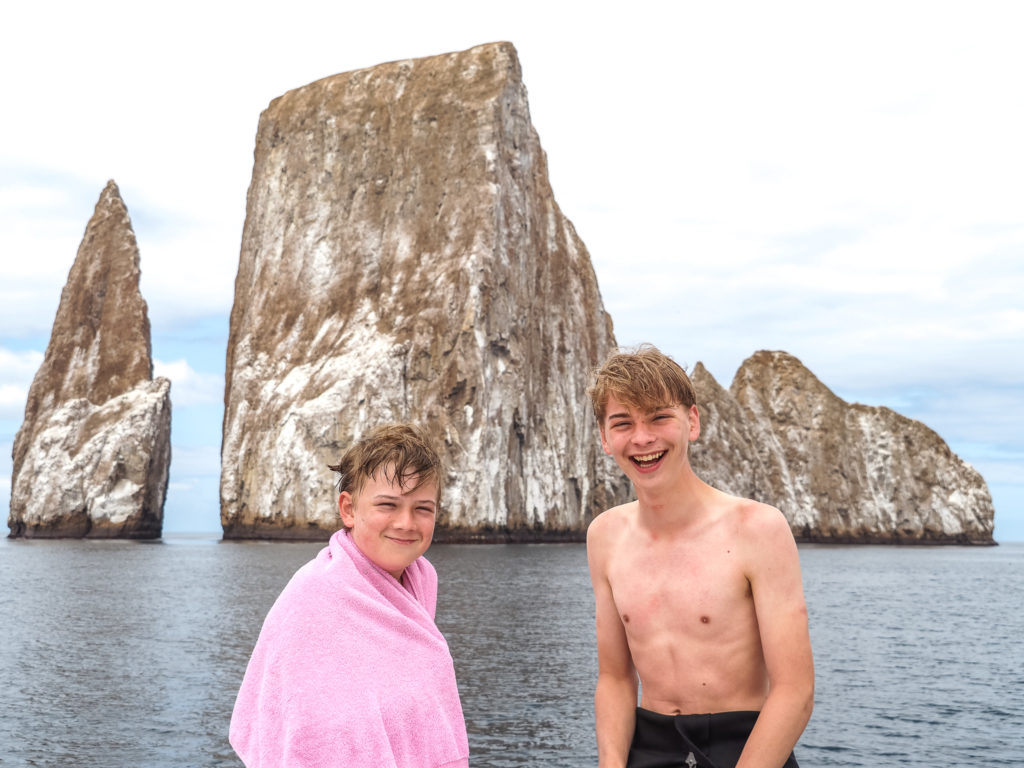
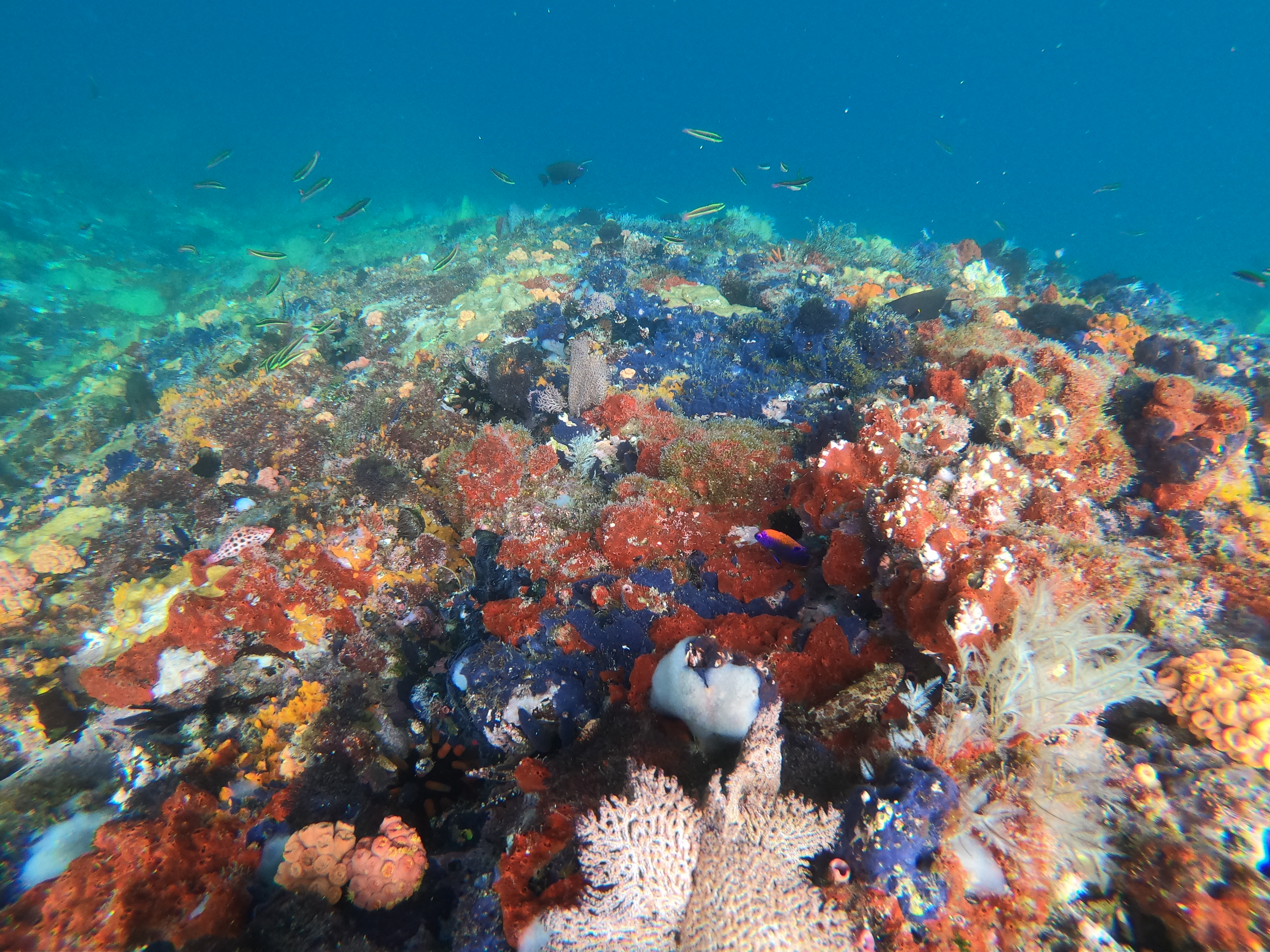
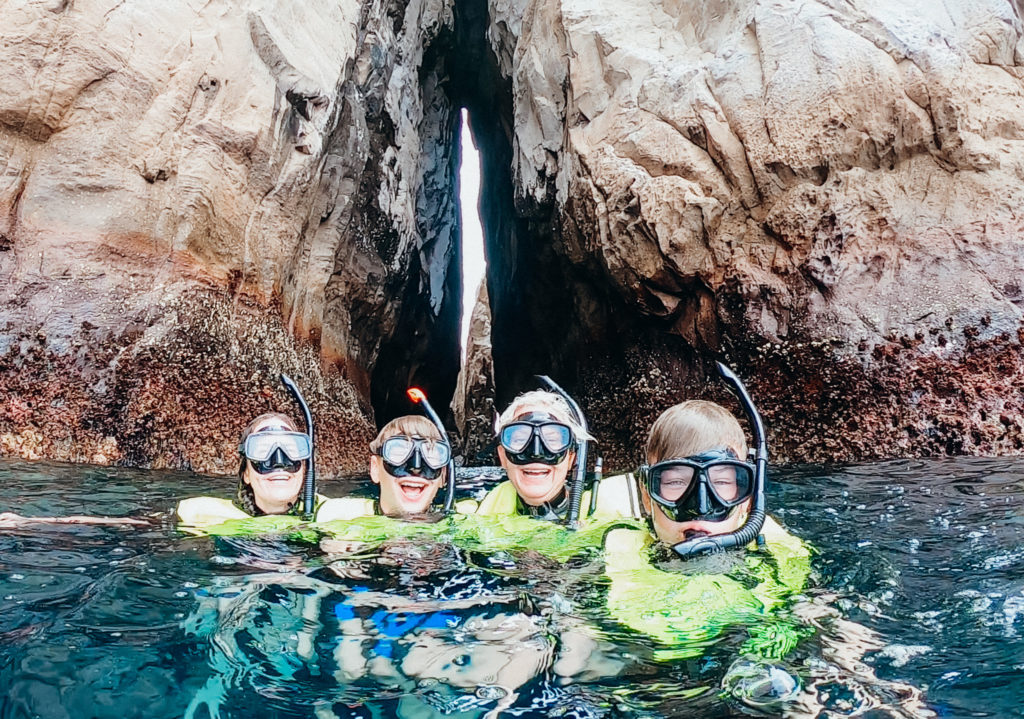
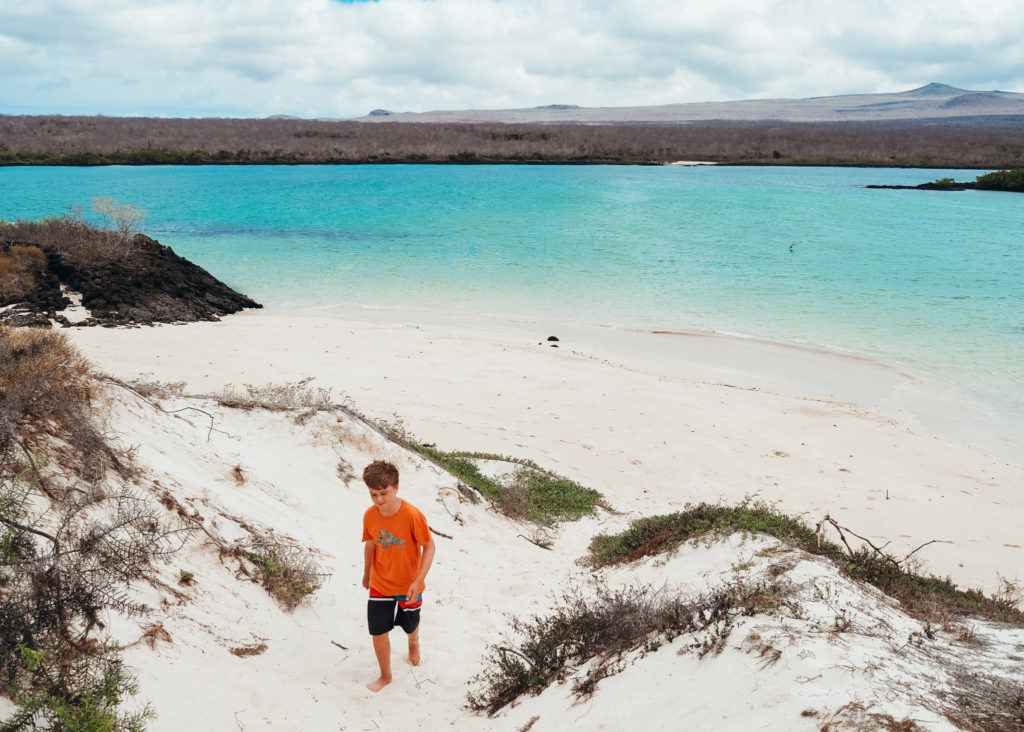

Then we got back in the water and snorkeled for another hour or so. Basically we made our way around the entire Kicker Rock and even snorkeled between the two rocks. It was awesome! This tour cost about $120/person and included snorkeling equipment, a wet suit and lunch. After we finished snorkeling at Kicker Rock, the boat dropped us off at this gorgeous, remote beach where we relaxed, swam some more with sea lions and took photos. Such an unforgettable day!
If you find that you have more time on San Cristobal, there are some other great day tours that include a trip to Espanola Island (a popular place to see blue footed boobies), Junco Lagoon, Punta Pitt, and La Galapaguera Tortoise Habitat (if you haven’t had your share of giant tortoises yet).
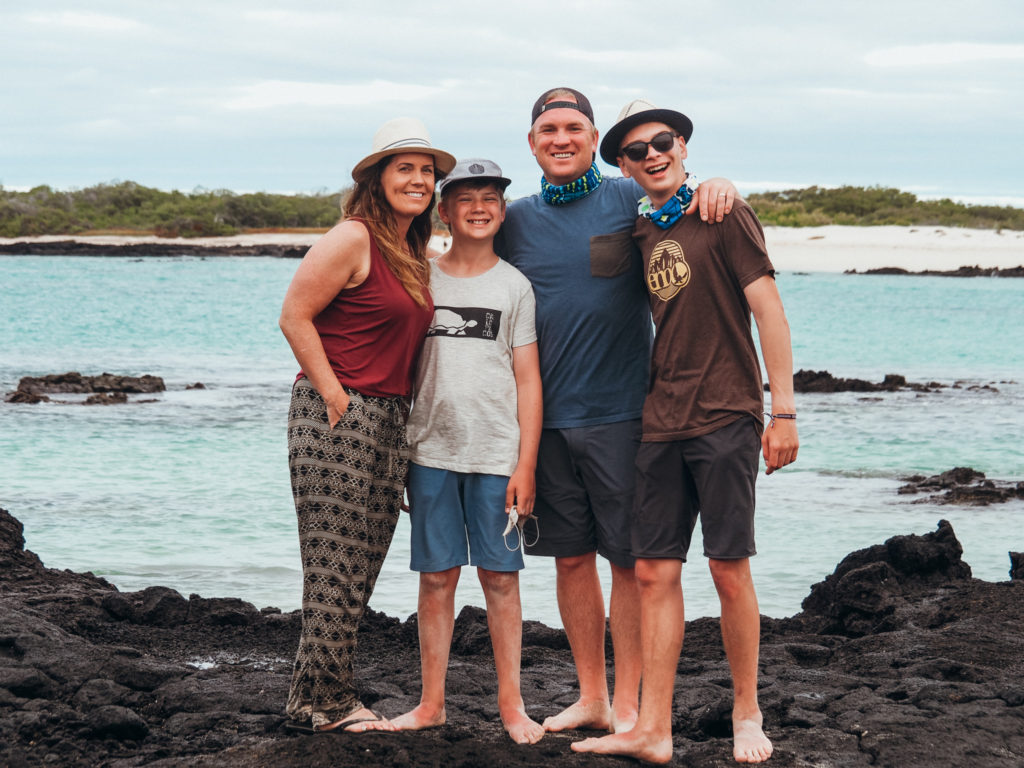
The Galapagos Islands is one of the most special and unique destinations in the world and the ultimate trip with kids. If you’re a nature and wildlife enthusiast, this will be one place that you will want to return to over and over again. It might be a little more expensive than other destinations in South America, but trust us, it’s 100% worth the splurge.
Do you have the Galapagos on your bucketlist?